

































































































































































































































































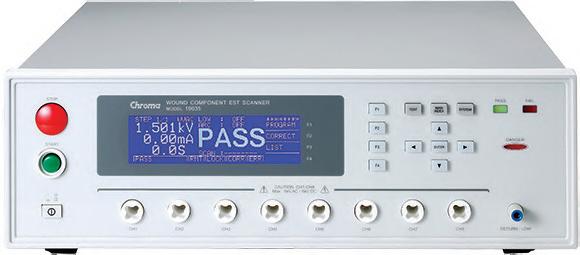

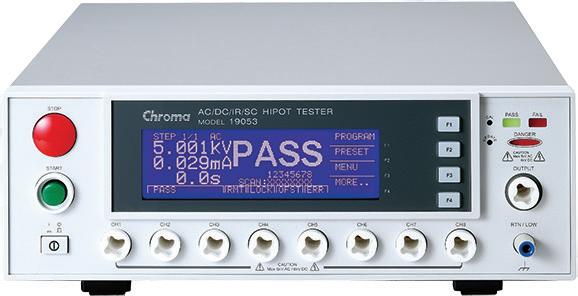











































































































































































































































































Magnachip introduces TOLT-packaged MOSFET for EVs
Wacker announces extrudable silicone for EV busbar insulation
imc Test & Measurement launches high-isolation temperature module
TotalEnergies and XING Mobility partner on immersion cooling battery tech
Eaton supplies SQ8 high-power connector for vehicle platform

MAHLE begins e-compressor production in Tennessee
BRUSA HyPower launches heavy-duty on-board charger and DC-DC converter
Rimac Technology debuts next-gen systems for high-performance EVs
Vishay unveils high-temperature DC-link capacitors for EV power electronics
Europe’s EV battery passport will bring transparency to the battery industry
Flux Power lands $1.2-million order for ground support equipment batteries
Dürr Systems debuts two-sided simultaneous electrode coater
AM Batteries helps battery OEMs calculate dry electrode manufacturing savings


Thermo King introduces new heat pump for electric buses
Toshiba launches 650 V SiC MOSFETs in TOLL packages
Lucid drops a few more details on future midsize models
Revel decides to exit the rideshare business
Australia Post pilots Mercedes-Benz eVito electric vans
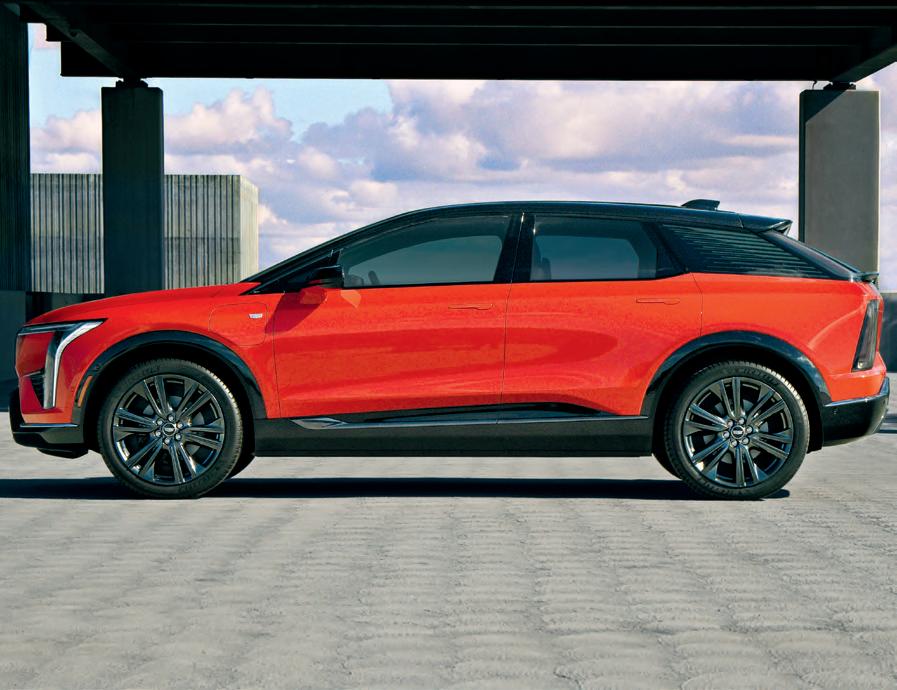

Daimler Buses delivers eCitaro electric buses plus charging infrastructure
DPD tests electric Terberg tug at UK delivery hub
GreenPower to develop New Mexico electric school bus pilot program
Soaring electric truck sales cut into diesel consumption in China
MAN Trucks launches series production electric semis, rolls out charging cubes
New York state announces $200 million in funding for electric school buses
Suffolk County Transit orders 132 electric and hybrid buses from NFI Group
National construction company deploys its 100th Chevrolet Silverado EV
Chevrolet Silverado EV achieves world-record 1,059 miles on a charge
Joby to acquire Blade air taxi passenger operations








Arcady Sosinov on charger reliability, credit card readers and the impending industry shakeout
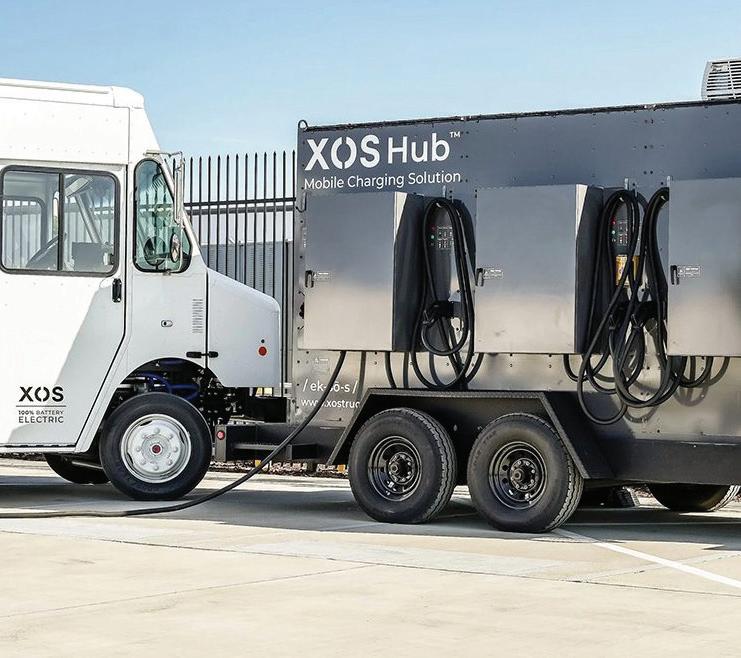
What’s going to happen to the NEVI EV charging infrastructure program?
ChargePoint and Eaton launch V2X-capable EV fleet charging system
EV Realty and Prologis Mobility connect charging hubs for commercial fleets

FRYTE Mobility debuts e-truck charging process with automated reservations
Greenlane establishes new I-10 electric truck charging corridor
Xos mobile EV charging unit now available for under $100,000 with incentive Ford Charge network launches with fast charging stations at 320 dealerships
Nissan and ChargeScape announce new vehicle-to-grid pilot
Designwerk achieves 1.1 megawatt EV charging of heavy-duty trucks
Shell launches integrated EV charging network for heavy-duty fleets in Europe
Tellus Power introduces two new 600 kW DC fast EV chargers


Siemens invests in home energy management provider Emporia Energy
Lincoln Electric introduces 50 kW mobile DC fast charger for EV fleet operations
Electric Era installs 200 kW battery-backed EV chargers in just 54 days
J.D. Power finds public EV charging infrastructure is becoming more reliable
Orange EV and Optigrid unveil battery-integrated DC fast charger
ABB’s new energy management system helps avoid expensive panel upgrades


Publisher
Senior Editor
Technology Editor
Segment Leaders
Christian Ruoff
Charles Morris
Jeffrey Jenkins
Joel Franke
Mark Rogers
Jeremy Ewald
Graphic Designers
Tomislav Vrdoljak
Contributing Writers
Jeffrey Jenkins
Charles Morris
Christian Ruoff
Jonathan Spira
Nicole Willing
John Voelcker
Cover Image Courtesy of
Special Thanks to
General Motors
Kelly Ruoff
Sebastien Bourgeois
ETHICS STATEMENT AND COVERAGE POLICY
For Letters to the Editor, Article Submissions, & Advertising Inquiries Contact: Info@ChargedEVs.com
AS THE LEADING EV INDUSTRY PUBLICATION, CHARGED ELECTRIC VEHICLES MAGAZINE OFTEN COVERS, AND ACCEPTS CONTRIBUTIONS FROM, COMPANIES THAT ADVERTISE IN OUR MEDIA PORTFOLIO. HOWEVER, THE CONTENT WE CHOOSE TO PUBLISH PASSES ONLY TWO TESTS: (1) TO THE BEST OF OUR KNOWLEDGE THE INFORMATION IS ACCURATE, AND (2) IT MEETS THE INTERESTS OF OUR READERSHIP. WE DO NOT ACCEPT PAYMENT FOR EDITORIAL CONTENT, AND THE OPINIONS EXPRESSED BY OUR EDITORS AND WRITERS ARE IN NO WAY AFFECTED BY A COMPANY’S PAST, CURRENT, OR POTENTIAL ADVERTISEMENTS. FURTHERMORE, WE OFTEN ACCEPT ARTICLES AUTHORED BY “INDUSTRY INSIDERS,” IN WHICH CASE THE AUTHOR’S CURRENT EMPLOYMENT, OR RELATIONSHIP TO THE EV INDUSTRY, IS CLEARLY CITED. IF YOU DISAGREE WITH ANY OPINION EXPRESSED IN THE CHARGED MEDIA PORTFOLIO AND/OR WISH TO WRITE ABOUT YOUR PARTICULAR VIEW OF THE INDUSTRY, PLEASE CONTACT US AT CONTENT@CHARGEDEVS.COM. REPRINTING IN WHOLE OR PART IS FORBIDDEN EXPECT BY PERMISSION OF CHARGED ELECTRIC VEHICLES MAGAZINE.
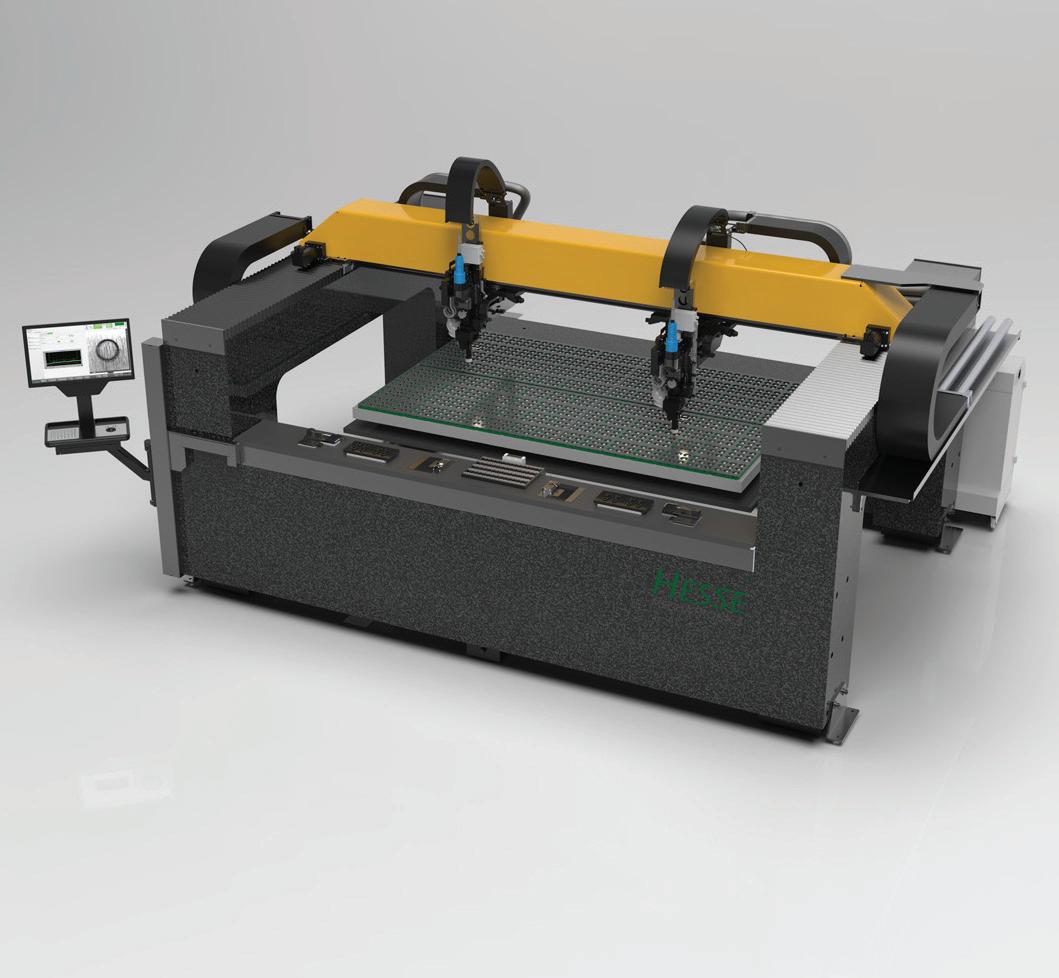
www.hesse-mechatronics.com



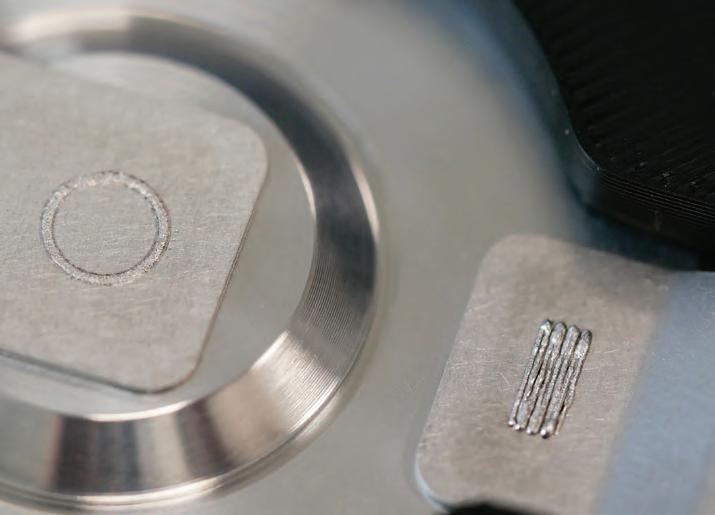





















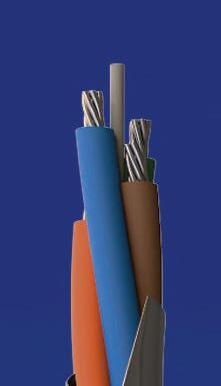

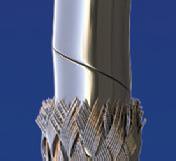














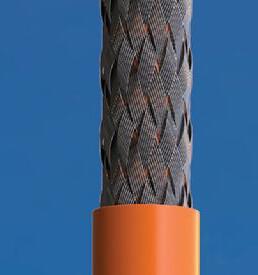




























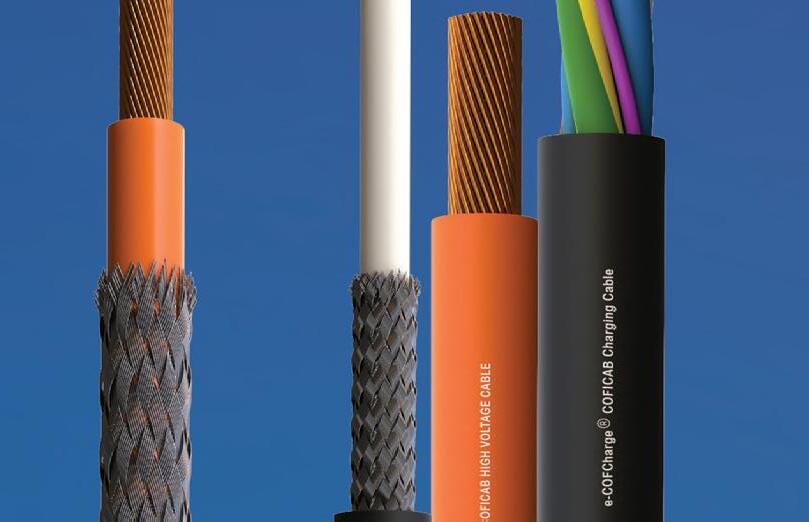










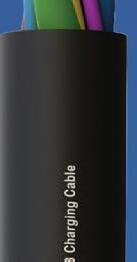


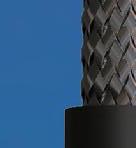




























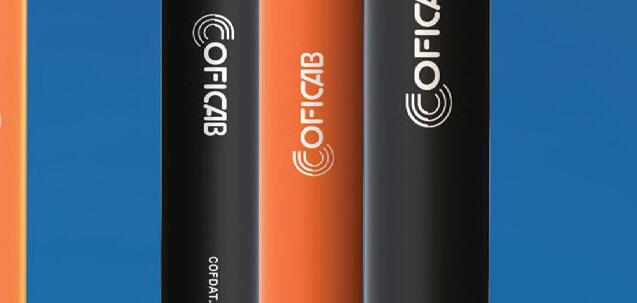

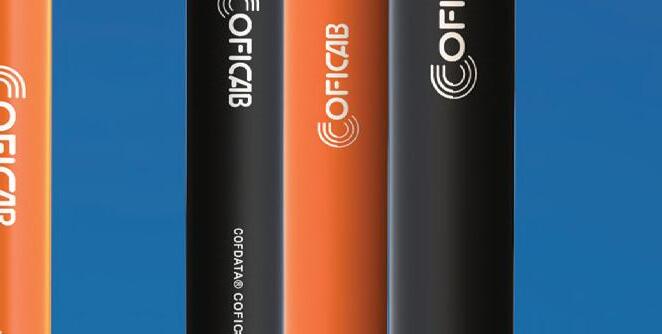



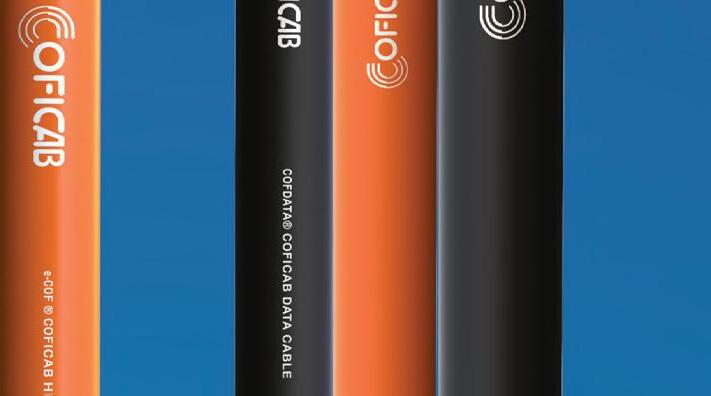




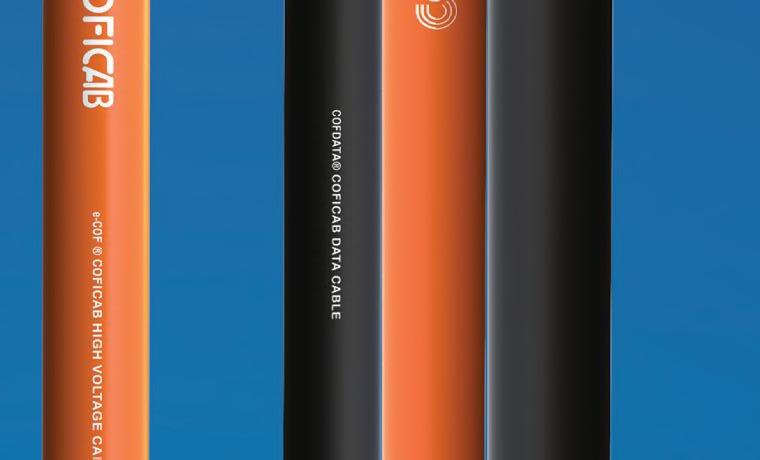












Does it seem to you that everybody and their dogs are selling EV chargers these days? It’s not your imagination—we recently tried to make a list of companies o ering chargers, and stopped counting at 100. (How many are manufacturers, and how many are reselling white-label products? Who knows?)
Every company that makes anything with a cord seems to have launched a line of Level 2 chargers. Out ts known for everything from utility-scale electrical equipment to residential lighting to consumer electronics to power tools have gotten into the EVSE game. Why so many?
For one thing, a Level 2 charger is (in theory) a simple device. Regular Charged readers know that quality designs, however, aren’t that simple. A lot of chargers for sale on Amazon and other mass-market outlets are shoddy products that haven’t been tested for safety by any reputable organization. If you’d prefer not to burn your house down, simply don’t buy anything that is not tested and certi ed by a Nationally Recognized Testing Laboratory, like UL, ETL (Intertek), CSA Group or TÜV. at said, building a basic EV charger isn’t that challenging for a competent engineer, and therein lies the making of a bubble. Other than adding fancy features, or designing a really cool-looking enclosure, there are few ways to di erentiate your product other than by slashing your price. Low-margin segments tend to shrink to a small number of very large players, and that’s just what execs in the EV industry have been predicting for the last year—a shakeout is on the way at all levels of the charging industry, or has already begun.
Tritium was one of the rst big dominos to fall, as Arcady Sosinov, the company’s new CEO, told us (see page 74). In 2024, the company got overextended and became insolvent, but it had such a large installed base that it was well worth saving, and Indian power management company Exicom stepped in and reorganized.
Even as we were speaking with Sosinov, other dominos were falling. He estimates that the industry can support no more than half a dozen global high-volume suppliers of DC fast chargers for public and eet charging hubs. And the market for Level 2 residential chargers is similarly crowded, and is seeing a similar shakeout.













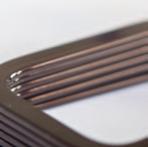











What about charge point operators? at’s a much more complex business than building chargers, but one that also has low margins—and a low level of customer satisfaction at the moment. We’ll likely see major consolidation there too.








In the end, creative destruction will be a positive thing for the industry (and some Nietzscheans believe the end of government support will also make us stronger). But things are going to start changing fast, and in unpredictable ways. What if freight haulers decide they’d rather electrify their trailers than shell out big money for electric Class 8 trucks? (See page 57). What if the centers of EV adoption shi to so-called developing countries? (See page 82).
Christian Ruoff |
Publisher EVs are here. Try to keep up.



South Korea-based Magnachip Semiconductor has released its new 80 V MXT MV MOSFET, MDLT080N017RH, featuring a TO-Leaded Top-Side Cooling (TOLT) package for thermal management and power e ciency in motor control systems for e-scooters and light EVs.
e company has begun supplying the MOSFET to “a global electric motor manufacturer.”
Unlike conventional TOLL (TO-Leadless) packages that dissipate heat through the bottom, the TOLT package is engineered to release heat directly from the top via a mounted metal heat sink. is reduces thermal resistance between the junction and the external environment, making it well-suited for thermally demanding applications, according to the company.
Simulations and testing demonstrated that the TOLT package achieved an average 22% reduction in junction temperature compared to using standard TOLL packages. is extends an application’s lifespan and enhances system reliability. e TOLT package enables compact, lightweight application designs thanks to its high power density and e cient thermal ow, which does not compromise current-handling capability and thermal safety margins.
“ is new 80 V MXT MV MOSFET, equipped with the TOLT package, is a testament to Magnachip’s advanced capabilities in high-performance and energy-e cient power semiconductors,” said YJ Kim, CEO of Magnachip. “We remain committed to delivering next-generation solutions that address evolving customer needs to strengthen our position in the global power market.”

Wacker has announced a new extrudable silicone rubber designed to insulate busbars in high-voltage traction batteries for electric vehicles. e new material, ELASTOSIL R 531/60, addresses increased electrical and thermal demands resulting from rising EV battery voltages. Nominal system voltages commonly range from 300 to 900 volts. e company says the material’s processability by extrusion makes it a cost-e cient solution for large-scale component insulation.
According to Wacker, ELASTOSIL R 531/60 provides ame resistance and robust protection against leakage currents and energy losses. e insulation reportedly remains e ective at continuous operating temperatures up to 205 ° C. In the event of a re, the cured silicone rubber forms a ceramic shell around the busbar, creating an electrically insulating layer that maintains protection and prevents short circuits at temperatures from 800° to 1,000° C.
e silicone rubber features a hardness of 60 Shore A and can be extruded directly onto busbars, streamlining the sheathing process. Wacker says the material’s exibility and tear strength enable insulated busbars to be bent and tted into compact battery architectures without cracking or damage, even a er impact testing. Also, the material maintains exibility at temperatures as low as -40° C, which helps dampen vibrations and impacts from vehicle operation, o ering mechanical protection for traction batteries.






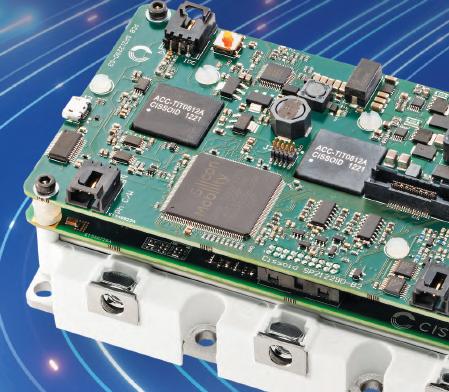


















The ICM3S series of Inverter Control Modules forms the heart of CISSOID’s modular inverter platform, leveraging Intel® Automotive’s ultra-fast Adaptive Control Unit T222 and the Adaptive Control App - T222 Inverter software for rapid development of electric motor drive trains. Detroit,6-9October
NEW Inverter Control Module ISO26262 ASIL-C Ready certified
• 3-phase 1200V 340-550A SiC power module
Integrated HADES2-based gate driver board
Dual ARM® Cortex-R5F in lockstep

Advanced Motor Event Control (AMEC®) unit



Real-time actuator & sensor control and processing T222 processor & software ISO26262 ASIL-D certified







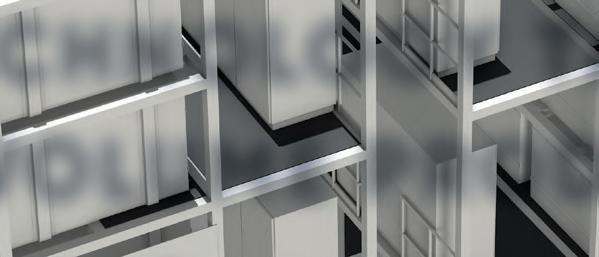

Discover a new formation chamber with high-efficiency power electronics! The chamber is designed for the initial charging and discharging of cylindrical cells. This advanced power electronics solution complies with high level safety standards and offers an energy efficiency of 85 percent from
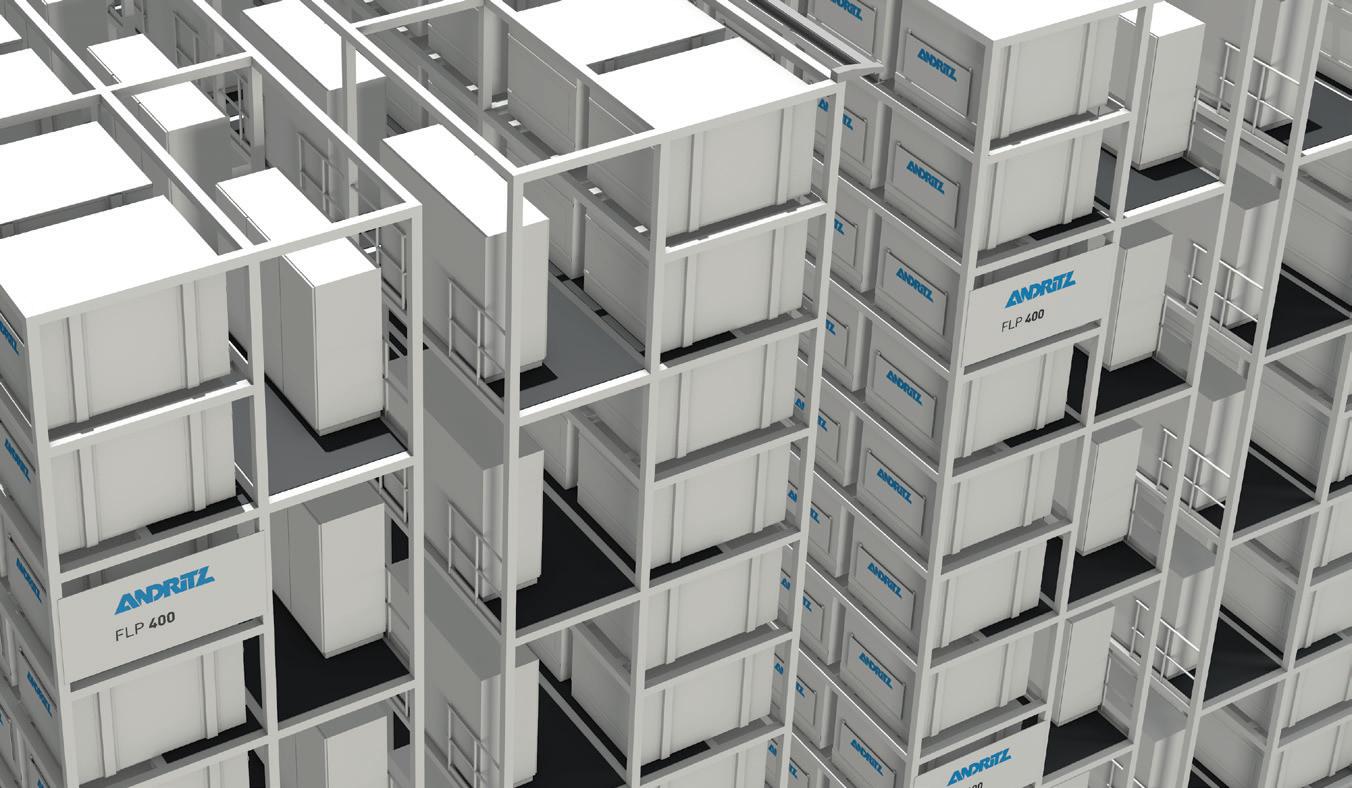




grid to cell and cell to grid – even 92 percent is possible from cell to cell. Turnkey equipment and service solutions for battery cell assembly and finishing, including the chamber, will be showcased by ANDRITZ at the Battery Show North America. ANDRITZ. FOR GROWTH THAT MATTERS.
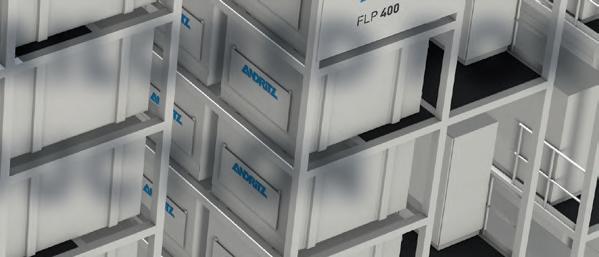




imc Test & Measurement, part of Axiometrix Solutions, has announced the launch of the imc CANSAS ex HISO-T-8-2L, a high-isolation CAN bus-based temperature measurement module designed for high-voltage environments. e company says the device speci cally addresses advanced requirements in EV battery development, research and testing, particularly as battery system voltages rise beyond 800 V.
e HISO-T-8-2L module features eight thermocouple channels accessible via LEMO.2P Re-del connectors, supporting four Type K thermocouples per connector.
e module is rated for high-voltage safety isolation at up to 1,400 VDC, and is tested at up to 8 kV peak and 4.4 kV root mean square (rms) voltages.
e company says the module delivers high measurement accuracy for precise battery temperature monitoring, a critical parameter in EV battery system performance and safety. e HISO-T-8-2L integrates into the existing CANSAS ex (CANFX) data acquisition platform, and supports cable-free installation with a click-in design. It is also rack-ready for use in standard 19-inch test stand systems.
e HISO-T-8-2L replaces a previous-generation CANSAS ex module, and is intended for applications such as testing DC power links, high-voltage batteries and complete electric drive systems.

TotalEnergies Lubri ants and XING Mobility have partnered to promote and optimize immersion cooling battery technologies. e partnership will initially focus on electri ed marine applications, and the companies plan to extend it to energy storage systems, mobility sectors and backup power solutions for data centers.
XING Mobility has developed an immersion cooling battery system originally aimed at high-performance electric sports cars, which is now being commercialized for broader electric mobility and energy storage markets.
e partnership will combine XING Mobility’s battery architecture with TotalEnergies’ high-performance dielectric uids. e companies say the collaboration will accelerate the adoption of direct immersion cooling in European-certi ed marine platforms and high-power, high-safety energy storage systems.
e immersion technology targets improved thermal e ciency and re safety, and has been validated in a range of applications including passenger and commercial vehicles, agricultural and industrial machinery and the rst immersion-cooled energy storage system for wind farms.
“ is collaboration sets the stage for joint market development e orts, leveraging TotalEnergies’ international network and XING Mobility’s technical leadership to expand the global reach of direct immersion cooling technology,” said Jean Parizot, Vice President Automotive at TotalEnergies Lubri ants.




Eaton’s Mobility Group will supply its High-Power Lock Box (HPLB) SQ8 connector system to a major global OEM for a new PHEV platform. is agreement is the rst application of the SQ8 variant in a PHEV.

e SQ8 con guration of the HPLB connector features a patented, inverted terminal contact design that combines a stainless-steel spring to maintain consistent contact force—especially a er repeated thermal cycling—with a copper current carrier to maximize conductivity. Eaton says this design addresses common failure modes like mechanical relaxation found in high-vibration electric vehicle environments.
e HPLB SQ8 terminal has been internally tested and benchmarked against publicly avail-able competitor data, reportedly delivering a 2535% improvement in current-carrying capability for a given wire size, and 30-60% higher current per unit volume, which can support lighter and more e cient vehicle platforms.
e HPLB SQ8 connector is designed for demanding applications such as battery disconnect units (BDUs), high-voltage heaters and propulsion systems in EVs, PHEVs and heavy-duty commercial vehicles. e system supports up to 270 amps of current with minimal resistance loss and operates at temperatures up to125° C. It o ers a tool-free push-click-pull mating process that requires only 70 newtons of force, intended to reduce operator fatigue and eliminate the need for mechanical levers.
Technical highlights include a two-piece terminal compatible with 25-70 mm² wire gauges, exible 90° and 180° terminal orientations for demanding packaging constraints, eight spring-loaded contact points, and compliance with USCAR-2 T3/V2/S3 and ISO standards. e connector is nger-proof, validated for up to 10 mating cycles, and features QR code-enabled part traceability for logistics and quality control.
Eaton notes that its HPLB family of connectors, including the previously released SQ4 variant, has already been deployed in commercial truck platforms, select electric vehicle applications and high-current heating systems.
Cable solutions for dynamic applications
Shifting into high gears for your success: our innovative cables stand for a safer future of electromobility.
Discover our products:
For the tightest installation spaces – extremely flexible
Special conductor design for excellent ultrasonic welding properties
Highest concentricity supports optimal automated processing
Excellent sealing properties
Free of PCB and talcum powder












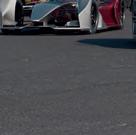
















Come visit us:




The Battery Show Booth No.: 5622

October 06-09, 2025 Huntington Place, Detroit











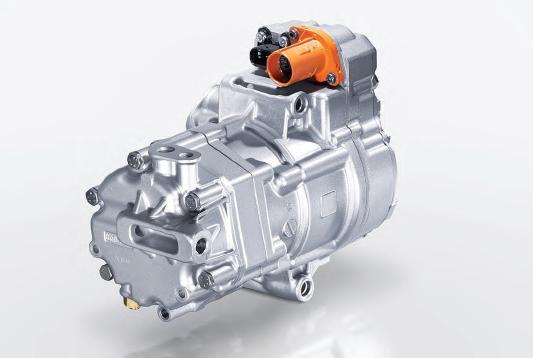
MAHLE has announced the start of production for its high-voltage HVAC e-compressors at its Tennessee facility—the rst time the component has been manufactured in North America. E-compressors are critical components for managing e cient HVAC systems in EVs, which have a direct impact on driving range.
e Morristown facility, previously focused on steel piston production for internal combustion engines, will now produce both legacy and EV products at one site.
MAHLE says the new e-compressor production line is part of its larger commitment to the US market and local manufacturing. Over the last ve years, MAHLE has created more than 300 jobs in Tennessee through its thermal management operations in Murfreesboro. Activation of this new production line is expected to create 50 new jobs, bringing total employment at the Morristown site to almost 800.
“Starting the e-compressor production in Morristown, Tennessee, marks an important milestone for MAHLE as we further strengthen our footprint in the USA and our role as local employer,” said Arnd Franz, Chairman of the Management Board and CEO of MAHLE.

BRUSA HyPower specializes in electrical energy conversion systems—including DC-to-DC converters and onboard charging systems—for automotive and stationary applications.
e company has announced the series launch of its OBC7 and BSC7 product families, both certi ed for automotive use. ese products have been developed for modern electric vehicles, including passenger cars, commercial vehicles and o -highway applications, with a focus on high performance, durability and sustainability.
e OBC7 is an on-board charger designed for fast and e cient charging of electric vehicles. It supports charging at up to 19.2 kW for single-phase AC and up to 22 kW for three-phase AC, and is compatible with both 400 V and 800 V battery systems. e charger is based on cost-optimized silicon carbide (SiC) technology and features galvanic isolation and integrated DC charging management. e OBC7’s charging power can be scaled by connecting multiple units in parallel.
e BSC7 is a bidirectional supply converter designed for versatility across automotive applications, from passenger cars to heavy-duty trucks. e company highlights the BSC7’s compact footprint (56 x 196 x 272 mm), weight of under four kilograms, and galvanic isolation between the high-voltage (HV) and low-voltage (LV) sides. e BSC7 is compatible with 400 V and 800 V battery architectures, and is designed with environmental compatibility and longevity in mind, BRUSA notes.





Rimac Technology has unveiled new EV battery platforms, ultra-compact powertrains and next-generation control electronics developed through collaborations with ProLogium, Mitsubishi Chemical Group and Kautex Textron. e products are designed for large-scale production, and are production-ready, according to Rimac.
Rimac’s next-generation battery system integrates solid-state cell technology and new housing solutions. e company designed a platform supporting both high-energy and high-power con gurations using either 46XX or 2170 cell formats, with scalable cell-to-pack architecture and integrated safety and thermal features.
Rimac’s new powertrain platforms include the SINTEG 300 and 550 single electric motor eAxles, which can reach over 8 kW/kg power density and more than 90 Nm/kg torque density. e patented rotor achieves speeds up to 25,000 rpm. Both coaxial and o set layouts o er output from 150 to 360 kW and torque between 2,500 and 6,250 Nm. ese are targeted at a range of EV applications, from sports coupes to SUVs. Rimac is also developing a high-torque XXL Axle—a dual-motor unit validated at over 11,000 Nm—which is to enter production in 2026 with a global automaker.
Rimac has also launched a portfolio of domain and zonal electronic control units (ECUs) powered by NXP’s S32E2 processors. ese units consolidate multiple traditional ECUs into high-performance domain controllers, managing tasks such as torque vectoring, battery management and high-voltage distribution. e architecture is designed around centralized so ware-de ned vehicle principles, supporting real-time operation, over-the-air updates and advanced safety requirements.
All the newly unveiled technologies will be produced at Rimac’s Croatian manufacturing facilities, which consist of over 95,000 square meters of space across two sites.
ese technologies represent “the convergence of breakthrough innovation and production readiness,” said Rimac Technology COO Nurdin Pitarević. “ ese aren’t simply concept technologies—they’ve been developed to be production-ready solutions that will power hundreds of thousands of vehicles in the coming years.”
Actively cooled high-voltage cables
Keeping your performance cool! Our actively cooled cables deliver peak performance and absolute reliability, no matter how tough the conditions.
Discover our products:
Smaller conductors reduce weight
Reliable operation in any environment
For smaller diameters with highest performance
Shielded or unshielded, copper or aluminum
Less material, lower cost
Come visit us:

The Battery Show Booth No.: 5622



October 06-09, 2025 Huntington Place, Detroit


















Vishay Intertechnology has introduced the MKP1848e, an AEC-Q200-quali ed, metallized polypropylene lm capacitor engineered for demanding automotive, energy and industrial environments. e MKP1848e capacitor supports operation at temperatures up to 125° C, and is designed to withstand harsh operational and environmental stresses, making it suitable for EV powertrain applications.
e MKP1848e o ers rated capacitance values ranging from 1 microfarad to 140 microfarads, and supports voltages from 500 VDC to 1,300 VDC. Vishay says the device achieves low equivalent series resistance (ESR) values down to 1.0 milliohm and supports ripple current up to 44.5 A. e capacitor provides 25% higher ripple current density compared to previous-generation devices with identical volume. e MKP1848e can also withstand temperature humidity bias conditions per Grade III of IEC60384-16 edition 3 (60° C, 93% relative humidity, 1,344 hours at rated voltage) and endures 1,000 thermal shock cycles from -40° C to 125° C, each with a 30-minute dwell time.
e MKP1848e matches the high voltage standards required for EV and PHEV platforms, withstanding operating voltages from 250 VDC to 800 VDC at 125° C for a limited period. e component features optional customized terminals and supports compact designs with pitch options as low as 22.5 mm, enabling up to 40% volume reduction at 500 VDC and 15% at 900 VDC.
Target applications include fast chargers, solar inverters, hydrogen electrolyzer recti ers, battery storage systems, motor drives and uninterruptible power supplies. Samples and production volumes of the MKP1848e are currently available with a typical lead time of 10 weeks.

Starting in February 2027, every EV and industrial battery sold or used in the EU must include a digital record called a battery passport.
e battery passport, which is linked to a QR code directly on the battery, provides information on where the battery was manufactured, the types of materials used, and the environmental and social impact of its production (including carbon emissions and labor practices throughout the supply chain).
As Christopher Chico reports in his Battery Chronicle newsletter, the main purpose of the EU Battery Regulation is to improve transparency within the battery industry by providing information to recyclers, customers and regulators. To ensure security and transparency, battery passports must use open data formats.
e requirements of the law are being phased in over a period of several years. e regulation became active in August 2023. In 2024, safety and performance standards became mandatory. In 2025, companies were required to start reporting the carbon footprints of their EV batteries, and to document ethical management of their supply chains. In 2026, carbon footprint labels and data-access rules will be nalized, and in 2027, digital passports will become compulsory for entering the European market.
Battery passports will organize information into three categories: public, restricted and regulatory.
Public data will include the battery type, its carbon footprint, and details about ethical sourcing.
Restricted information will include repair and recycling instructions for service technicians and recycling facilities.
Regulatory data, accessible only to government agencies, will include compliance reports and test results.




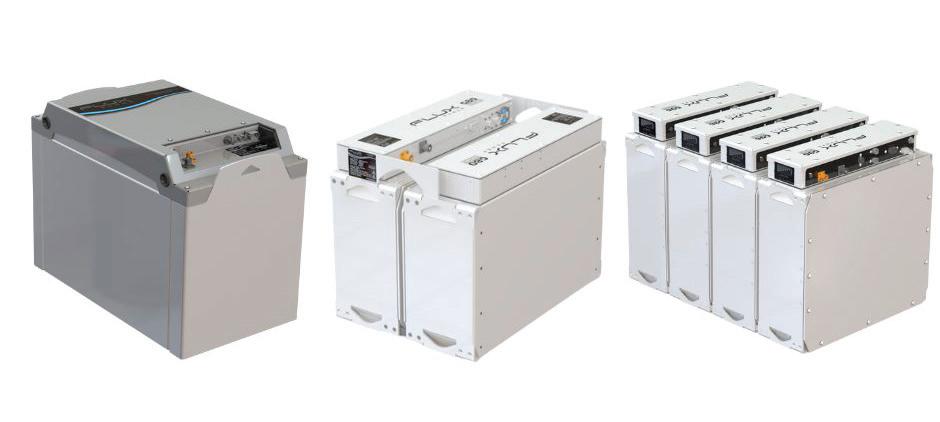
Flux Power has announced a $1.2-million order from a major North American airline for its G80 lithium-ion energy systems integrated with the SkyEMS so ware platform.
e G80 solution combines hardware and so ware in a single platform to deliver real-time data on eet performance, asset health and maintenance requirements. Flux Power says this enables predictive maintenance, improves asset uptime and addresses operational speed and reliability for airport ground support eets. e modular architecture of the G80 battery units is designed to allow rapid eld servicing and minimize downtime, while the system’s operational intelligence suite generates actionable insights for preventive maintenance and decision-making.
e airline’s purchase, handled through Flux Power’s aviation partner Averest, covers deliveries scheduled throughout 2025. Additional orders are expected, Flux Power reports, citing ongoing momentum for intelligent battery systems in the aviation sector.
“Airlines today need more than just batteries; they need data-driven solutions that keep them ahead of challenges on the ground,” said Krishna Vanka, CEO of Flux Power. “Our integrated hardware and so ware o ering delivers not only the power to move equipment but the intelligence to keep operations running at peak performance.”
While this project focuses on aviation ground support, Flux Power designs and manufactures lithium-ion storage and battery management systems for a range of industrial, commercial and stationary applications.

Dürr Systems debuts two-sided simultaneous electrode coater for battery cell OEMs
German engineering rm Dürr Systems has expanded its portfolio of two-sided simultaneous electrode coating machines with a new coater that uses Siemens technologies to support tension-controlled coating capabilities. e company’s product is tailored to customers’ requirements for a complete electrode coating process that supports integrated solvent recovery and onsite re ning along with state-of-the-art roll presses, said CTS Sales Director Jim Hartnett. Dürr also o ers Tandem Coater equipment with integrated solvent recovery.
“While the Tandem Coater remains the industry’s preferred means of battery electrode production and still a viable OEM option for our customers with many years le in its lifecycle, we wanted to leverage our engineering know-how from it to give our customers another way to elevate and expand their production,” Hartnett said.
e Dürr GigaCoater has a straight-path product ow on a single coating station. Slot-die coating on a backing roll is immediately followed by a tensioned-web slotdie coating to coat both sides of the current collector in one pass. An air otation dryer enables simultaneous two-sided coating as the foil runs through a non-contact drying process.
For help with automation and controls, especially motion control, Dürr chose Siemens partner and systems integrator DMC.
e GigaCoater’s automation and control system contains numerous Siemens components from its Totally Integrated Automation (TIA) portfolio. ese include the SIMATIC S7-1500 Programmable Logic Controllers (PLCs), which oversee the two-sided simultaneous coating processes to precisely manage the movement, alignment, and timing of numerous servo motors as the copper foil substrate moves through the machine and its oat-drying modules.

US-based AM Batteries (AMB) has launched an interactive Savings Calculator to enable battery makers to quantify the cost and performance impact of using its Powder-to-Electrode dry-coating equipment to produce lithium-ion batteries.
e calculator uses inputs including factory location, production capacity, cathode and anode materials, electrode thickness, process yield and vendor tier to provide estimates for CapEx, OpEx and factory footprint. It benchmarks conventional slurry-based methods against AMB’s dry approach under real-world conditions.
A cell maker operating a 30 GWh gigafactory could save more than $100 million in annual operating expenses by switching to dry electrodes, the company claims, while producing higher-performing cells with improved adhesion, higher areal loading capacity and longer cycle life.
AMB’s process eliminates solvents and energy-intensive drying ovens to deliver more than 60% lower operating costs and up to 40% lower capital expenditure, while also reducing facility footprints by 30%, the company said. e process enhances cell performance by enabling faster wetting, binder exibility and recyclability of excess powder.
“ is tool transforms the value of dry electrode from theory into data,” said Lie Shi, CEO of AM Batteries. “Within minutes, manufacturers can see how our Powder-to-Electrode process impacts their cost structure and the performance of the cells they produce.”
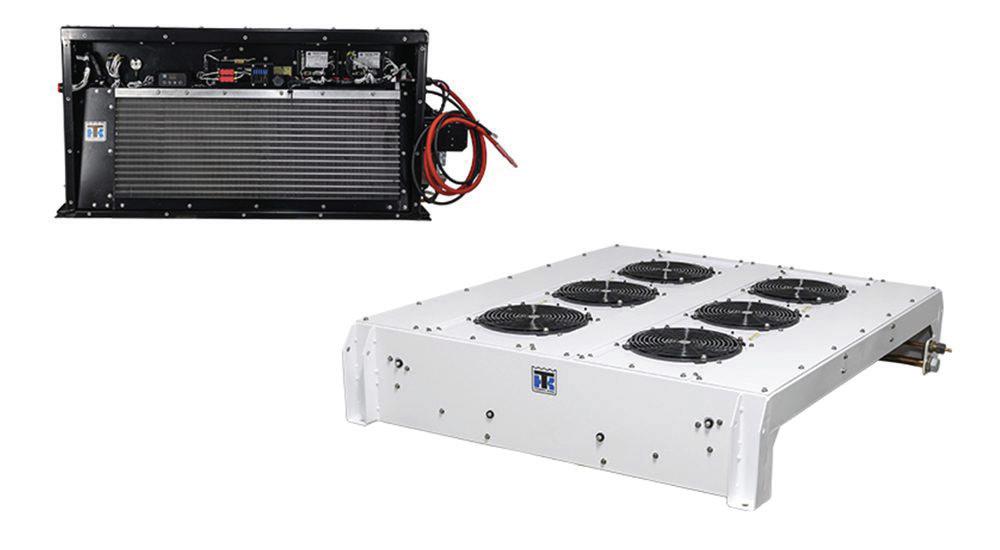
Transport climate control specialist ermo King, a brand of Trane Technologies, has introduced a new heat pump for battery-electric buses operating in moderate and colder climates.
Part of ermo King’s all-electric TE Series product line, the new TE Series Heat Pump enables eet operators to extend bus range, further reduce emissions and maintain passenger comfort.
Electric resistance heaters signi cantly reduce operating range by drawing substantial amounts of energy from vehicle batteries. e TE Series Heat Pump applies Trane’s expertise in heat pump technology, which has been applied across commercial buildings and homes, to public transit applications.
e TE Series Heat Pump extracts heat from ambient air rather than generating heat from battery power, delivering up to 2.5 times more energy e ciency than resistance heaters, which translates to more miles per charge. ermo King says buses equipped with the TE Series Heat Pump can achieve up to 50% more range at moderate temperatures (40° F) and up to 30% more range at colder temperatures (20° F) compared to those using resistance heaters.
e system e ectively keeps passengers warm at temperatures as low as 20° F without the need for backup heating. In colder climates requiring auxiliary heat, the TE Series Heat Pump allows for extended bus routes and reduced reliance on battery recharging.
“ is product is a critical step in continuing to make public transportation more e cient, reliable and eco-friendly, proving that decarbonization and operational excellence can go hand in hand,” said Chris Tanaka, VP of Product Management for ermo King Americas.




Toshiba Electronic Devices & Storage Corporation has introduced three 650 V silicon carbide (SiC) metal-oxide-semiconductor eld-e ect transistors (MOSFETs). ese new devices, part numbers TW027U65C, TW048U65C and TW083U65C, are designed for industrial power electronics.
ese third-generation SiC MOSFETs are housed in general-purpose TOLL surface-mount packages, which reduce device volume by more than 80 percent compared to through-hole packages such as TO-247 and TO-2474L(X). is enables increased equipment power density and supports automated manufacturing.
Toshiba says the TOLL package o ers lower parasitic impedance—resistance and inductance—than through-
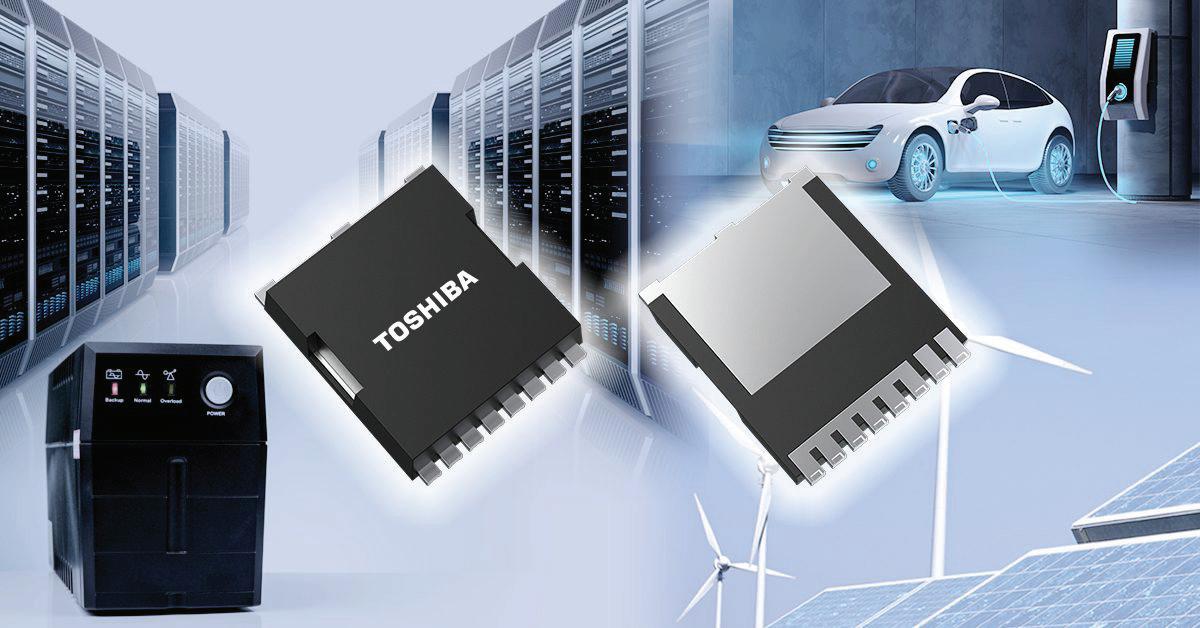
hole packages, resulting in decreased switching losses. As a four-terminal package, TOLL allows for a Kelvin connection signal source, which minimizes the impact of source wire inductance on gate driving performance. is design leads to higher switching speeds—for example, the TW048U65C reportedly achieves approximately 55 percent lower turn-on loss and 25 percent lower turno loss compared to previous Toshiba 650 V SiC MOSFETs in a TO-247 package without Kelvin connection.
While the new components are suitable for various industrial power electronics, Toshiba identi es EV charging stations and photovoltaic inverters as speci c target applications. e devices are also intended for switched-mode power supplies in data centers, servers, communications equipment and uninterruptible power supplies.
Inspired by temperature
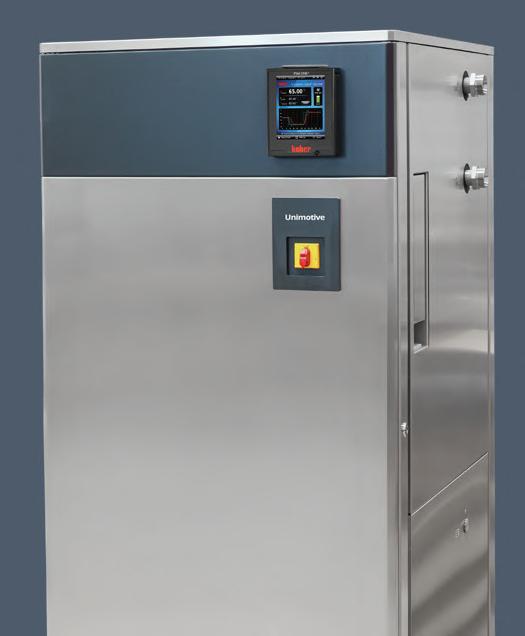



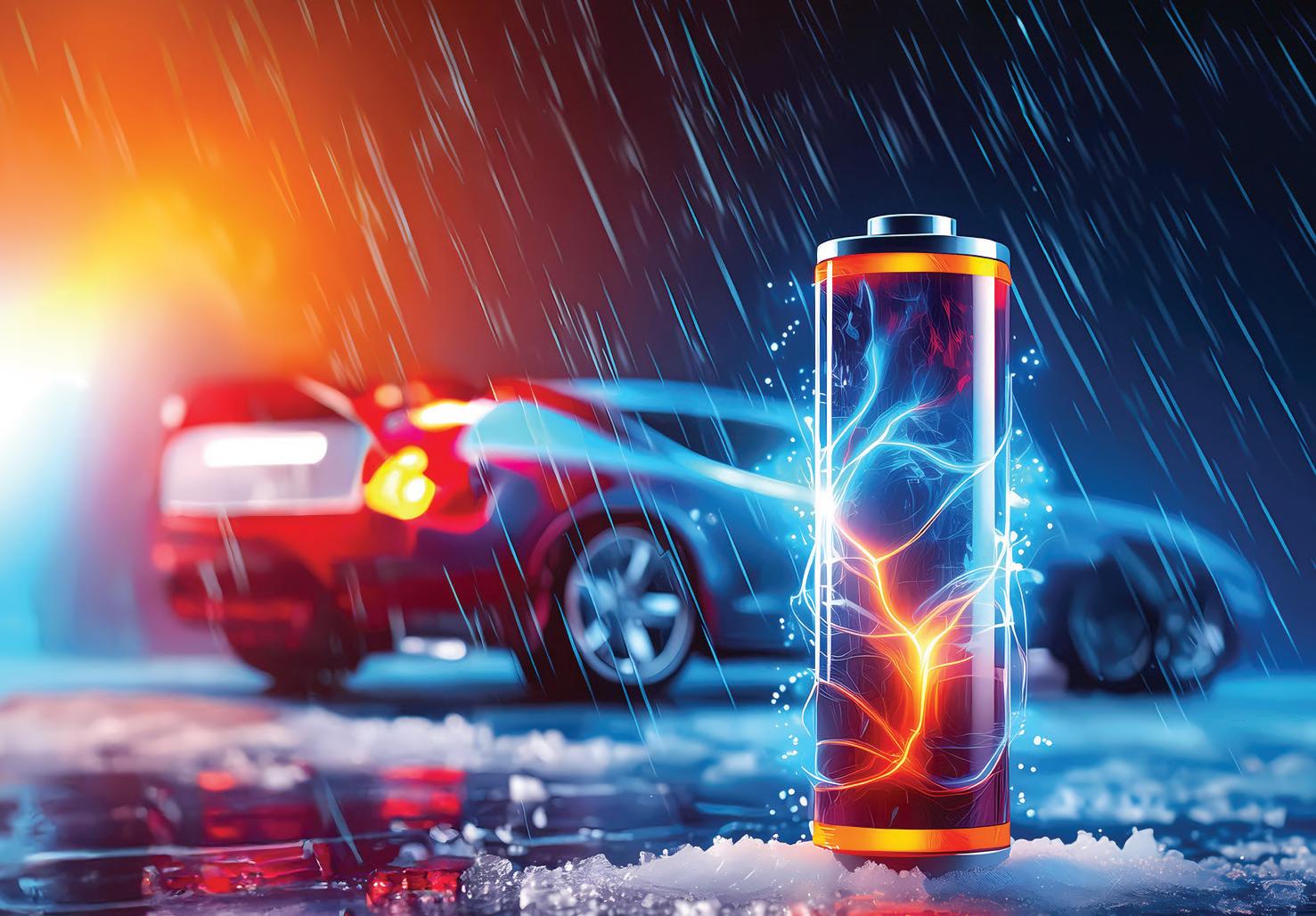
By Jeffrey Jenkins




The vast majority of power converters used in the EV space—from battery chargers to traction inverters—are classi ed as voltagefed, meaning they expect to be supplied from a source whose voltage varies little with changes in current draw (i.e. has a low impedance), and the best way to ensure this condition is with a capacitor across the power input, as it will e ectively nullify any upstream stray inductance in the wiring, etc. e amount of input capacitance required tends to scale directly with current draw or power level, and inversely with pulse frequency or voltage, but once you get to the kW power level and/or above 48 V, you can pretty much guarantee that directly connecting power without some means of controlling the ensuing inrush current will end in tears, as dividing a high supply voltage by a low loop impedance (including the capacitor Equivalent Series Resistance, or ESR) can easily result in tens of kiloamperes of inrush. ere is an easy solution to the problem—well, easy in theory, anyway—and that is to bring the capacitor voltage up slowly, a process typically referred to as precharging.
e sophistication (read: complexity and cost) of these precharging (and inrush current control measures in general) also tends to go up with supply voltage and power level, though complicating factors like safety agency requirements will o en severely constrain what approaches will be acceptable, regardless of how e ective they might be.
Low-power auxiliary converters supplied by moderately high voltages (drawing a continuous current of <100 mA or so) can simply use a xed resistor which is permanently wired in series with the supply to control inrush current, and o en this resistor can perform double duty as a fuse (in which case it’s a fusible resistor). While this might sound like anathema from an e ciency standpoint, the absolute losses we are talking about here should be less (much less, really) than 1 W. For example, a 100 Ω resistor in series with a 340 V supply will limit inrush current to a downstream converter to a maximum of 3.4 A, and if the converter only has to supply a load of 5 W at an e ciency (sans resistor) of 65%, then it will draw about 23 mA, incurring an additional loss in the series resistor of
around 50 mW. at’s a minuscule increase in loss by any standard, but do keep in mind that this loss will scale with the square of converter power, and once it reaches about 1 W, the size of the resistor required to keep its surface temperature reasonable (i.e. well below 100° C) starts to get ridiculous.
Another inrush current-limiting solution that is just as simple as a xed resistor is one with a negative temperature coe cient. Such NTC inrush current limiters are resistors that will typically swing from 5 Ω to 50 Ω at 25° C down to 1/10th to as little as 1/50th of that value when heated (by the current owing through them) to around 100-200° C. is 10x to 50x reduction in continuous losses without any penalty in inrush current limiting makes a compelling case for the NTC resistor, but one major downside for EV applications—especially for onboard devices—is that the allowable ambient temperature range is necessarily limited. A less-appreciated caveat is that a properly spec’ed NTC inrush current limiter will necessarily get quite hot during operation, and there is no option to oversize it to reduce said operating temperature, as is possible with a xed resistor. Another possible downside is that the NTC resistor will need some time to cool o when the load is removed before it will once again limit inrush current (1-2 minutes is typical), so loads that are cycled o en (or which vary considerably) aren’t a good t.
e next approach for controlling inrush current is with a xed resistor that is switched in to bypass the main contactor before the latter is closed. e trigger conditions for the precharge switch can be as simple as a xed time delay (though this is really not recommended), or something more elaborate, such as when the capacitor voltage comes up to within a few volts of the incoming supply, or the current through the precharge resistor drops below a certain value. e precharge resistor can be tricky to properly specify, however, as it needs to be of a construction that is capable of handling a very high peak power (namely, W = V IN 2 / R), even though the average power may be quite low, depending on the time between power cycles (according to the equation W = C * V IN 2 / 2 * seconds). Generally speaking, bulk metal, wirewound and metal oxide resistors are most suitable for precharge use, while the lm types—pretty much regardless of construction—tend to die prematurely.
The precharge resistor can be tricky to properly specify, as it needs to be of a construction that is capable of handling a very high peak power.
Resistors appropriate for precharging applications will o en be speci ed by energy rating in addition to the more usual power rating, with the required energy rating coming from the capacitor energy equation (i.e. J = C * V IN 2 / 2). For example, if the incoming supply is 340 VDC and the capacitor is 1,000 μF, then the precharge resistor will need an energy rating of at least 58 J. Sometimes a pulse energy rating in joules isn’t directly speci ed for a resistor of a preferred construction, but if a short-time overload of, say, x times the rated wattage for y seconds is given, then the energy rating can be extrapolated by simply multiplying x and y. For example, the Ohmite TWW series (wirewound) are speci ed for 10x rated power for 5 seconds, so a 5 W resistor in this series could theoretically handle 250 J. at’s the theory, anyway, but my experience is that it’s best to assume the peak power rating is only tolerable for 1-2 seconds, max, and to string several smaller power resistors in series—particularly when V IN exceeds 300 V—to achieve the necessary energy rating. Finally, ensure that the average power rating won’t be exceeded, and be generous with this derating, as well, if for no other reason than to protect nearby components from excessive heat.
e switch in series with the precharge resistor also needs to be chosen carefully, as it must withstand the full supply voltage when open, and will then have to close into the highest current expected once precharging commences. e latter condition is notorious for welding the contacts of an electromechanical relay (an issue that is sidestepped with a solid-state relay). It is also important to consider what might happen to the precharge switch (and the main contactor it bypasses) during a short-circuit fault downstream, as then the voltage on the bus capacitor won’t rise, so




either the precharge switch will have to open under its maximum DC current—which will result in arcing in an electromechanical relay—or else the main contactor will be closing into a short (if the precharging sequence is performed blindly).
Standard electromechanical relays intended for AC switching are notoriously poor at breaking even a few tens of mA of DC current—the datasheet will typically show 1/10th the maximum AC rating at a mere 30 VDC—which is yet another argument for the SSR, but regardless, monitoring the bus capacitor’s voltage and aborting precharge if it doesn’t rise to the expected value within the expected time (+/- whatever tolerance is appropriate for the variation in capacitance value as well as that of the incoming supply voltage) is still highly recommended. Such monitoring also allows for closing the main contactor when there is an ideal 5-10 V still to go, as this will ensure that enough current ows during closure to blast oxides o its contacts, but not so much that they weld. Also note that electromagnetic relays don’t tolerate high shock loads/vibration without some e ort going into hardening them against such, which puts them at a further disadvantage against SSRs when used onboard an EV. at said, they are typically a lot cheaper than their solid-state counterparts, and they possess one advantage that is rarely (pretty much never) found in an SSR, which






Modeling and simulation accelerates design iteration, understanding, and project planning, but requires specific expertise that is not easy to access from the field, factory, or lab where in-the-moment decisions are made. Extend the benefits of simulation to those who need it, when they need it with your own custom apps.
» comsol.com/feature/apps











When simulation experts build apps based on their models, colleagues and customers can use simulation to guide decisions in real time.



Compile and distribute standalone apps worldwide with COMSOL Compiler and manage access to the apps with your own COMSOL Server™ environment. The choice is yours.






is a true Form C contact arrangement—that is, dualthrow, or a common pole switching between normally closed and normally open positions—which makes it very easy for the precharge resistor to turn around and discharge the bus capacitance. Not that there isn’t a semiconductor-based solution to rapidly discharging the bus capacitance, just that a SPDT relay can do such for (almost) free.
Finally, there is active precharging, which e ectively replaces the resistor in the passive methods discussed above with a current source. is can dramatically reduce the peak power that must be handled without a corresponding increase in the precharging time, as the current source will cause the capacitor voltage to rise linearly over time, rather than in an exponentially decreasing fashion. is comes at the expense of increased complexity, if not total cost itself, hence active precharging methods are best reserved for applications which have a large value bus capacitance that needs to be precharged rapidly (e.g. the traction inverter in an EV). e current source for active precharging can be a fairly simple linear type comprised of bipolar junction transistors or depletion-mode FETs, but note that this really just shi s the burden of dissipating power during precharging from a physically robust resistor to a comparatively more fragile transistor. ese losses can be eliminated by using a standalone switchmode converter that is con gured as a current source to do the active precharging. While almost any switchmode converter can be made into a current source via its control loop, some topologies are more suitable for this job than others. For example, the classic ringing choke converter (aka blocking oscillator or self-oscil-
Finally, there is active precharging, which effectively replaces the resistor in the passive methods discussed above with a current source.
Another good topology choice for active precharging is the buck converter, with the capacitor to be precharged substituting for its output capacitor.
lating yback) was very commonly used to charge the energy storage capacitor in battery-powered xenon photo ash strobes (and was responsible for their distinctive rising-pitch whine), which is pretty much what is required here. e RCC topology automatically limits output voltage and current even without a formal control loop, which is a big plus, but one major downside is that its switch must withstand more than twice the input voltage (assuming a 1:1 transformer turns ratio), which means a lot of board space will be needed just to accommodate the creepage and clearance requirements around it, if nothing else.
Another good topology choice for active precharging is the buck converter, with the capacitor to be precharged substituting for its output capacitor. A control loop will be needed to limit and/or regulate the output current with the buck, but the switch (and freewheeling diode) never see more than the input voltage, and the buck choke only needs a single winding, rather than at least three windings, as is required for the RCC. at said, the buck will require a lowvoltage power rail for its control circuit and some means of driving its (usually high-side) switch, meaning a gate driver IC that is either of the level-shi ing type (overall less robust and limited in the range of duty cycle it can handle) or which provides isolation (somewhat more expensive). For those interested in further reading on active precharging, Texas Instruments’ design guide, TIDA-050063, describes several approaches, including a buck converter-based solution for precharging a capacitance of 2,000 μF up to 800 VDC in 400 ms—something which would almost certainly be cost- and space-prohibitive if attempted with a resistor and a relay!
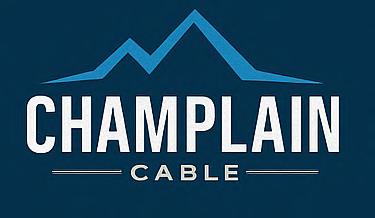














By Nicole Willing
As EV adoption accelerates, so does the frequency of battery recalls—and the operational expertise they require.
In recent months, a string of recalls from major automakers has underscored the complexities of EV battery systems. Hyundai recently pulled back a limited number of 2025 IONIQ 5s in the US a er identifying a short-circuit risk linked to a faulty battery pack busbar. Ford has expanded its recall of 2022 Mustang Mach-E models with extended-range batteries owing to overheating contactors that could cause a sudden loss of drive power. And BMW has faced back-to-back recalls—one a ecting more than 70,000 vehicles over a so ware issue that could cause the high-voltage system to shut down unexpectedly, and another targeting 136 EVs in the US for incorrectly assembled battery cell modules that could lead to power loss or re.
In some cases, these issues can be remedied with soware updates. In others, the battery needs to be removed entirely and replaced.
Unlike traditional vehicle recalls, which can o en be resolved with a quick part swap, removing and replacing an EV battery can take hours and must be repeated across hundreds or thousands of vehicles—o en under tight timelines. For a recent luxury EV model recall of more than 25,000 vehicles, the removal took nine hours per battery.
Once consumers are noti ed, an extensive technical response is mobilized. Teams of technicians, transport specialists and supply chain managers coordinate a complex operation to ensure that every recalled battery is safely handled, shipped, and then repaired, recycled or disposed of under strict protocols.
To understand the realities of this process, Charged spoke with Bryce Cornet, Senior Manager of Supply Chain Logistics at EV Battery Solutions by Cox Automotive.
We discussed what happens behind the scenes of an EV battery recall, how the process di ers from tradi-
tional ICE vehicle recalls, and the safety protocols that determine where each battery ends up.
Q Charged: What are the rst steps when a battery recall is announced?
A Bryce Cornet: e rst thing that is considered is whether it is a safety recall or a traditional mechanical recall.
When batteries have a safety recall applied to them, most of the time an OEM has had discussions with agencies like NHTSA and then released an announcement to customers. Customers get a letter in the mail saying the battery in their vehicle is a ected by a safety recall. ere could be instructions, depending on how severe the safety situation is, but for the most part it’s to explain to the customer that they need to bring their car in for battery replacement. If the recall is large enough, it may be bucketed based on the criticality of potential failures. e OEM will have data around when the production failure happened. Some batteries may be more critical than others, and they have an idea of which Vehicle Identi cation Numbers, or VINs, have these batteries in them. at’s something we’re able to help with too, because we have a so ware system that ties into the vehicle.
O en dealers are doing these repairs for the OEM. Is the dealer prepared to take on a large number of recalled repairs? ey may go from doing one repair a month to 20 repairs a month. Do they have the space to store battery packs? What are the ergonomics of moving a battery through a dealership network? Do they have the tools?
Another question is whether the recall is pack-level or cell-level. Primarily, what we deal with are module- and cell-level recalls. In that case, the whole battery pack is removed from the vehicle and shipped to us, either for module replacements—maybe we can nd the critical module and replace it and certify it—or it could be that the full battery pack needs to be re-cycled, in which case we do disassembly operations to make it safe to recycle.
On top of disassembly and recycling, there is a storage component to consider. Some of these battery packs may be held for a certain amount of time, but they need to be held safely.
Our warehouses at EV Battery Solutions have high-pressure re suppression systems. We support the dealer in getting batteries away from the dealership as quickly as possible, because they o en don’t have a lot of extra storage for battery packs. e important thing is getting the pack
Primarily, what we deal with are module- and cell-level recalls.
In that case, the whole battery pack is removed from the vehicle and shipped to us.
and storing it if we have to, or getting it quickly to recycling, to get rid of any type of risk.
Q Charged: How is transportation handled, given the risks of shipping large lithium-ion batteries?
A Bryce Cornet: EV batteries are packaged more robustly if it is a safety recall. A portion of this is planning, to safely transport a battery from a dealership or from distribution sites. at battery has to move through public ecosystems on trucks.
When a safety recall hits, the battery falls under a hazmat







regulation in 49 CFR with the Pipeline and Hazardous Materials Safety Administration, PHMSA, which states if the battery is damaged, defective or recalled, it cannot be transported by air or other means. We’re passionate about making recycling as close to a dealership as possible, because you don’t want to transport batteries far that potentially could have safety recalls.
Q Charged: Can you walk us through the logistical process of removing and handling a recalled battery?
A Bryce Cornet: e process varies based on the OEM, because every OEM has their secret sauce for how the battery ts into the vehicle. e form factor is di erent. You’re o en dealing with high-voltage connections, and it may not be easy to get to them to pull them out.
One thing that we o en run into, in addition to understanding how di cult it could be for dealers to remove that from the vehicle, is simply when we get it to our sites, there’s another layer of complexity, depending on how the battery shell mounts over the modules. Is it sealed with a glue? Is it bolted down and sealed?
We have to account for the time it takes to do the disassembly-to-recycling option, because o en there’s a rush to get these batteries o the road and get them recycled quickly. at can be quite the undertaking, especially as it can take anywhere from four to nine hours to fully disassemble a battery pack.
We have to account for the time it takes to do the disassemblyto-recycling option...anywhere from four to nine hours to fully disassemble a battery pack.
Q Charged: What are the biggest safety risks technicians face during battery removal, and how are those managed?
A Bryce Cornet: e biggest risk is that you’re dealing with something that has charge within it, which is somewhat di erent from pulling an engine out. You’re having to work around high-voltage cables. ere is a process to limit the voltage on the pack before they work on it, which should be a part of training.
Personal protective equipment, PPE, while they’re doing the job is likely di erent from traditional repairs and is important. And then a er you remove the pack you don’t want to store the battery pack outside.
Depending on what may be communicated by the OEM, if it is a safety recall and there are risks, you have to consider storage and packaging. You want to make sure that it’s packaged in compliant packaging and not le on a pallet outside. ere are also requirements to protect the environment that the dealer would need to know.
Q Charged: Are there enough skilled technicians in the industry to manage the process?
A Bryce Cornet: Part of the safety aspect is safe scaling. We o en have to train, hire and rehire to stand up more disassembly base. e dealer may also have to dedicate more people and more bays to these repairs, because that’s the quickest way to address long repair times.
Every time we’ve done a recall, we’ve had to hire new people that may not have been involved with EV batteries before, and that’s a risk. You have to be on it with operating instructions, having safety meetings every morning, and training your team before turning them loose on po-
We have an initiative inside Cox that is training all of our Manheim Auction sites to be EV-certifi ed. Dealers are doing the same thing and that’s getting better.
tential repairs. Dealers face the same issues with getting new EV technicians.
e number is growing, but it’s not necessarily at the point where every OEM is happy with the number of EV-certi ed techs.
We have an initiative inside Cox that is training all of our Manheim Auction sites to be EV-certi ed. Dealers are doing the same thing and that’s getting better. But nding high-quality, good talent to work on EVs can be a challenge—it is a di erence from ICE. You see a lot of ICE technicians moving over to EVs, because some OEMs are adding more EVs to their eets.
Q Charged: How does an EV recall di er from an ICE recall?
A Bryce Cornet: One thing is the size—the battery can be quite large. One of the recalls we supported was a battery pack that was about 1,000 pounds. It was about 1,800 pounds in a crate in total. You have a dealership inserting an item that may be ve times the size of the engines and transmissions they’re used to dealing with. And that leads into other factors that are di erent for
EV batteries. It goes all the way down to logistics. Carriers are used to moving all kinds of cargo, not just batteries. We need to educate the carrier to take precautions when they’re handling a battery.
ere are technical requirements when we take an order. A dealer will contact us to say they have a vehicle down and need a battery. ere is speci c information we need to take from the dealer about the battery that is di erent from a transmission.
On a transmission, you’re looking at mileage as an indicator of health. But for batteries, you are looking at mileage, but you’re also looking at state of charge, how much percentage charge is in the battery. at a ects how the OEM and how we interact with the battery when it arrives.
When we get a battery in, we’re o en assessing if it’s good enough to go back into a vehicle or not. Is it safe? Are there things we can do to repair it, or does it need to go to recycling? ere are di erent technical requirements for EVs, for us to make a decision on its criticality.
Q Charged: How do you decide whether it’s repaired, recycled or scrapped?
A Bryce Cornet: You wouldn’t want to nd out that a vehicle that was once a part of a safety recall ever has a battery that is part of another recall. Most of the time






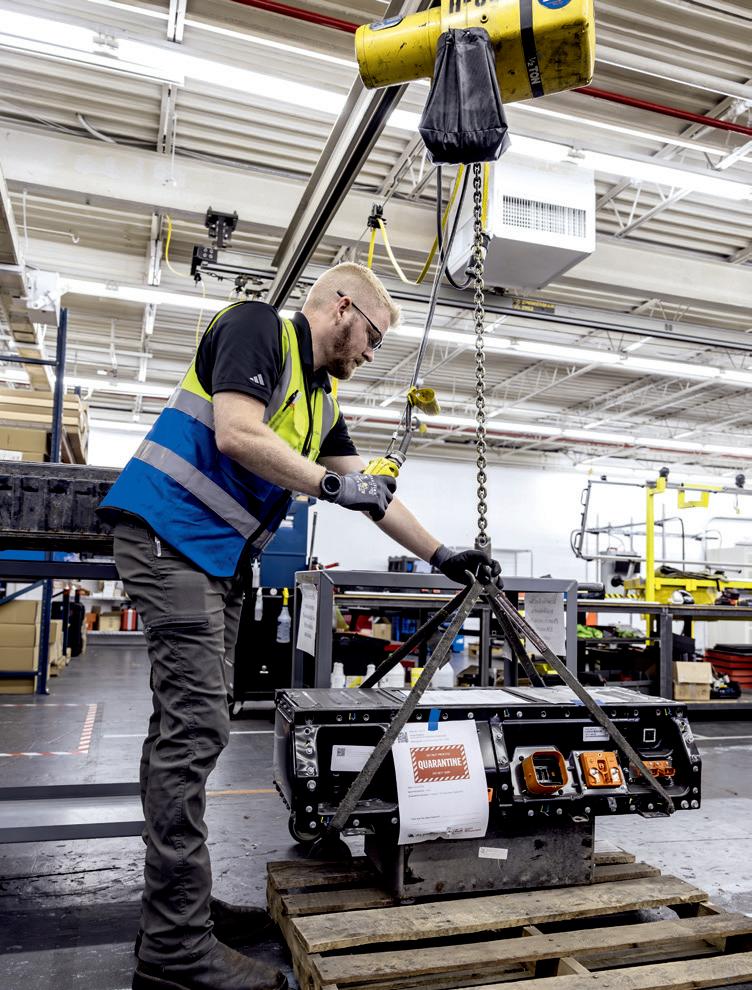
these batteries—the full packs— are disassembled and recycled immediately.
When we take in a battery, we get a core of varying health. e dealer doesn’t know of its health, usually, and we transport it here to diagnose it. We run a series of resistance measurements and voltage checks to get a baseline of what we’re looking at. ose baseline measurements are o en



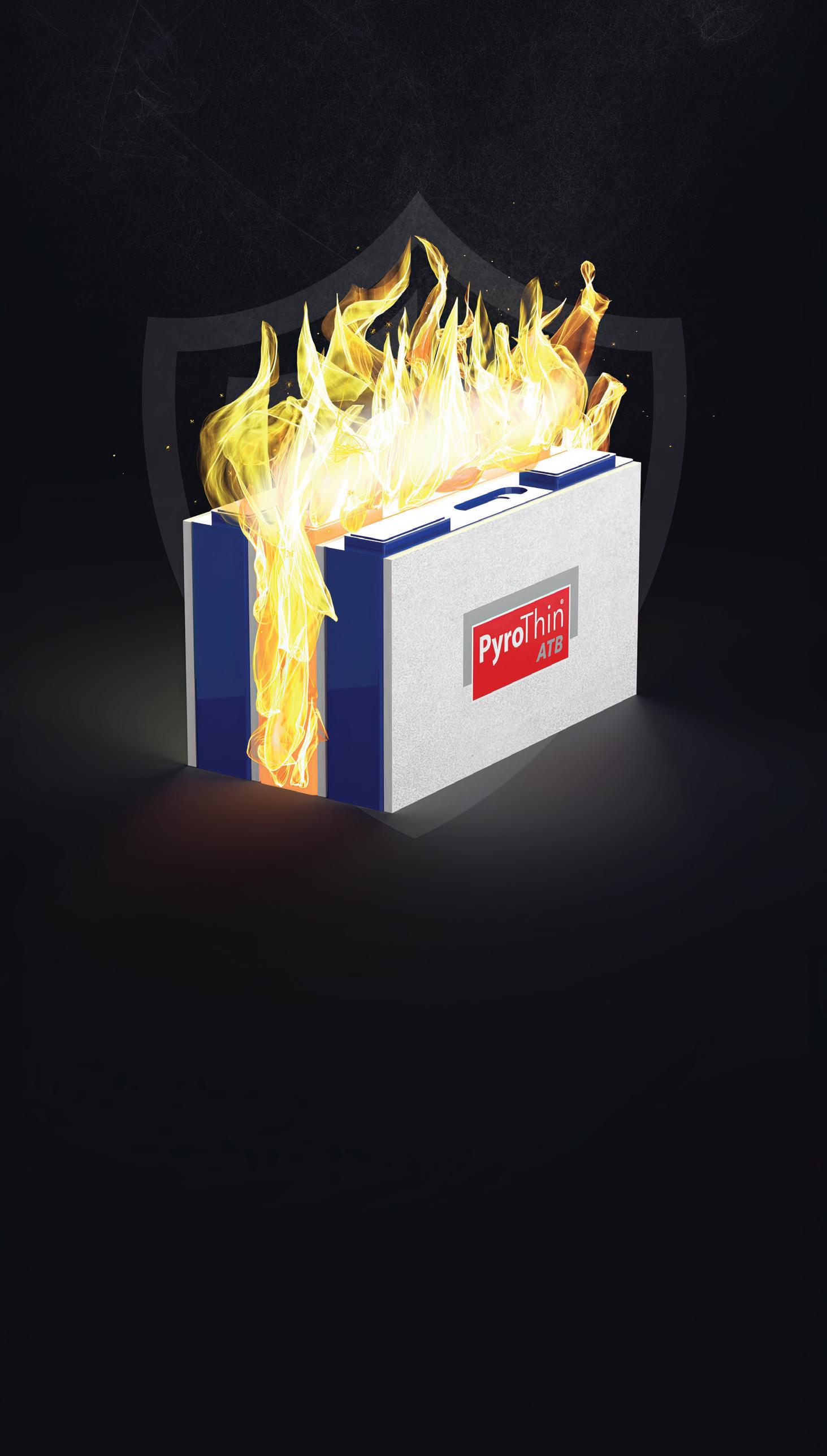
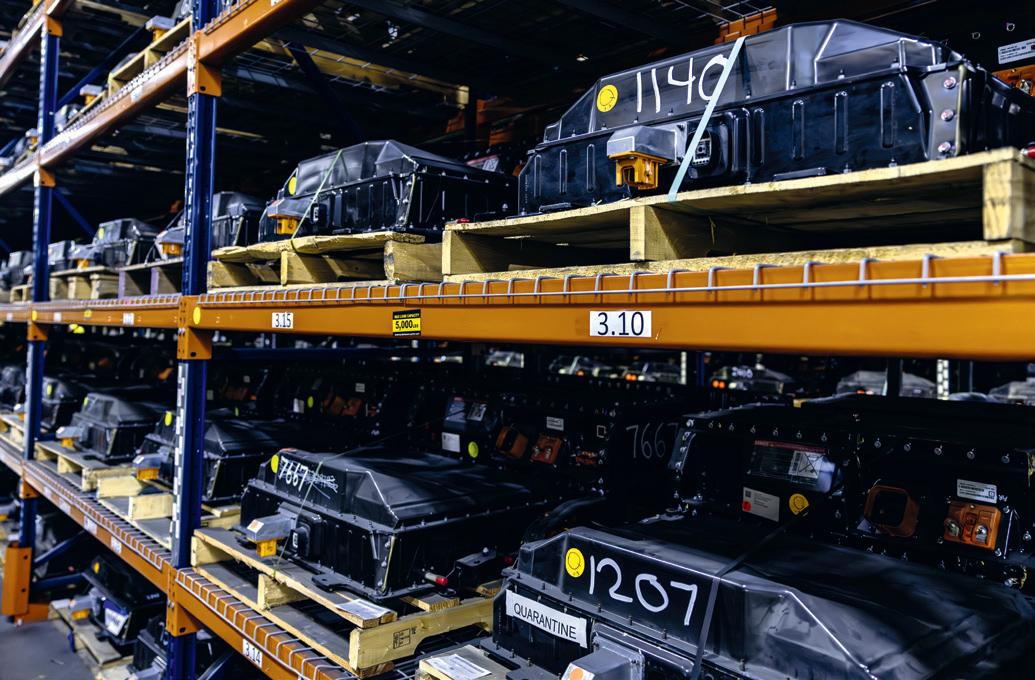
partnered with diagnostic trouble codes, or DTCs, that tell us if there’s a low cell, a dead cell, or something speci c.
Enough of that data leads us to a direction to tell if it is a good repair. If it has this DTC and these readings, we can potentially repair it. If it falls outside that window, we may have to recycle it.
At one time, we were manufacturing our own second-life energy storage systems. We’ve since stopped, but we do support other entities and OEMs with nding and testing battery cores to potentially allow them to do second life.
What we’ve o en found di cult is that, to be used for second life, a battery has to be in a sweet spot in between being good enough to go back into a car or bad enough that it needs to be recycled. And as pro table as recycling is becoming, for a lot of OEMs and for recyclers, there’s less of the second use happening.
Q Charged: What’s the biggest recall you’ve been involved in?
A Bryce Cornet: e biggest recall a ected about 150,000 vehicles in the US and Europe. My team had been doing 200-300 battery shipments a month, and at the peak of this recall we were doing about 600 battery shipments a day from a site in Detroit and a site in Oklahoma City.
We were shipping out new batteries and getting back the bad batteries. ese batteries weighed 1,500 pounds, and there was a process in which we had to move each battery from one crate to another before we could ship it. We had workstations with cranes, and we built a whole process where it was like a pit stop for a battery. We had about four people under that crane and they all had their job. e same thing was done for the shipping process to speed up how many we were doing.
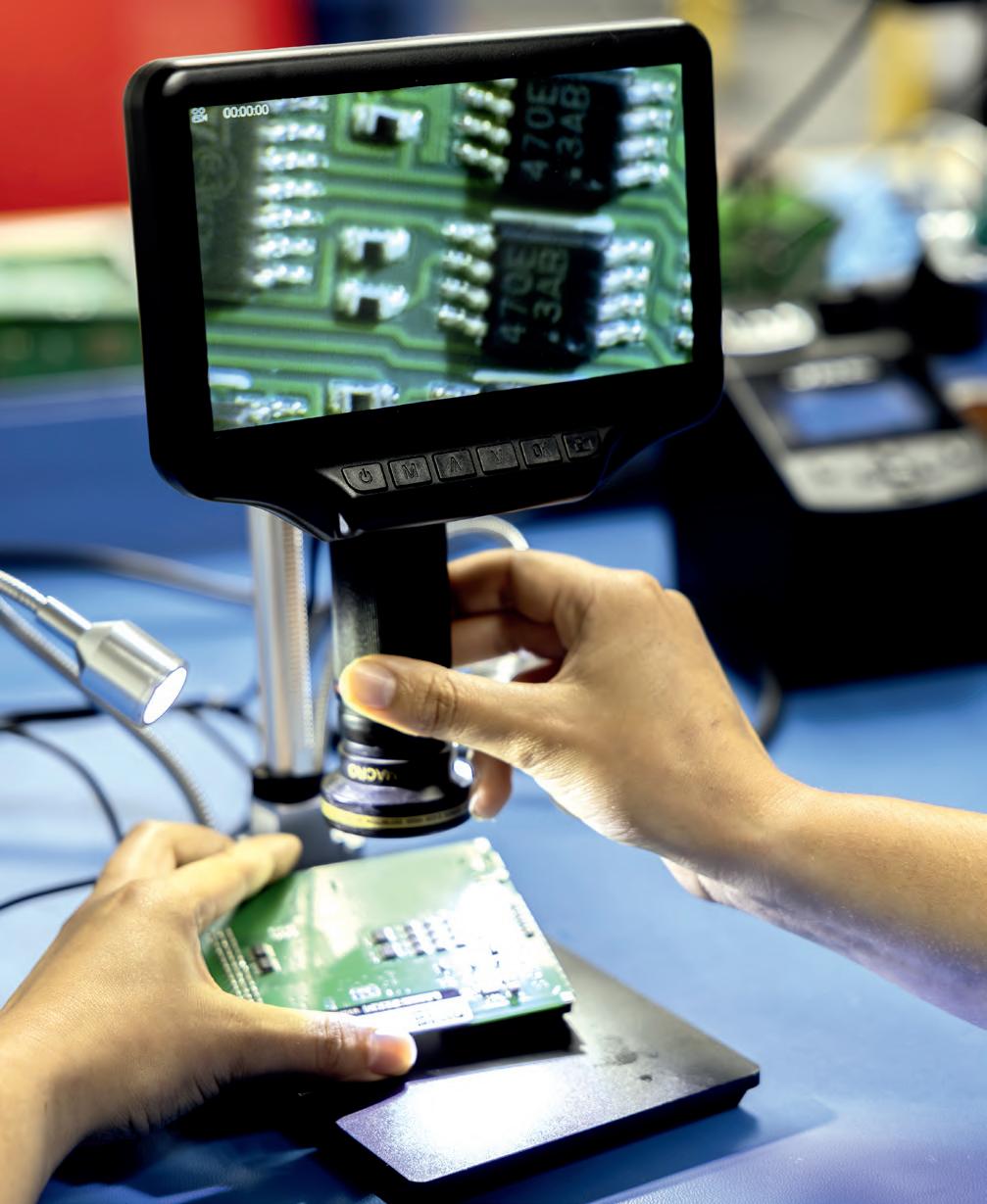






We had a timeline of how quickly this speci c client wanted the recall completed. We reduced our ful llment times from about 20 minutes per battery pack to about ve minutes. ere were so ware enhancements that we did to make it more automated. We developed a Quick Connect system to li the battery pack out that saved ve minutes alone. In these large peaks of volume, you start to see a lot of innovation happen.
Q Charged: Are you seeing innovations in robotics or AI that could be incorporated into the process?
A Bryce Cornet: It could be valuable in assessing a battery for damage when it’s brought in. We’re also looking into robotic automation to limit the risk to technicians from having to pull modules out of the battery, and cut out any
issues with human error that could happen with tedious tasks like replacing modules.
Q Charged: As commercial EV adoption increases, how does that potentially a ect a big recall?
A Bryce Cornet: We have a lot of partners where we deal with battery packs as large as 4,500 to 10,000 pounds, where you’re touching some of those commercial applications.
We have an e cient model to deal with scaling for a recall. But any time that happens we run into issues like truck availability. Moving these large battery packs requires speci c types of logistics or carrier transport—speci c trailers to move the battery on. at could strain the supply chain, because it’s not traditional for those trailers to be used in high volume.
We’re knowledgeable about that now, because we’ve faced it, but in a high volume we would have to work with our partners to make that change.
How does LFP affect potential recalls? Is it easier to handle LFP than the traditional NMC packs? We don’t have the answer yet, but as some of these OEMs change their chemistries, we’ll quickly fi nd out.
Q Charged: As EV adoption grows, do you expect recalls to become more frequent, or could the technology develop in a way that recalls become less likely?
A Bryce Cornet: It’s hard to say. It is true that as the sample size grows, we could have more recalls just from having more EVs on the road, or OEMs trying more things.
But what’s interesting is the changing of chemistries. A lot of OEMs are talking about LFP. e term solid-state is thrown around a lot, and there are a lot of di erent potential chemistries and ideas. How does LFP a ect potential recalls? Does it make it better or worse? Is it easier to handle LFP than the traditional NMC packs? We don’t have the answer yet, but as some of these OEMs change their chemistries, we’ll quickly nd out.
By John Voelcker
Looked at one way, the EV startup Lucid Motors faces huge challenges. For ve years, it’s only sold about 10,000 cars a year, its cash burn is prodigious even by auto startup standards, and it hasn’t had a permanent CEO since longtime leader Peter Rawlinson resigned in February.
On the other hand, acting CEO Marc Winterho was distinctly upbeat during the keynote address he gave at the recent IAA Mobility trade show in Munich.
e Gravity electric SUV is now available for orders in Europe, and deliveries are to start early next year. Europeans can order the high-end Grand Touring trim now, at a starting price of 116,900 Euros (roughly $137,000) in Germany. e Touring trim will be available “later,” at a price of 99,900 Euros. Range of the 123-kilowatt-hour battery version is quoted at up to 748 kilometers (465 miles) on 20- or 21-inch wheels, tested on the European WLTP cycle (US EPA testing rates the same SUV at 450 miles of range).
e Gravity is a known quantity in North America by now, at least to auto reporters and most EV shoppers. e company o ered drives of prototype vehicles 18 months ago, and US deliveries of the Gravity started recently. e launch Dream Edition has already sold out, and Lucid expects the majority of its deliveries for the rest of the year to be Gravity SUVs, rather than the 4-year-old Air luxury sedan. Winterho said Gravity demand has been strong enough to exceed current production capacity.
So … what’s next?
Following the Tesla playbook, just as EV startup Rivian is doing, Lucid plans to supplement lower volumes of its large luxury models with a range of smaller, more a ordable premium midsize vehicles—and it turns out there will be several of them.
Eighteen months ago, the company ashed a quick image of a shrouded midsize crossover on the screen during a presentation to show o its retooled and expanded Arizona factory. en, a year ago, it showed a slightly clearer partial rendering of what appeared to be that same vehicle—saying production would start in “late 2026” with a starting price “under $50K.” Lucid promised the midsize SUV would deliver “the same range as
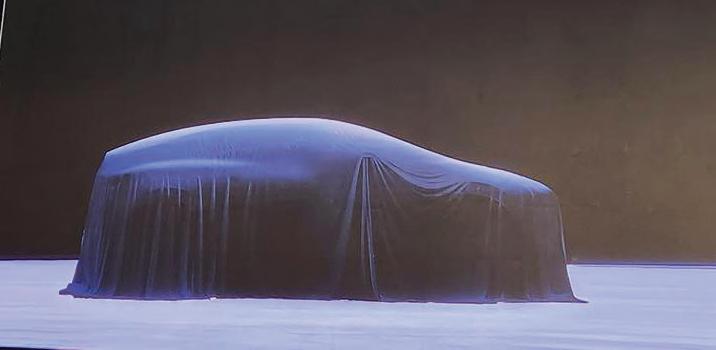
competitors” using a smaller battery, which helps keep the price low.
In a recent media interview, Winterho reiterated plans for a production date at the end of 2026 for its rst midsize vehicle, almost surely the SUV. is vehicle will compete with the Rivian R2, the aging Tesla Model Y, and various EV utilities from established makers.
More interestingly, he said a second model—or “top hat” in industry lingo—would follow “shortly therea er,” and a third roughly one and a half years a er that. e rst two are thus likely to be 2027 models, and when the third will hit the market is anyone’s guess.
So, if the rst of the new models is the SUV, will the second be a sedan, reversing the Tesla cadence? Or will it be something di erent? Asked about commercial applications—think Rivian’s battery-electric delivery vans, for instance—Winterho said the midsize vehicles largely target retail buyers, but will have a role in the eet market as well. ( ey will be assembled from Completely Knocked Down (CKD) kits in Lucid’s Saudi Arabia factory.)
Furthermore, Winterho suggested, the company’s midsize platform could serve as a future platform for driverless vehicles—like, perhaps, the robotaxis it announced in July that it would develop with Uber. Is that vehicle the third model on the midsize platform? It’s entirely possible.
Lucid has many bridges to cross before it begins volume production of a ordable EVs. First, the Gravity has to be a sales success not only in North America, but in Europe and other markets as well. Second, further factory expansion will be a necessity. And, of course, the company has to be able to deliver on the promise of elegant luxury, long range, and a desirable vehicle that’s still priced under $50,000.
Lucid’s acting CEO is exuding con dence that it can do all that. Stay tuned.




a sign of weakness, or a shrewd

Revel’s distinctive light blue electric cars will soon disappear from the streets of New York. e company has decided to end its rideshare service in order to focus on expanding its network of EV charging stations. e company says it’s making the move for the same reason it retired its iconic blue electric scooters in 2023—New Yorkers have plenty of transport options, and Revel has plenty of competitors. As a rideshare provider, Revel is a small sh in a huge pond—it provided some 80,000 rides in June in New York City, compared with about 20 million total rides for Uber and Ly , according to the NYC Taxi and Limousine Commission.
Now, all too o en when we hear a company announce something like this, we expect to hear about bankruptcy soon a er (successful companies tend to spin out unwanted subsidiaries, or sell them). But in Revel’s case, this could very well be a wise decision that positions the company for further growth.
As COO Paul Suhey explained to Charged in a 2023 feature interview, the reason Revel decided to develop rideshare and EV charging in tandem is that they were complimentary businesses—the company’s charging hubs kept its EVs charged, and the rideshare business provided the utilization rate required to justify the cost of the charging hubs. at strategy gave the young company a jump-start, but charger utilization no longer seems to be an issue. Revel told TechCrunch that the utilization rate of its charging network in early 2023 was just 21%, some 19% of that by its own eet. By early 2025, that utilization rate had jumped to 45%, only 12% of that from Revel’s eet. e company now seems to see the bigger rideshare players as partners—it made a deal with Uber in 2024, and over the last couple of years, it has seen an increasing number of Uber and Ly drivers using its charging hubs.
New York City’s Green Rides Initiative, introduced in 2024, mandates that 5 percent of rideshare trips need to be conducted by zero-emission or wheelchair-accessible vehicles. e share of Uber and Ly trips conducted by EVs more than tripled a few months a er the initiative took e ect, according to the NYC Taxi and Limousine Commission. Revel says it will now focus on building charging hubs in rideshare-dense urban areas. It plans to increase its charging stall count in the NYC region from 88 to 278 by the end of next year, and hopes to be operating some 2,000 chargers in New York, Los Angeles and San Francisco by 2030.
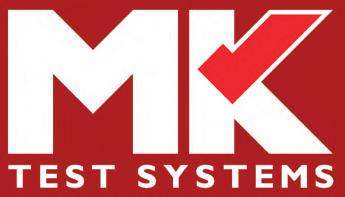

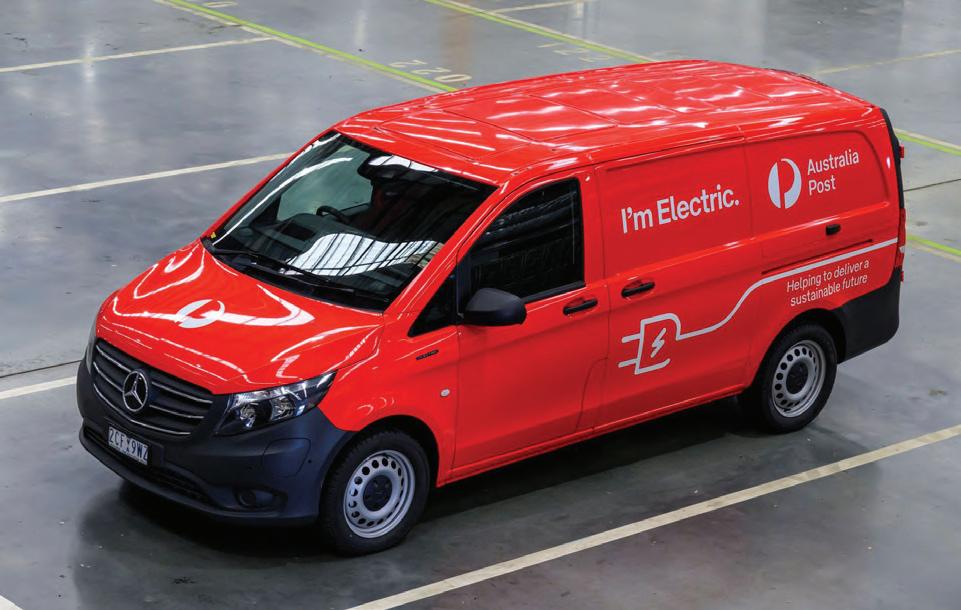
Australia Post has begun a pilot deployment of 36 Mercedes-Benz eVito electric vans. e agency’s existing eet includes some 3,600 three-wheeled delivery vehicles and several Mitsubishi eFUSO electric box vans. is will be its largest electric van trial to date.
Mercedes’ eVito features a 60 kWh battery pack and an 85 kW (115 hp) motor. e company’s factory up t program, Mercedes-Benz Vans Courier Solutions, allows customers to spec out their vans exactly the way they want them. Australia Post will work with the automaker to train team members and support the smooth introduction of the new electric vans.
Australia Post expects the eVito electric van’s 162-mile range to be su cient for the stop-and-go duty cycle of a delivery vehicle. Could drivers actually see more real-world range? at’s the sort of question this 36-van pilot is meant to answer. e vans will be powered by 100% renewable electricity, thanks to Australia Post’s existing charging infrastructure.
“ is is a meaningful step forward as we continue building a modern, sustainable delivery network that meets the evolving needs of our customers while reducing our environmental impact,” said Australia Post Chief Sustainability O cer Richard Pittard.
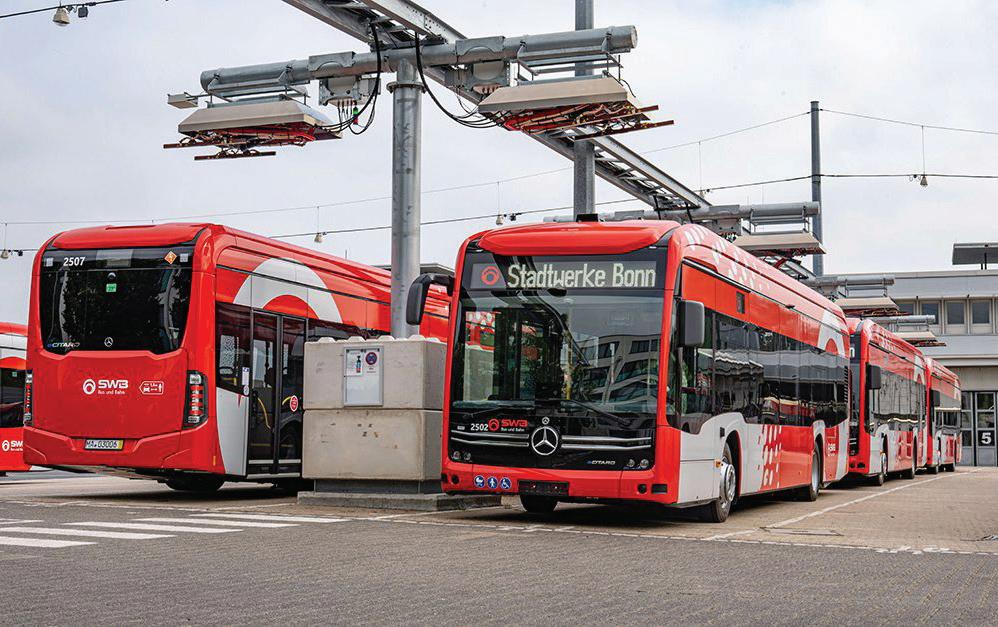
Daimler Buses has delivered ten battery-electric 12-meter Mercedes-Benz eCitaro city buses to German transit agency Stadtwerke Bonn (SWB). Daimler has also delivered a turnkey charging system with ten charging points.
e eCitaro buses will be used in scheduled service in the city of Bonn, coexisting with electric buses from other manufacturers, which have been part of the SWB eet for several years.
Daimler Buses assumed overall responsibility for all planning, civil engineering and construction services in this project, which will result in the gradual electri cation of all of Bonn’s buses.
Each of Bonn’s eCitaro buses features ve NMC3 battery packs with a total capacity of 490 kWh. Each can be charged via a CCS2 charging socket or via a roof-mounted pantograph system.
e charging infrastructure at the SWB depot in Friesdorf comprises two CCS2 charging points and eight pantograph charging points. e pantographs are mounted on a steel traverse, which is equipped with mobile concrete foundations, making the structure “reasonably easy to move to another location” if desired.





European parcel delivery rm DPD has tested the YT203-EV electric terminal tractor (o en called a tug in Europe) from Dutch rm Terburg at its hub in Oldbury, UK.
DPD runs a eet of more than 50 tugs to move trailers at its ve centralized sorting hubs in Oldbury, Smethwick and Hinckley in the UK. e company is keen to understand how the electric vehicle could help as part of a move to a more sustainable HGV eet in the longer term.
e model tested was tted with two 78 kWh batteries and comprehensive regenerative braking. e YT203-EV can be charged at standard DC charging stations.
e Royal Terberg Group specializes in the development, production and modi cation of special transport vehicles and systems for port terminals, logistics and waste collection. e YT203-EV o ers performance similar to that of a diesel engine, while delivering the potential for more sustainable shunting as well as a better working environment for drivers, according to the company.
“Clearly there are major advantages to the EV version in terms of emissions and the working environment for our drivers, but it was also really good to understand how the vehicles operate in a real-world scenario, including how they can be charged e ectively during the day to maximize working hours,” said Tim Jones, Director of Marketing, Communications & Sustainability at DPDgroup UK.

US-based EV manufacturer GreenPower Motor has signed a contract with the state of New Mexico to implement an electric school bus pilot project.
e two-year pilot project will deploy three GreenPower Type A Nano BEAST Access school buses in the 2025-2026 school year and three GreenPower Type D BEAST and Mega BEAST school buses in the 2026-2027 school year. e Mega BEAST delivers a range of up to 300 miles from its 387 kWh battery pack.
e contract between GreenPower and the state of New Mexico provides more than $5 million for the purchase of vehicles, cost of charging infrastructure and overall management of the pilot. Based on voluntary requests to participate, school districts are currently being selected by the state to participate in the pilot.
e school buses will rotate around the state in ve six-week pilot rounds each school year. GreenPower will install charging systems, provide training for the drivers, mechanics and the community’s rst responders, and help ensure a seamless testing period.
GreenPower is partnering with Highland Electric Fleets to install and implement the necessary charging infrastructure. e pilot will include DC fast chargers and Level 2 AC chargers for the Nano BEAST Access school buses, and will evaluate DC fast charging in the second year with the BEAST school buses. ere will also be a vehicle-to-grid (V2G) evaluation in the second year using the Mega BEAST.
“ e project is leveraging the successful pilot that GreenPower conducted in West Virginia, but also has a concentration on evaluating charging options and infrastructure,” said GreenPower President Brendan Riley.
Electric heavy trucks are rapidly gaining market share in China, driven by subsidies and the quick rollout of chargers. Reuters reports that this is cutting into diesel usage and denting oil demand from the world’s biggest crude oil importer.
EVs aren’t the only factor in the diesel decline—the rise of LNG-powered heavy trucks and recently, slowing economic growth, have also reduced demand for diesel. But surging sales of EVs are causing analysts to revise previous projections. Consulting rm Sublime China Information (SCI) estimates that sales of new energy trucks rose 175% year-over-year in the rst half of this year, representing about a quarter of new truck sales. Battery-electric models, mostly used for short-haul runs around ports, mines and factories, accounted for over 90% of that increase.
SCI analyst Xu Lei told Reuters that the rm has cut its forecast for China’s diesel demand by 1%-2%. Diesel consumption this year is now forecast to fall by 6.3%. A similar decrease was seen last year.
“ e surge in electric heavy trucks was a surprise and has become a new factor accelerating China’s oil consumption to peak, most likely this year,” Ye Lin, VP of Rystad Energy, told Reuters. Rystad expects China’s transport sector to use 40% less diesel by 2030, cutting overall consumption by about a quarter compared to 2024 levels.
e bull market for electric trucks is partly due to cheap electricity and government subsidies of up to 95,000 yuan ($13,264) for new vehicles. China’s rapid rollout of charging infrastructure along industrial corridors is another factor. Infrastructure provider Teld has built more than 2,400 truck charging stations across China, and recently opened an 800 km corridor linking Shanxi and Shandong provinces, a key route through the country’s coal-producing region.
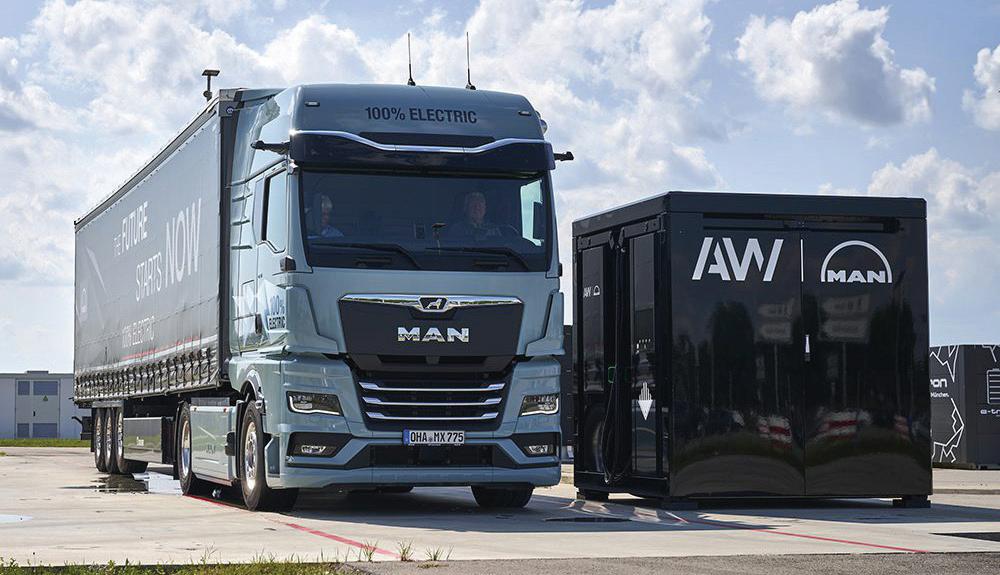
Shortly a er bringing a line of electric semi-trucks into production, German truck manufacturer MAN Trucks, in cooperation with AW Automotive, has introduced a mobile battery energy storage system (BESS) designed to bring charging for heavy-duty vehicles to remote sites.
As Autoweek reports, MAN’s Smart Charging Cube is designed to be operated almost anywhere, with no need for a grid connection. It includes a stationary battery ranging in capacity from 500 kWh to 1,100 kWh, coupled with as many as four CCS charging ports with a power capacity of up to 400 kW.
e Smart Charging Cube can also support the Megawatt Charging System (MCS), which can deliver over 1,000 kW of power (few current EVs can take advantage of such high charging speeds, but automakers and infrastructure providers have plans to roll out MCS rapidly over the next few years).
“ e Smart Charging Cube can integrate self-generated electricity, for example from photovoltaic systems,” says MAN. “In addition, various charging functions are possible, including peak shaving, dynamic power consumption and bidirectional charging.”
e truck maker plans to sell, rent or lease these cubes to customers. A natural t would be the construction industry, which o en needs to operate excavators and other equipment at remote sites away from grid connections.
e cubes can be trickle-charged from grid power connections at currents from 32 A to 630 A, or paired with portable solar panels or other power sources.
Volvo has recently developed a similar cube aimed at the same sort of o -grid applications.




New York Governor Kathy Hochul has announced that an additional $200 million is now available for zero-emission school buses through the third installment of funding from the $4.2-billion Clean Water, Clean Air, and Green Jobs Environmental Bond Act of 2022.
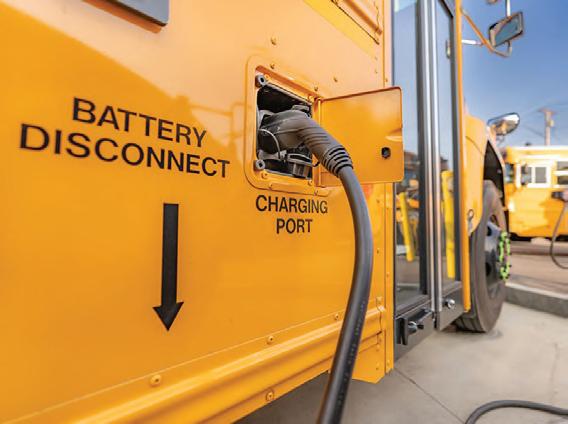
e funding, distributed through the New York School Bus Incentive Program (NYSBIP), supports the purchase of electric buses, charging infrastructure and eet electri cation planning.
Administered by the New York State Energy Research and Development Authority (NYSERDA), NYSBIP provides incentives to eligible school bus eet operators, including school districts and school bus operators, that purchase zero-emission buses. It also o ers charging infrastructure vouchers to help support the installation of Level 2 or DC fast chargers, and provides funding to develop Fleet Electri cation Plans, which provide a customized roadmap for electric bus adoption.
e funding is available on a rst-come, rst-served basis. Incentive amounts cover up to 100 percent of the incremental cost of a new or repowered electric school bus, helping to o set some or all of the di erence in purchase price between zero-emission buses and legacy ICE buses.
Program eligibility criteria and rules can be found in the NYSBIP Implementation Manual. Fleet operators do not apply directly for funding—vehicle dealers apply the incentives to the price of buses a er eet operators have issued purchase orders. Fleet operators apply directly to NYSERDA for charging vouchers, which support adding charging infrastructure to their depots.
Larger funding amounts are available for high-need school districts and school districts with signi cant portions of their population living in disadvantaged communities. Furthermore, all school districts can earn increased incentives by removing a gas or diesel bus from operation, purchasing wheelchair-accessible buses, or purchasing buses with vehicle-to-grid capability. School districts that complete eet electri cation plans also become eligible for higher funding amounts.
Since NYSBIP’s launch, 88 school districts have applied for funds to purchase 529 buses, which includes 50 priority school districts accounting for 406 buses, and 400 districts are now working with NYSERDA to create Fleet Electri cation Plans.
New York State provides many resources for school bus eet operators to transition their eets, including an Electric School Bus Guidebook. Fleet operators seeking assistance can contact NYSERDA at schoolbus@nyserda. ny.gov.

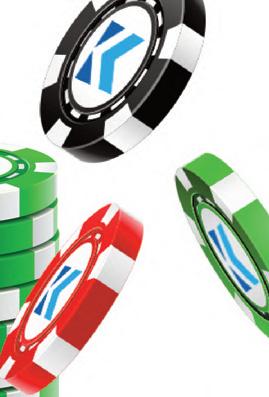










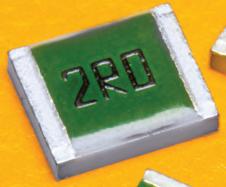








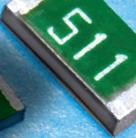



New York state transit operator Su olk County Transit has awarded NFI Group, a supplier of propulsion-agnostic bus and coach mobility solutions and a subsidiary of New Flyer of America, a contract for up to 132 buses over the next ve years, including 40 Xcelsior CHARGE NG electric buses and 92 Xcelsior hybrid buses.
e latest order was added to New Flyer’s backlog in the rst quarter of 2025. It adds to the 73 New Flyer Xcelsior hybrid buses that Su olk County Transit already has in service in Su olk County, New York.
In addition to vehicle manufacturing, New Flyer supports its partners with services including parts, infrastructure planning, workforce development and nancing.
“New Flyer’s common Xcelsior platform enables agencies to operate hybrid and battery-electric buses with shared parts, tools, and training—delivering real operational savings while maintaining consistent, high-quality performance,” said Chris Stoddart, President, North American Bus and Coach, NFI.

US construction company McKinstry has “reached a major milestone on its path to a zero-tailpipe emissions eet,” taking delivery of its 100th Chevrolet Silverado EV. e company now has a total of 114 EVs in operation, including Chevy Blazer and Equinox EVs as well as BrightDrop 600 and 400 vans.
“McKinstry is putting EVs into action,” said President and CFO Joseph Hagar. “Each EV advances innovation on our jobsites. ese are more than trucks, SUVs and vans—they’re mobile workstations driving real impact.”
Nearly three-quarters of McKinstry’s EV eet is used in the eld, mostly by plumbers, electricians and sheet metal technicians. Each vehicle has been up tted to meet the demands of speci c trade work—custom features include heavy-duty toolboxes, bed slides that double as workstations, and onboard power systems for running specialty tools.
Electric vehicles are currently deployed across McKinstry operations in Washington, Oregon, Colorado and Texas. e company is installing extensive EV chargers at its facilities across the country and exploring innovative solutions for o site charging.
“Our employees love the transition to EVs, and we’re pushing to bring the industry along with us,” added Hagar.





How far can an EV potentially travel on a charge? e answer seems to be: “farther and farther every year.”
GM engineers recently set what they say is a new world record for EV range. A 2026 Chevrolet Silverado EV Work Truck achieved 1,059.2 miles on a full charge, surpassing Lucid’s previous record of 749 miles.
e Silverado EV WT has an EPA-estimated range of 493 miles. GM’s engineers set out to squeeze out every possible mile by optimizing the vehicle for e ciency. Over 7 days, some 40 engineers drove a Silverado on public roads near GM’s Milford Proving Ground and Detroit’s Belle Isle. ey made no modi cations to the truck’s drivetrain or so ware, but made only “replicable adjustments well within the real-world capability of Silverado EV owners.”
at said, this was an experiment, not a prescription for maximizing range in real-world driving. e testers drove at a maximum speed of 25 mph. e test was made in summer (for the optimum ambient temperature for battery e ciency), with climate control turned o . Tires were in ated to their highest workable pressure, the spare tire was removed, and a tonneau cover was added to improve air ow.
Could you double your EV’s range by driving really slow with the AC o ? EV geeks will doubtless have fun trying, but the real point of GM’s test (in addition to getting a tremendous amount of publicity) was to “provide valuable insights for future product development.”

Joby Aviation, a maker of electric vertical takeo and landing (eVTOL) air taxis for commercial passenger service, has entered into a de nitive agreement with Blade Air Mobility, an urban air mobility company, to acquire Blade’s passenger business.
“Blade was founded with the mission of democratizing short-distance air travel by facilitating the transition from conventional rotorcra to quiet, emissions-free electric aircra , and I believe there is no better partner than Joby to make that mission a reality,” said Blade’s CEO Rob Wiesenthal.
Blade’s passenger unit o ers air transportation of up to 100 miles (161 km) for travelers and last-mile critical cargo using helicopters and amphibious seaplanes for passenger routes in the United States, Canada, Southern Europe and India. Blade has terminals in New York City, Vancouver and several locations in Southern Europe.
In 2024, Blade reported that it ew more than 50,000 passengers from a network of 12 urban terminals, including dedicated lounge and terminal bases at John F. Kennedy International Airport and Newark Liberty Airport, as well as the West Side of Manhattan, the East Side of Manhattan and Wall Street.
e CEO of Joby, JoeBen Bevirtt, termed the deal “a strategically important acquisition,” adding that, with access to the infrastructure and customer base Blade has secured, “we will be in the best possible position to launch our quiet, electric aircra as soon as certi cation is secured.”
e company’s medical division, which was not included in the transaction and will remain a separate public company, has announced plans to partner with Joby on medical transportation for patients and organ transplants.







This largish “compact” crossover SUV is luxurious, quiet, and offers substantial range along with premium features, making it a truly competitive luxury EV—and shoppers are noticing.






The Optiq could become the luxury brand’s highest volume vehicle worldwide.






By John Voelcker
The conversion of GM’s luxury brand Cadillac to an all-electric product line has been a quietly seismic event over the last decade.
e brand is nding (it says) newer, younger and more tech-forward buyers, versus the aging customers who bought its luxury land barges of yore. But while the Lyriq mid-sized crossover SUV went on sale in July 2022, the electric model that may be Cadillac’s most important EV globally didn’t land in showrooms for more than two years a er that.
e Optiq, a largish “compact” crossover SUV, could become the luxury brand’s highest-volume vehicle worldwide. At a US starting price of around $50,000, the Optiq is the most a ordable Cadillac EV. But it’s also assembled in Mexico, making it subject to tari s when or if the ever-shi ing landscape of trade policy settles down. Still, by the second quarter of this year, it was Cadillac’s second-best selling electric model in the US a er the well-established Lyriq.
e Optiqs we’ve driven have been calm and quiet inside, with elegant fabrics and trim to cosset occupants. Overall, the Optiq is perfect for long-distance travel or around-town use—and perhaps the best environment for GM’s excellent Super Cruise hands-free adaptive cruise control, which now includes automatic lane changes.
Cadillac’s small SUV isn’t perfect: the exterior styling is more of a judgment call, and the rear quarters are downright peculiar. It’s missing a front trunk and a rear
This is the smallest and shortest Cadillac, and the front two-thirds of the Optiq largely echo the other EV models in the lineup.
wiper, and neither Android Auto nor Apple CarPlay can be included (in the US) no matter how loud buyers scream. Acceleration of the standard versions is deliberate, though we’ve not yet driven the Optiq-V performance model. at one received rave reviews from both bu books and general outlets.
Two thirds handsome?
is is the smallest and shortest Cadillac, and the front two-thirds of the Optiq largely echo the other EV models in the lineup. It’s at the rear where things start to go wrong—perhaps from designers trying too hard to be avant-garde in the brand’s shortest vehicle. e combination of a beltline that kicks up, the very short overhang behind the rear wheels, the signature vertical rear lights running up the side of the tailgate, and a strange pattern on the third side windows that superimposes lines that aren’t actually horizontal is just incoherent.


It o ers a little too much visual stimulation in too small a space. e rest of Cadillac’s electric SUVs, as well as the Celestiq ultra-luxury sedan, use the same design cues to better and more pleasing e ect.
With a high beltline, only the Optiq’s glass roof gives the interior enough light to prevent a slightly claustrophobic feel. Once you get there, though, the interior is splendid. Fabrics feel like real woven cloth, though they’re auto-interior-grade durable, and Cadillac has pulled o the delicate act of using mild bright-blue accent trim just enough—but not too much. US buyers historically haven’t cared about the sustainability of a car’s interior, but the Optiq uses what it calls PaperWood veneer (ingredients include tulip wood and recycled newspaper) and patterned accent fabrics made of yarn from 100% recycled feedstock.
An 85-kilowatt-hour battery pack powers two drive motors with combined output of 224 kilowatts (300 horsepower) and 354 pound-feet (480 newton-meters) of torque. All-wheel drive is standard. Acceleration of the standard Optiq can best be termed deliberate. It’s ne for standard use, and—if any Cadillac owner ever uses it—the Sport mode adds some punch. e standard Optiq just doesn’t o er the kind of kick-inthe-back acceleration found in Teslas. at’s le to the recently announced Optiq-V performance model, whose power rises to 382 kW (519 hp) with 650 lb- (880 N-m) of torque. Cadillac says the Optiq-V will rocket from 0 to 60 mph in 3.5 seconds if drivers use its Velocity Max mode. e Optiq-V goes into production this autumn as the priciest model in the Optiq range, starting at $68,795, with a range that GM estimates at 275 miles.
e compact Cadillac holds the road ne and is easy to drive—the weight and suspension are tuned to make potholes less jarring and smooth bad road surfaces. GM has superbly calibrated regenerative braking and one-pedal driving algorithms, and the Optiq’s learning curve overall shouldn’t be as steep as that for a Tesla or other entirely screen-based EVs.
e Optiq hardly leads the pack on charging speed, however. e di erence in fast charging times is only a few minutes, but Cadillac is behind in the specs war against 800-volt EVs like the Genesis GV60, which charges at up to 300 kilowatts. On our Optiq road test, the fastest rate we saw was 107 kW (at a station rated for 150 kW)




The recently announced Optiq-V performance model will rocket from 0 to 60 mph in 3.5 seconds if drivers use its Velocity Max mode.
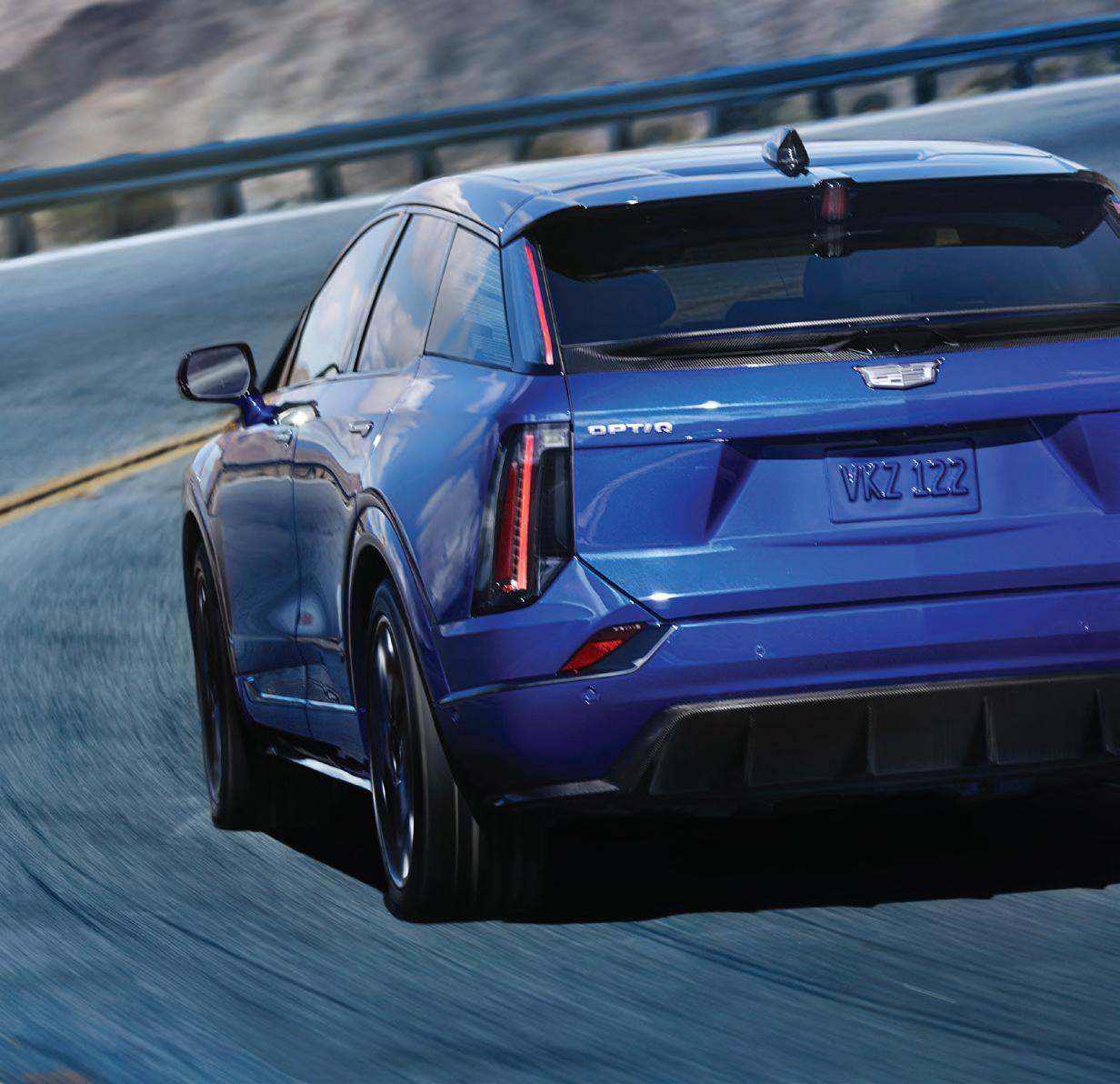


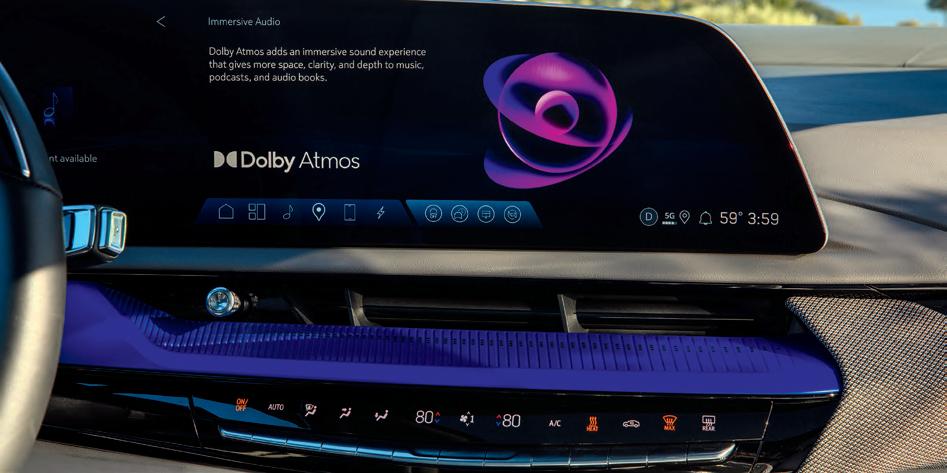
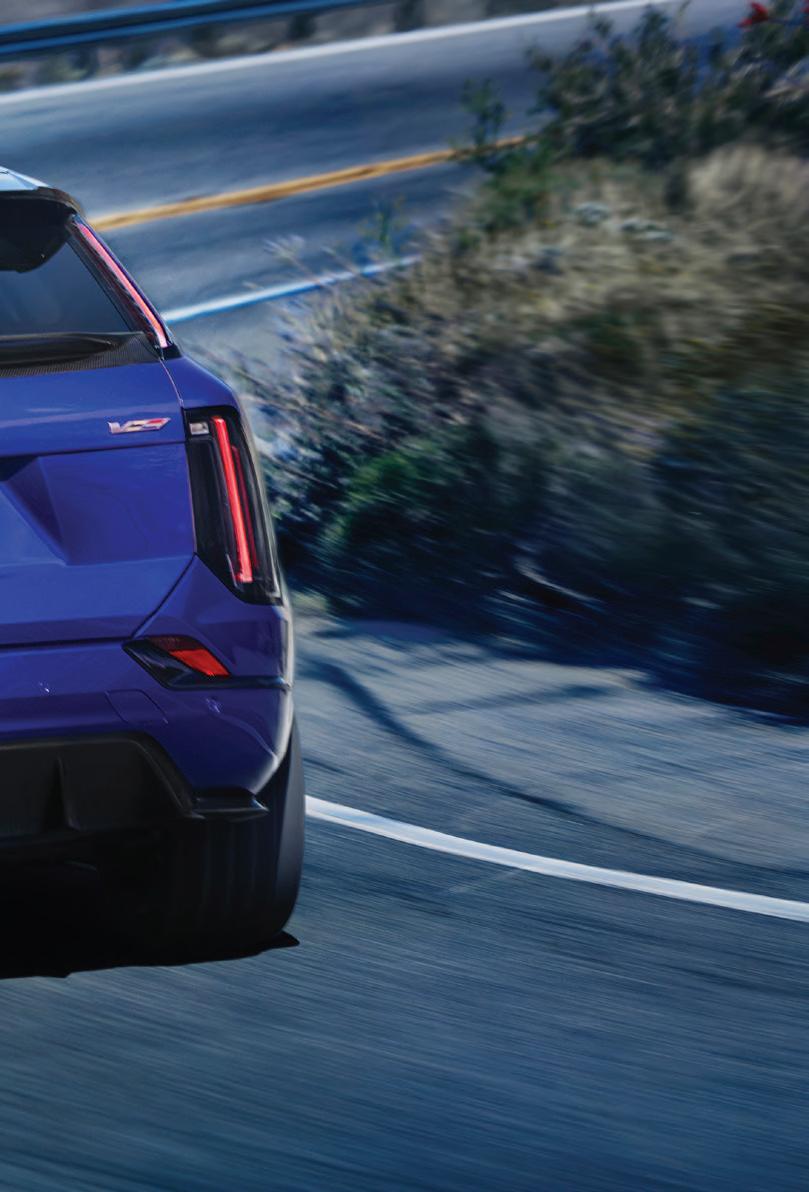





while taking the battery from a 25 percent to a 60 percent charge—a er preconditioning before we arrived at the charging site. Cadillac claims the Optiq can gain up to 79 miles of range in only 10 minutes, though that’s the usual manufacturer statistic achieved under ideal circumstances of battery temperature, ambient temperature and low state of charge. As they say, your mileage may vary. e onboard AC charger is capable of up to 11.5 kW.
Optiqs built through most of 2025 use a CCS fast charging port. However, the upcoming Optiq-V will have a native NACS (SAE J3400) connector built in—the rst GM electric vehicle so equipped. e company said in June 2023 that it would adopt NACS across its portfolio. Now, more than two years later, it’s starting to happen; the rest of the Optiq line will likely follow suit.
e combined range rating from the EPA presently sits at 302 miles, which likely means around 260 miles at highway speeds using climate control. Crucially for road trips, that’s still beyond the distance many drivers can comfortably go without a rest stop.

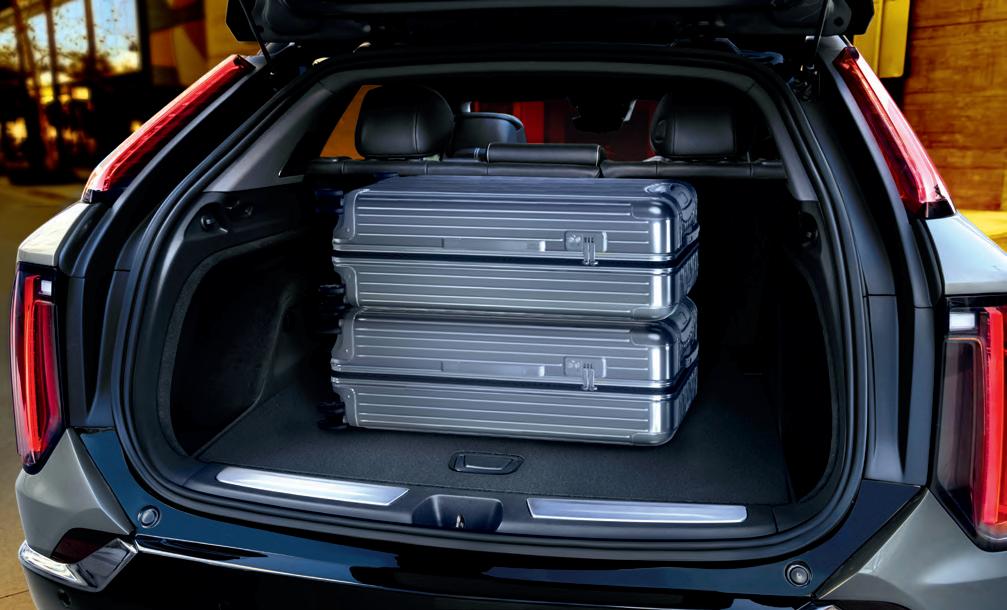
Optiqs built through most of 2025 use a CCS fast charging port. However, the upcoming Optiq-V will have a native NACS (SAE J3400) connector built in—the fi rst GM electric vehicle so equipped.
Interior space in the Optiq is ample for four. It’s large enough, even as a so-called compact SUV, to accommodate three people in the rear seat without making them elbow or jostle each other. But like all of GM’s current EV lineup except for the huge trucks, the Optiq has no front


Google Maps in the dash routes the Optiq among charging stations en route and notes a charging site is “slow,” “fast,” or “very fast.”
trunk—a missed opportunity to underscore an EV advantage that cars with combustion engines simply can’t o er.
e Optiq also lacks a rear wiper, whereas the Chevrolet Equinox EV that shares its basic understructure has one as standard. e luxury brand claims air ow through the Optiq’s “rear ow-through spoiler” directs air over the glass at a high enough velocity to keep the rear window clean. A er several spring deluges en route, we disagree. Cadillac also suggested that we use the video rear-view mirror function (instead of a rear window we could see through).
e Cadillac Optiq is probably one of the quietest cars we’ve ever driven, even for an EV. e experience of driving or riding in an Optiq is calm, smooth, pleasant, and altogether nice inside. at makes it an easy vehicle in which to cover miles—especially with the Super Cruise hands-o adaptive cruise control. Many analysts view Super Cruise as the best of the small number of hands-o adaptive cruise control systems o ered in cars.
For the last year or so, the system has included automatic lane changes: it will check to ensure the overtaking lane is clear, signal, change lanes, pass the other car, then return to the slower lane. ( at last step will be particularly appreciated by everyone who’s sat behind a driver going far too slow in the fast, or overtaking, lane.) Cadillac and other GM brands alert the driver to both lane departures and upcoming lane changes by vibrating the driver’s seat bolster on the relevant side. at conveys the message to the driver, without alerting other occupants as audible warning tones do. Drivers appreciate that.
Google Maps in the dash routes the Optiq among charging stations en route once drivers enter a destination into the system that exceeds the car’s range. Anyone who’s used Google Maps before will nd that the mapping and routing works predictably enough, though it’s still not
quite up to Tesla standards of seamlessness. Nor are the various charging stations among which the Optiq routes itself, operated by multiple networks, nearly as reliable as Superchargers. e system notes a charging site is “slow,” “fast,” or “very fast”—and importantly, it preconditions the battery automatically if it knows it’s headed for a DC fast charging site.
One feature most buyers will likely expect—but not nd—is phone mirroring into the central touchscreen via Android Auto or Apple CarPlay. Tesla, Rivian and Lucid have never o ered mirroring, and GM has chosen to remove it from its latest electric vehicles (in the US—it’s still right there in the dash for buyers in at least some other countries).
So, drivers and family members will have to remember their user names and passwords for the dozen or more apps in the dash they use regularly. (Do you remember your Spotify login info?) e Optiq gives access to those apps via its cellular connection. For three years. en the hammer comes down: owners who want to continue to use their apps must pay Cadillac to continue to receive “App Access” beyond that. e fee is $15 each month, or it can be bundled into plans for OnStar and other features. Note that the App Access fee is on top of the $25-per-month cost to continue Super Cruise, which has its own 36-month free trial period.
Both luxury cars and EVs have higher leasing rates than other models, so we surmise the rst buyer won’t have to worry over the three-year lease—and GM doesn’t sell new cars to those who will buy these models used. Except now it can target them as a source of recurring monthly fees. Why did GM do this? It’s one aspect of the “digital services revenue” that carmakers promised the nancial world would earn them billions of dollars a year in new revenue. Buyers are the losers here; they must pay a monthly fee for a feature they used to get for free. Or revert to the distraction of a handheld phone, the reason phone mirroring was invented in the rst place.
A er spending eight days and 840 miles in an Optiq around New York City and environs, including forays into the rural agricultural regions of the state, we think it shows real promise. It’s quiet, comfortable, and wellsuited to highway miles. Our few reservations sit with its so ware, and that has to be a matter for the paying customers to take up with GM.








The Cadillac Optiq is probably one of the quietest cars we’ve ever driven, even for an EV.






By Charles Morris

Powered trailers offer a painless path to electrifying heavy-duty transport.
Trucking rms are caught in a bit of a bind. ey need to electrify before their competitors do, or risk being undercut on the allimportant metric of cost per mile—however, electric trucks come with high upfront costs, and when it comes to long-haul Class 8 trucks, range, weight and charging infrastructure remain challenges.
What if you could eliminate those objections by thinking outside the box—or by electrifying the box itself? at is, why not electrify the trailer instead of the tractor? If you could add batteries and a motor to a trailer, you could realize substantial fuel savings while continuing to use your existing tractors.
A powered trailer, which incorporates a battery pack and an electric motor, o ers several advantages as an alternative to (or in addition to) an all-electric truck. It’s a drop-in replacement for existing trailers that can be used with any tractor—diesel or electric. ere’s little or no learning curve for drivers. Range is not an issue—if the trailer’s battery runs out of juice, you simply keep rolling. Charging is much less of an issue—a trailer can be charged while loading or unloading, while the tractor drives o to pick up another load. And as we shall see, a powered trailer can include intelligent features that help to make the driving experience easier and safer.
At the moment, there are two companies selling powered trailers—US-based Range Energy and Germanybased Trailer Dynamics (both companies are currently taking orders, but deliveries have not yet begun). Both companies have designed their trailers to pull their own weight, so to speak. Range Energy says its system provides “just enough propulsion to make the trailer feel weightless to whatever is towing it.” As Trailer Dynamics puts it, “ e eTrailer is designed to cancel out all its driving resistance on routes of 500-800 km.”
A third company, Revoy, o ers a variation on the concept—a powered dolly that ts between tractor and trailer, in e ect converting a diesel tractor into a hybrid. In addition to delivering fuel savings, all three of these companies’ products are designed to interact with the tractor to improve handling and safety.

ere are also companies developing electri ed Transport Refrigeration Units (TRUs), which today are powered by built-in diesel generators.
California-based Range Energy, founded in 2021, has developed an eTrailer system that can be installed on any dry van or refrigerated semi-trailer. “We think of it as a less burdensome version of electri cation,” Chief Product O cer Jason Chua explained to Charged. “You can hook up your accessories, like a TRU, a li gate or whatever, and then you’re o and running.”
e system, which adds about 5,500 pounds of weight to the trailer, is composed of three major components.
e rst is an electri ed axle, currently provided by Tier 1 supplier ZF. “We are able to use other OEM eAxles, but ZF is what we’re launching with,” Chua told us. “ e second component is a high-voltage battery pack—either 200 or 300 kilowatt-hours, but I think early units are probably going to ship with a larger battery pack.
e third component is our safety controls system and sensor suite. It’s the world’s rst trailer traction control

Range Energy has demonstrated a 60-to-70% increase in MPG while also powering a refrigeration unit in 100% electric operation.
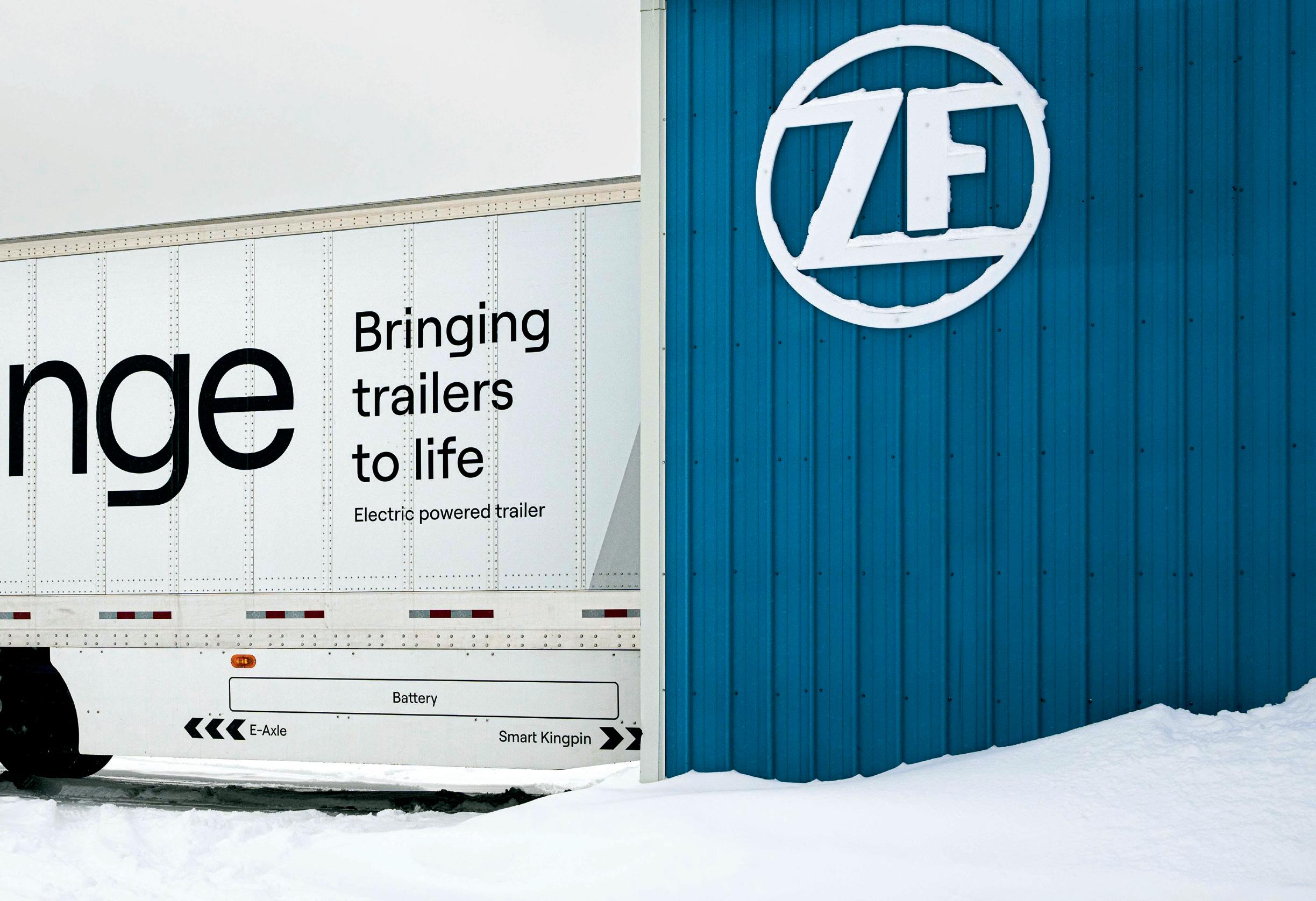

system, so we can do stability work and braking.”
Range is starting out by selling directly to carriers. “Shippers are sometimes involved, and trailer OEMs can be channel partners—we’re collaborating with some of them for testing. But this is a new product category, so we want to get out there and work with eets, educate them on what we’re doing, get a better understanding of how they run their business, and make sure that we have a really good t.”
Over the past few months, Range has been taking its
beta units on the road with customers for pilots, and has demonstrated a 60-to-70% increase in MPG while also powering a TRU in 100% electric operation.
ere are a lot of trailers out there, with many different speci c con gurations of things like rail pitch, li gate specs and door positioning—that’s why Range opted to go with a retro ttable system rather than selling complete trailers. “ at allows us to get this technology deployed faster than the typical replacement age for trailers, which could help us scale quite quickly,” Chua told us.
“Our system is designed to be installed in just a few hours with one or two people using a forkli , so this is something you could do at a dealer location. e battery bolts on to the bottom of the trailer. e eAxle you just swap out with the forward axle on the trailer bogie. You connect the two, and the sensors are already integrated into the system, so that’s about it.”
In addition to saving money and reducing emissions, Range Energy’s trailer can adjust torque and braking in real time to improve safety and the driving experience. We were surprised to learn that this requires no data connection between the tractor and the trailer.

A standard semi rig has a connector between tractor and trailer that operates brake lights and the ABS system (it uses the SAE J560 standard). “It’s an electrical connector, it’s not really a data connector,” Chua explained. “You might see other similar systems connected with a CAN bus, but Range’s system doesn’t require that. It’s just the air lines, the brake lights (the J560 connector), and of course the kingpin, and those are the only points of connection between the tractor and the trailer with our system.
“We are able to sense when the driver’s trying to brake from the tractor, and we react quite quickly to those signals. One of the things that we wanted to avoid is new standards, new connectors, training the driver to plug one more thing in. Truckers have a complicated enough job as it is, and our goal is to make this as simple as possible.”
Range’s system can provide extra torque when needed, for example to provide additional acceleration to climb a hill, or to make shi ing gears smoother. e system also intelligently manages regenerative braking to improve traction and stopping distance.
Mr. Chua showed us a video of winter testing the company did in northern Michigan to validate the trailer’s traction control. “We did some stopping distance tests, we did some evasive maneuvers, and in pretty much all cases, we saw performance improvements with
our system. It has a very fast reaction time and we have a good understanding of the environment with respect to things like how slick a surface is and what the cornering force looks like.”
How does all this work with no data connection?
“ at’s our secret sauce,” Chua told us. “We have a distributed network of sensors that allows us to understand what’s going on with the relative motion of the trailer and the tractor. Using that information, we can send commands to the powertrain to provide drive torque or regen-braking torque as appropriate.”
Range Energy President and CTO Ali Javidan identied another bene t of powered trailers in an interview with Clean Trucking: “Because the tractor sees a lot less load, we have customers saying, now we can buy the smaller block engine. Our transmissions are lasting ve times longer because we’re not wearing through clutches in between shi s. Our brake duty cycle is 3 to 5 times longer because we’re using regen instead of friction brakes.”
Yet another of the advantages of electrifying the trailer instead of the tractor is that it makes charging simpler. “Tractors tend to be in motion a lot more often,” Jason Chua told Charged. “Trailers sit around for 8 to 12 hours a day, because it takes some time to load and unload the trailer.”
Trailers also don’t require the heroic levels of charging




The only points of connections between the tractor and Range’s trailer system are the air lines, the brake lights and the kingpin.
power that heavy-duty trucks do. “Our 300 kWh battery pack is large, but it’s not massive. Our system doesn’t require the sort of heavy charging infrastructure like the Megawatt Charging System [MCS] that you’d need for charging electric tractors.”
Range recently announced a partnership with ermo King, a Minnesota-based manufacturer of transport temperature control systems. e company already has a hybrid TRU, which Range is integrating with its system.
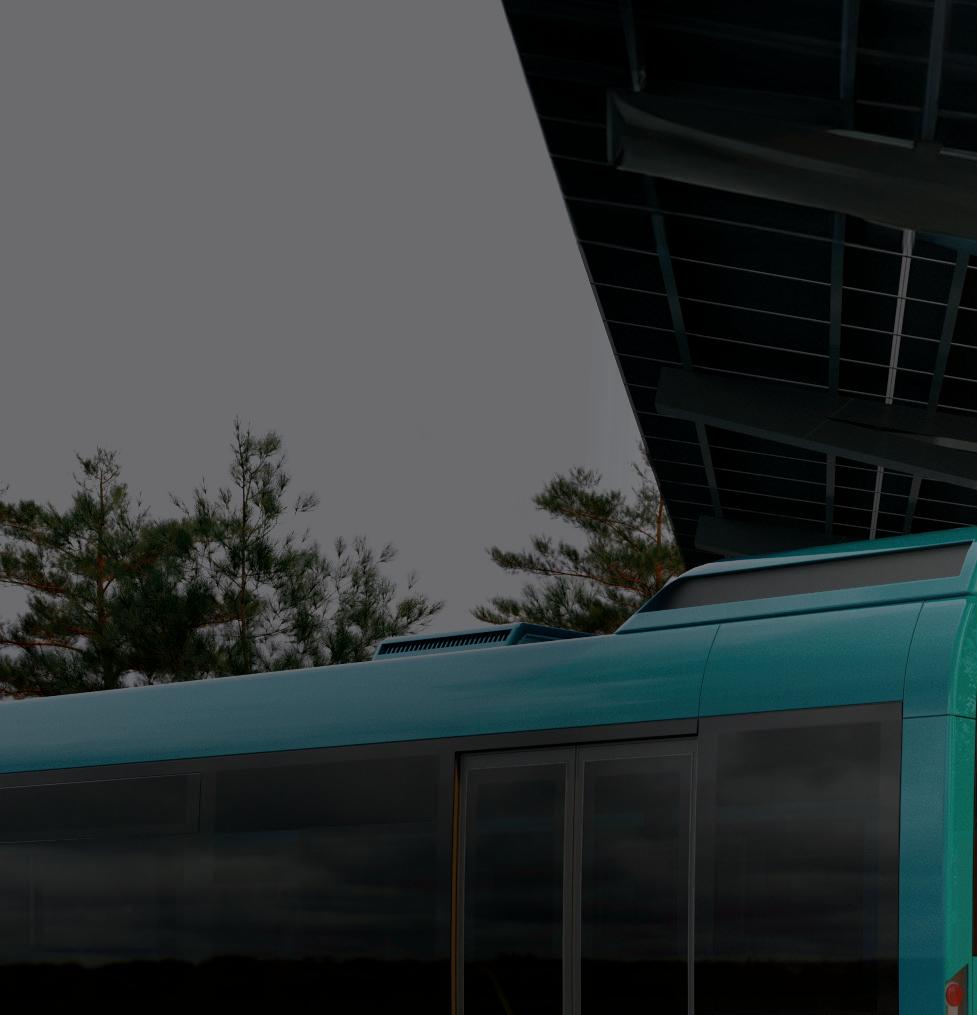

“ ermo King’s TRUs can run in either diesel or electric mode,” Chua told us. “When you’re at the dock plugged into shore power, they run on electric. We enable that electric operation even while the trailer’s in motion.”
ermo King has an extensive dealer network, including shops where equipment can be installed. “ ey’re rolling out high-voltage training across their dealer network. ey really are leaning forward on electri cation, and we can bene t from that. Rather than stand up hundreds of dealer locations across the country, we can leverage a great partner that already has them, and enable installation, distribution, service and a er-sales with people that these eets already know.”
Chua sees several reasons to target the refrigerated transport (aka cold chain) market. “I think some of the rst adopters we’re going to see are food service distribution eets. ey have a great use case for eTrailers in terms of route length and stops. We can save a lot of fuel from the reefer unit, and these are folks that tend to be early adopters of new technology.”
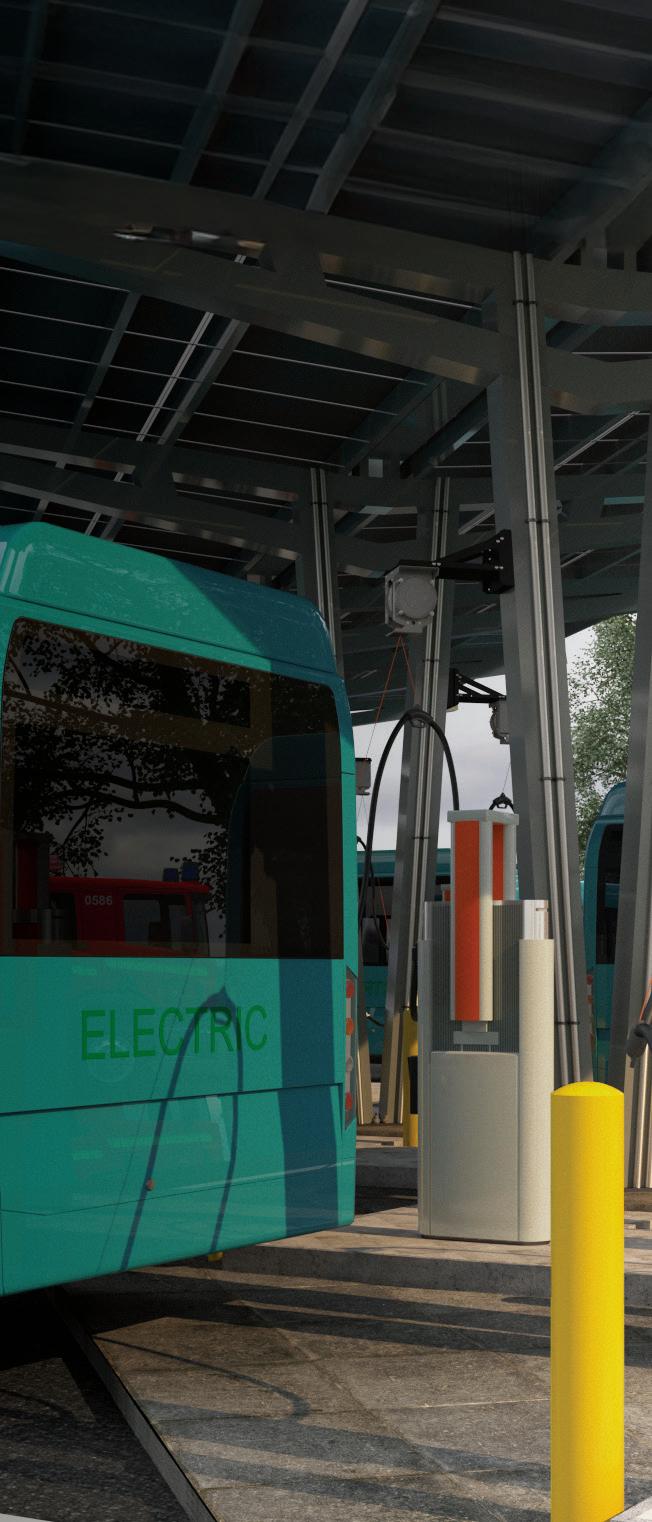


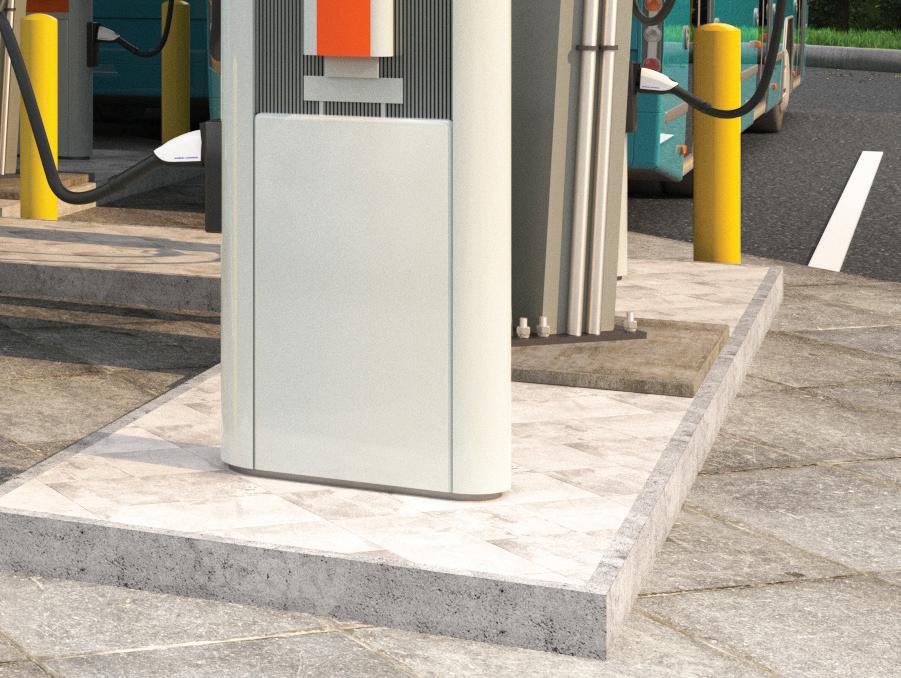

Targeting refrigerated eets also presents advantages in respect to charging. “Lots of these eets have refrigerated warehouses, which already have a decent amount of power available to them. ey also have what’s called shore power. e plug at the dock that you plug your refrigeration unit into, we can use that same circuit to charge our system. We can charge with DC or AC.”
Range is currently conducting extended pilots with “some of the largest eets in the country.” Chua told us that the company is ramping up its manufacturing process, and plans to begin deliveries “some time in 2026.”
So, how much does the system cost? Chua told me in a roundabout way. “We’re looking at a four-to- ve-year payback period today. As we scale, our costs will decline and we’re going to get closer to a three-year payback. But right now we’re seeing about a $25,000-per-year net savings per trailer, and you can do the math.”
We can, and it works out to $100,000 to $125,000 for Range Energy’s system (which can be added to a new or existing trailer). Chua told us that, for a new refrigerated trailer, a company would typically pay somewhere between $150,000 and $200,000, depending on the refrigeration unit, li gates and other accessories required.
At the moment, Range has only one major competitor, and it’s on the other side of the Atlantic. “Trailer Dynamics is covering Europe, we’re covering North America,” says Chua. “Will we look at Europe in the future? Will they look at North America in the future? I think that’s all TBD, right?”
Another way of saving energy in transport doesn’t involve propulsion, but rather cooling. Today, keeping food (or medical supplies or other products) chilled or frozen during delivery means running diesel engines on the back of trucks—burning fuel even when vehicles are stationary. In addition to ermo King, several other companies are testing electric or TRUs.
UK supermarket chain Tesco is testing electric refrigeration technology from British engineering company Sunswap, which incorporates batteries and roof-mounted solar panels. Italy-based SolarEdge e-Mobility is testing a solar-powered e-reefer with an energy recuperation axle. Other electri ed TRUs in testing include
They also have what’s called shore power. The plug at the dock that you plug your refrigeration unit into, we can use that same circuit to charge our system. We can charge with DC or AC.
Schmitz Cargobull’s S.KOe COOL and ConMet’s Nmotion TR series, both of which use an electri ed axle to power the TRU.
Germany-based Trailer Dynamics was founded in 2018. Like Range, it has developed powered trailers that save on fuel and emissions and also o er new safety and driver assistance features. “We have consistently driven forward the eTrailer concept, achieving signi cant breakthroughs, particularly in the sophisticated control systems essential for seamless interaction between the tractor unit and trailer,” CEO Abdullah Jaber told Charged. “ ese innovations enable the eTrailer to o er e cient electric drive support, advanced recuperation capabilities and intelligent load management—features which were previously unavailable in trailer technology.”


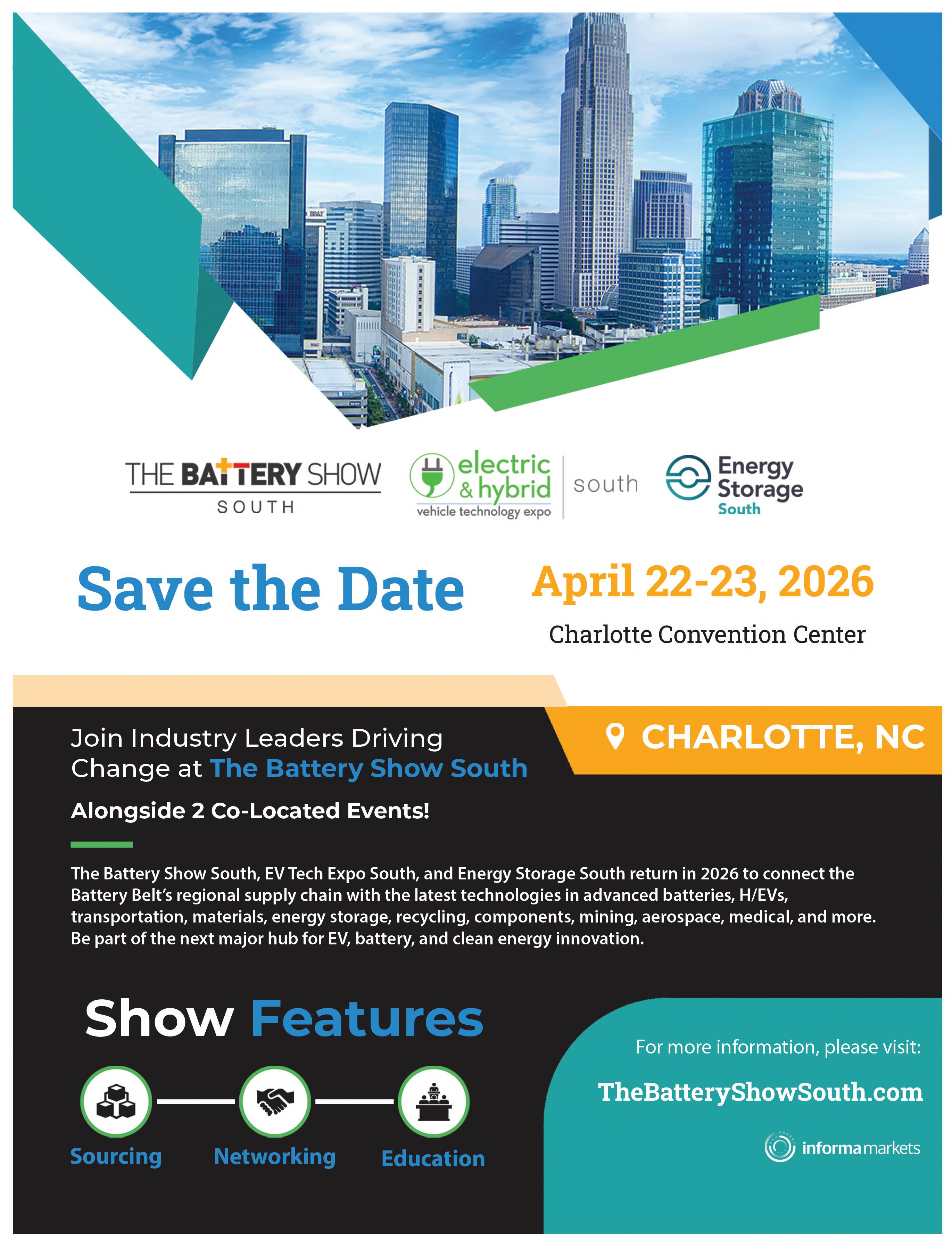

Trailer Dynamics is taking a di erent approach from Range Energy—instead of a retro t kit, TD (with trailer maker KRONE as manufacturing partner) o ers “a new, fully integrated semi-trailer with battery, eAxle, power electronics, controls and telematics engineered as one system and validated at OEM trailer level. at lets us optimize weight distribution, energy management, brake blending and functional safety end-to-end, and gives eets a single warranty and service pathway.”
Jaber told us that Range Energy’s retro t kit is “clever, and lowers the adoption barrier for some use cases, but our view is that deep OEM-level integration delivers better durability, drivability and lifecycle TCO for longhaul operations, especially at scale.”
e company’s latest model, the DF2 TD Dry600, features a permissible total weight of 39,000 kg and a net payload capacity of 25,442 kg. e eAxle is equipped with two synchronous motors linked via central helical gears. It delivers total power output of 360 kW (continuous) or 580 kW (peak), and torque of 7,000 Nm (continuous) or 11,500 Nm (peak). Battery capacity is 680 kWh (551 kWh usable). e system runs on an 800-volt architecture, and supports DC charging at up to 350 kW.
e drive support/recuperation system “intelligently adapts to driving conditions, signi cantly reducing the towing vehicle’s energy consumption.” In testing, TD’s eTrailer has delivered diesel consumption reductions ranging from 40% to 50%.
Another di erence between TD and Range: the Germans use a wired ISO11992 interface (15-pole connector) that “facilitates seamless communication and synchronization between the trailer and the tractor.” Whereas Range Energy sells to some trailer OEMs, Trailer Dynamics has partnered with one: KRONE, which opened customer orders in 2024. e companies have announced pre-orders with DB Schenker (2,000 eTrailers) and DSV (2,500 units). “We continue to run and expand pilots with large European eets as we ramp series production,” Jaber told us.
It’s complicated. Quotes are driven by con guration


Trailer Dynamics is taking a different approach—instead of a retrofit kit, it offers a new, fully integrated semi-trailer with battery, eAxle, power electronics, controls and telematics engineered as one system.
(battery size, axle spec, service model) and duty cycles. “Our commercial model supports CapEx purchase or OpEx models (lease/pay per km) to ensure positive TCO from day one,” Jaber told us. “Fleets typically evaluate payback periods under real routes rather than sticker price.” He did give us one example: DSV is paying €220,000 each for dry-box (non-refrigerated) eTrailers with the highest available battery capacity.
e current transatlantic duopoly in the powered trailer market may not last much longer. ZF, Range’s
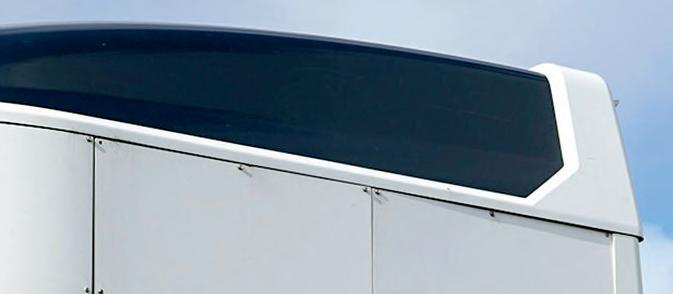

eAxle supplier in North America, is actively developing e-trailers in Europe; Volvo Penta (in partnership with Finland-based trailer-maker Ekeri) showed an e-trailer prototype in Sweden in May; and in China, trailer-maker CIMC says it has electric trailers in service with port and concrete logistics customers.
For its part, Trailer Dynamics is “preparing to expand into the Americas and Asia, in particular China and Japan.”
A startup called Revoy o ers another type of solution— the Revoy EV is a dolly (technically not a trailer) full of batteries that attaches to a diesel semi-truck to e ectively turn it into a hybrid.
Unlike powered trailers made by Range Energy and Trailer Dynamics, the Revoy EV is used with a trucker’s
A startup called Revoy offers a dolly full of batteries that is used with a trucker’s existing trailers.
existing, unmodi ed trailers. Also unlike those companies, Revoy is not selling its product outright, but rather providing it as part of a turnkey service on speci c routes.
In 2024, Revoy did a year-long successful technology demonstration with Ryder, operating one such route (in industry parlance, a lane) between Texas and Arkansas. At the company’s swapping station in Dallas, the Revoy EV was attached between a tractor and a semi-trailer, a process that takes about ve minutes. e rig then drove 234 miles to a station in Arkansas for another quick swap. e Revoy EV is now in production, and the company is planning to build its rst commercial swapping stations in Southern California.

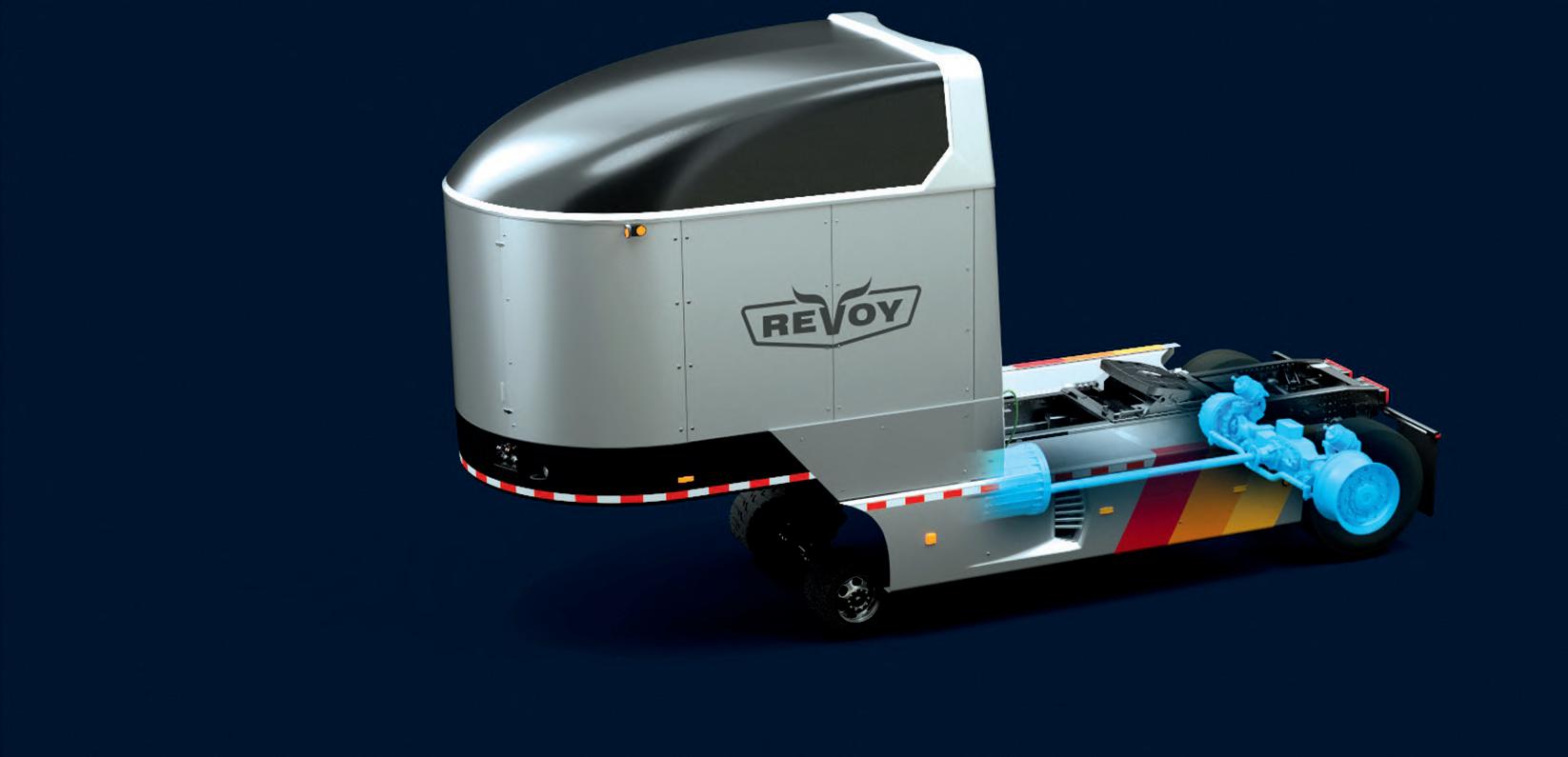
The Revoy EV dolly can increase a rig’s fuel efficiency from 6-8 miles per gallon of diesel to 120 miles per gallon, cutting emissions by 94% and potentially saving a shipper as much as $25,000 in fuel costs per year.
e dolly contains a 525 kWh LFP battery pack and a 400 kW electric motor. Range is about 170 miles, and charging typically uses a pair of 360 kW CCS fast chargers, which deliver a full charge in about an hour.
e Revoy EV provides enough extra power to increase a rig’s fuel e ciency from 6-8 miles per gallon of diesel to 120 miles per gallon, cutting emissions by 94% and potentially saving a shipper as much as $25,000 in fuel costs per year.
Trucking companies pay by the mile for the service, which is designed to t smoothly into the current process that shippers use. “What we sell to our customers really is torque,” CEO and founder Ian Rust told reporters in 2024. “ ey’re just getting power to haul their load.”
Like the powered trailers, Revoy’s dolly is designed not only to save fuel, but to improve the performance of the overall rig. e extra power helps trucks accelerate
faster, and the dolly’s regenerative braking decreases the rig’s stopping distance by as much as 30%. Revoy’s technology also adds driver assistance features like blind spot detection, automatic reversing and auto-correction to help prevent rollovers or jackkni ng.
Don’t call her a trailer!
“It’s not a trailer because it’s not carrying cargo,” Revoy Chairman Peter Reinhardt explained to Charged. “It’s a dolly. On the National Highway Freight Network [which includes the Interstate system plus a few other major highways], there are restrictions on trailer length, but there are no overall length restrictions on the entire combination. Our dolly is typically included in the length of the whole system.”
ere is a regen system, but “it doesn’t end up being that material in terms of fuel savings, since most of the time you’re just cruising down the Interstate. e Revoy EV is really only useful in the National Highway Freight network. It inhabits a speci c 170ish-mile lane where it shuttles back and forth between two chargers, and what really drives the economics is high charger utilization.”
e company currently has four dollies in operation. “An economically successful commercial lane probably looks like about 24 Revoys, which is not a huge manufacturing li , but we think we can get to great dieselbeating economics even at that small scale,” Reinhardt told us. “ en we’ll look to replicate that unit of 24 Revoys across di erent lanes.”
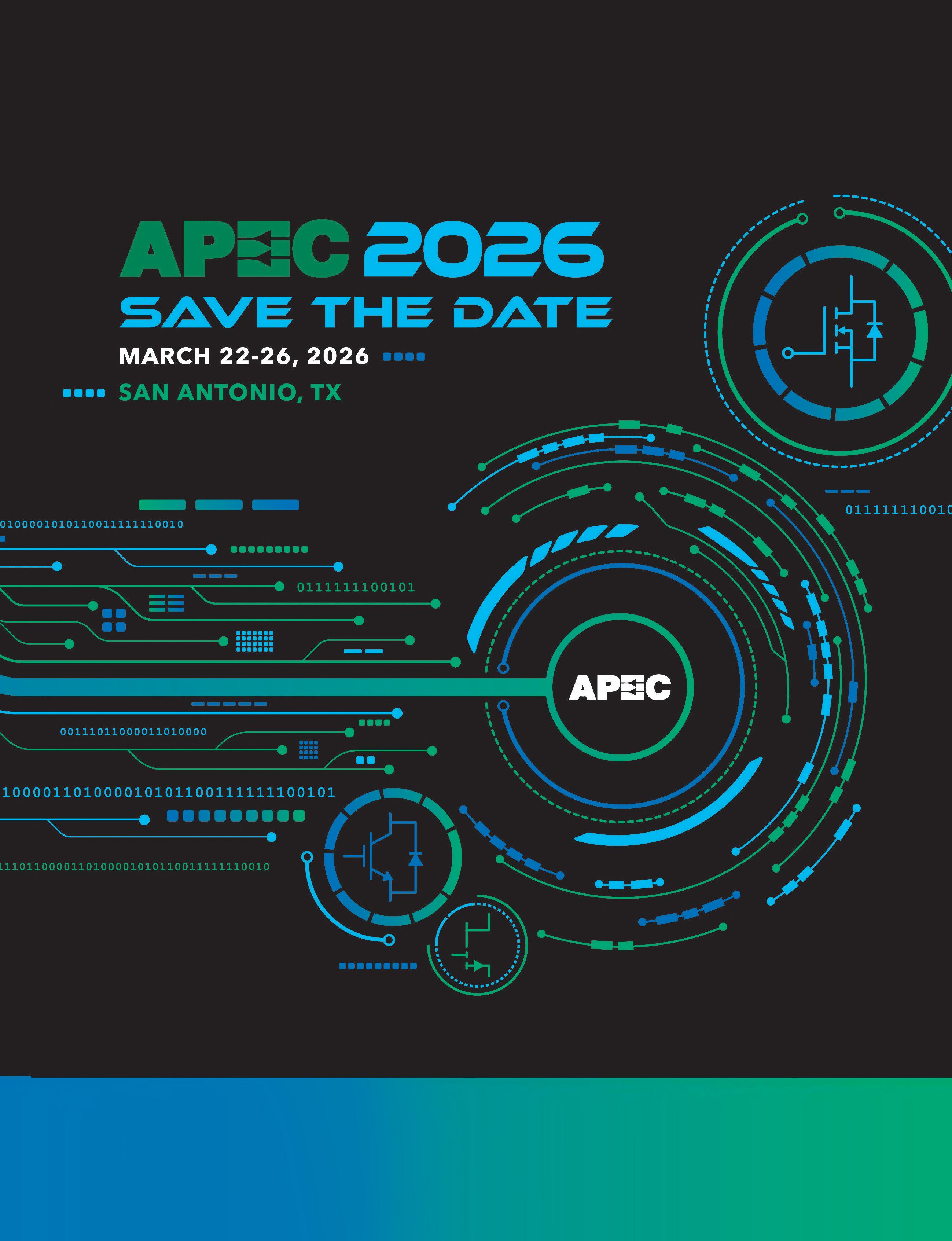
In February, the DOT suspended the NEVI Formula Program, and rescinded prior approval of states’ spending plans. In June, a federal judge temporarily blocked the US administration from withholding funds awarded to 14 states. In August, the DOT issued revised guidance which appears to clear the way for some or all of the NEVI Formula projects in the pipeline to proceed.
What happens now? We asked Arcady Sosinov, the founder of FreeWire and the new CEO of Tritium, to make an educated prediction about the future of NEVI.
“I think the real answer is that we don’t know yet,” Sosinov told Charged. “But put yourself in the shoes of network operators or retailers who won NEVI funding a couple of years ago. ey spun up a small team to try to capture some NEVI dollars, they won some funding, but now the team’s been disbanded. Likewise, the network operators, some of which were very small, and were banking on capturing grant funding to grow their business, a lot of them don’t exist anymore.”
Sosinov predicts delays and increased costs for taxpayers and companies: “ ere are some network operators that will continue those projects, but in most cases, they now need to submit new permits, new drawings [and perhaps] new lease agreements.”
We also asked Margo Oge, the former Director of the EPA’s O ce of Transportation and Air Quality, to peer into her crystal ball. “ e pause from DOT last February came at a critical time, potentially raising costs as companies and states were moving forward to build,” she told us. “I hope the new guidance will allow many NEVI projects to proceed. However, we may see uneven progress—some states moving ahead, while others lag or even cancel.”
While the administration may have kneecapped NEVI, the nationwide rollout of EV charging infrastructure has continued. Just over a hundred NEVI-funded sites have gone live over the past few months, and over the same period, around a thousand privately funded sites have opened. Does this mean we’ve reached the point where the industry can nance charging infrastructure on its own, without government support?
“Despite private investment, government support is absolutely vital to ensure access to charging,” Margo Oge told us.
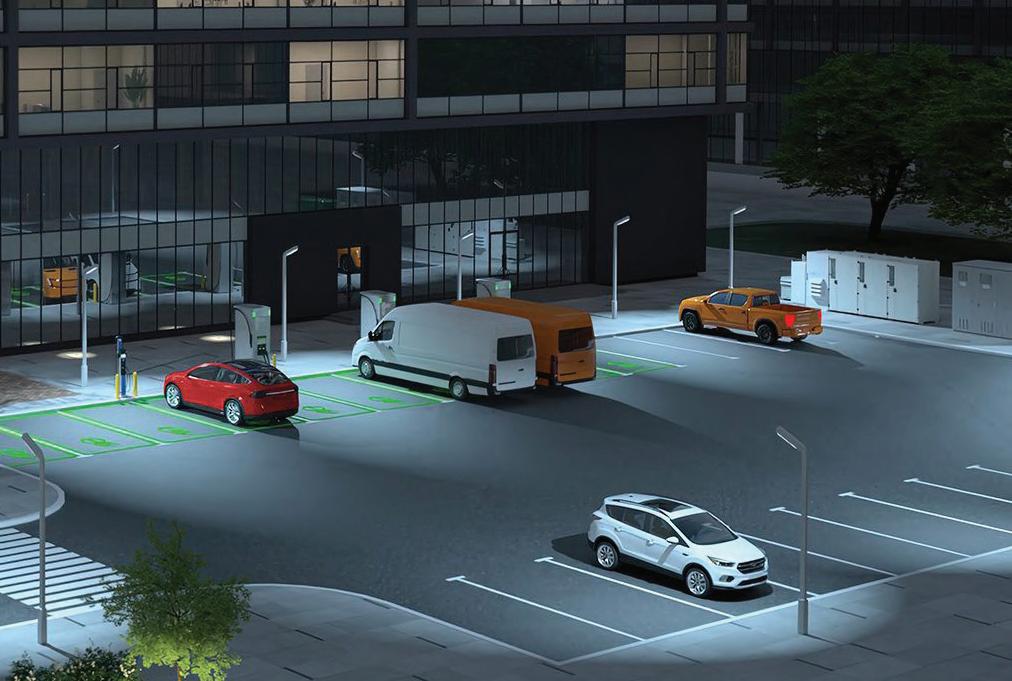
As the EV market expands, there’s a pressing need for more standardization of DC power distribution, especially for buses and heavy-duty vehicles. SAE International’s new standard, SAE J-3105: Electric Vehicle Power Transfer System Using Conductive Automated Connection Devices Recommended Practice, promotes the safe testing and performance of mechanized conductive power transfer systems, primarily for vehicles using a conductive automated-charging device (ACD).
SAE J-3105 addresses three interfaces required to ensure power delivery is consistent. It de nes a conductive power transfer method, including the curbside electrical contact interface, the vehicle connection interface, the electrical characteristics of the DC supply, and the communication system. It also covers the functional and dimensional requirements for the vehicle-connection interface and supply-equipment interface.
In addition to the main document, there are three supplements, which address connection-interface requirements for power transfer systems based on cross-rail designs, conventional rail vehicle pantograph designs and enclosed pin-and-socket designs.
“SAE J-3105 will help industry ensure that each connection type is safe and interoperable among manufacturers,” said Task Force Committee Chair Mark Kosowski. “ e industry has been waiting for this Recommended Practice.”





EV Realty and Prologis Mobility have announced a joint initiative to coordinate access to high-power EV charging hubs along major freight corridors in Northern and Southern California. e collaboration aims to simplify and expand charging solutions for commercial eet operators, particularly those operating medium- and heavy-duty electric trucks.
e plan involves linking the companies’ respective charging infrastructure networks at regional logistics hubs situated near ports, key freight routes and logistics centers. e rst integrated hubs will open in Vernon and San Bernardino later in 2025, and several more facilities are planned across the region.
is joint e ort addresses a major obstacle in largescale electric eet adoption: fragmented charging networks that force operators to manage multiple access points and incompatible so ware systems. EV Realty and Prologis Mobility say the shared access model will provide a uni ed system for eets, streamlining charging processes and reducing operational delays.
e companies note that this approach supports recommendations from a recent study by Prologis and the Massachusetts Institute of Technology (MIT) Climate and Sustainability Consortium, which identi ed shared infrastructure as a driver for faster commercial EV deployment.
EV Realty develops and operates high-powered charging hubs near industrial and freight corridors, focusing on reliable, scalable grid access for commercial eets. Prologis Mobility o ers subscription-based charging solutions, and is expanding public and private charging infrastructure within its logistics portfolio.

Munich-based startup FRYTE, in collaboration with Bosch Road Services, SBRS and Hubject, has demonstrated a fully automated reservation process for an electric truck charging station, based on the Open Charge Point Interface (OCPI) standard, which enables automated roaming among various EV charging networks.
“For eet operators and transport companies, the ability to reserve charging sessions in advance means that e-trucks can be reliably integrated into tight schedules,” the company explains. “At the same time, charging infrastructure operators—both in the public domain and at depots—bene t from improved capacity management of their charging points.”
e introduction of reservation functions requires seamless interaction among various so ware systems, including transport management systems (TMS), energy management systems (EMS) and charge point management systems (CPMS). FRYTE’s modular cloud ecosystem enables communication between TMS and CPMS, based on the new OCPI standard.
At the reservation demonstration during the recent Interchange Network Conference in Berlin, Hubject acted as a reservation hub, SBRS as a CPO, and Bosch Road Services as a booking service provider, while FRYTE provided the integration module to connect the TMS systems. Fiege Logistik, in its role as operator of charging points and depots, represented the perspective of a private CPO.
“Charging point reservation solves two central challenges,” said Maximilian Zähringer, CEO of FRYTE.
“When implemented correctly, it ensures reliable operation of e-trucks for eet operators and, at the same time, a secure and predictable utilization of charging infrastructure for operators. Interoperability is key to enabling automated booking directly from transport management.”

Public charging infrastructure developer and operator Greenlane, a joint venture of Daimler Truck North America, NextEra Energy Resources and Blackrock’s Global Infrastructure fund, is establishing its second commercial EV charging corridor, connecting Southern California to Phoenix via Interstate 10.
e corridor is one of several planned routes as the company works to develop a nationwide network of commercial EV charging for medium- and heavy-duty eets. e second corridor includes the agship Greenlane Center in Colton, next to San Bernardino in the Inland Empire, which opened in April, as well as new sites to be developed in Blythe, California, and Greater Phoenix, Arizona. e Colton location features more than 40 high-speed chargers, including 12 pull-through and 29 bobtail lanes for medium- and heavy-duty EVs.
e corridor expansion is supported by a strategic partnership with electric truck OEM Windrose Technology. Windrose’s R700 Class 8 electric semi-truck successfully completed single-charge journeys from Greenlane’s Colton location to Buckeye, Arizona, near Phoenix (I-10 corridor) and Las Vegas (I-15 corridor). e semi had a gross combined weight rating (GCWR) of 74,420 pounds. e nearly 300-mile journey on the Phoenix route carrying a near-maximum payload demonstrates the real-world capability of electric trucks for demanding long-haul freight operations, Greenlane said.
e single-charge hauls follow successful interoperability testing at the Colton site, where the Windrose R700 achieved a peak charge rate of 772 kW with its dual-gun charging technology, exhibiting Greenlane’s ability to support rapid turnaround times essential for freight operations.
Under the partnership, Windrose will use Greenlane’s agship center in Colton as its base of operations for several vehicles and to power its R700 electric truck for pilot customers along the I-15 and I-10 freight corridors. One of the rst customers on these routes will be Nevoya, an electric trucking carrier focused on helping shippers and third-party logistics carriers transition to electric transportation.
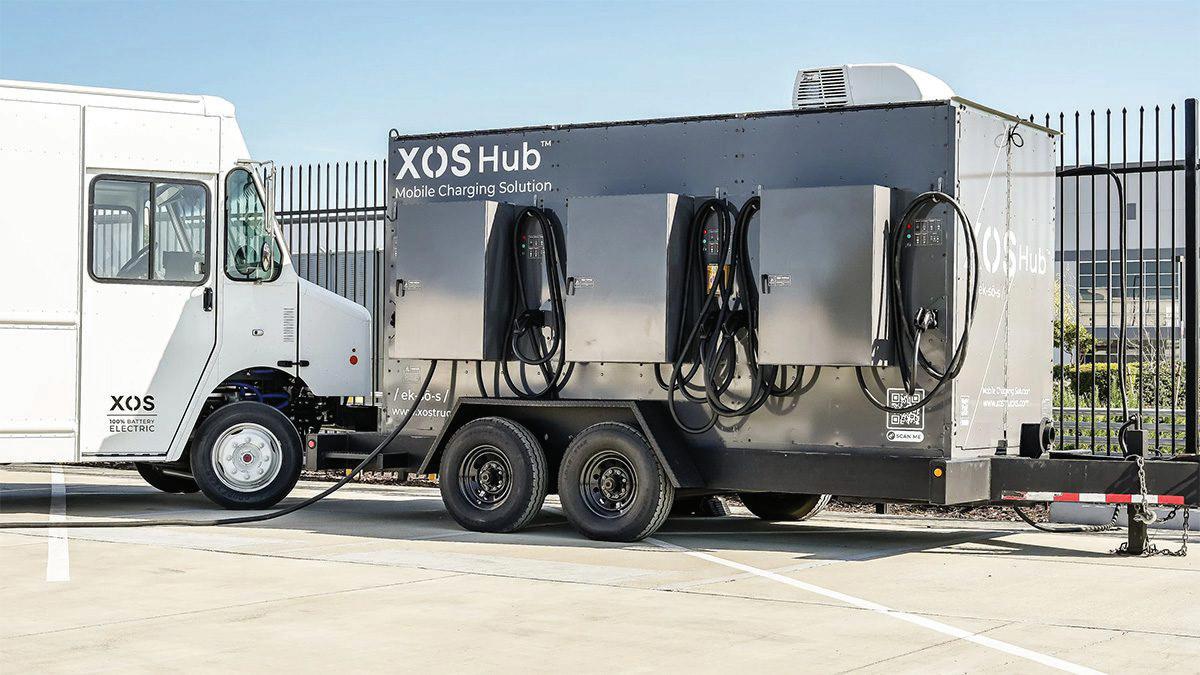
Xos mobile EV charging unit now available for under
e latest version of the Xos Hub mobile charging unit has been approved for California’s Clean O -Road Equipment Voucher Incentive Project, administered by the California Air Resources Board. is approval makes the Xos Hub eligible for a $110,000 incentive, allowing eet customers to acquire the unit for under $100,000. Xos says this pricing is less than half the cost of many comparable DC fast charging systems, which o en exceed $200,000.
e Xos Hub features 282 kWh of energy storage and four integrated DC fast chargers. e unit is designed for rapid deployment without permanent infrastructure or major utility upgrades. is exible solution targets eet operators who need mobile charging at multiple, remote or grid-limited sites.
Xos says current Hub users include large eets and utilities such as Caltrans, Duke Energy, Xcel Energy, TECO Energy and Highland Fleets.
Xos Hub has also been deployed in a variety of o -highway settings, including seaports for powering electric forkli s in cargo operations, airports for supporting electric aircra and ground support equipment, construction zones as an energy source for electric machinery, and retail or logistics facilities for charging yard hostlers and material handling equipment.
“Securing CORE approval for our most advanced Hub yet is a major milestone in our mission to accelerate eet electri cation,” said Aldan Shank, Director of Mobile Charging. “By getting the cost below $100,000 per unit, we’ve made high-capacity fast charging easier to deploy than ever before. is changes the economics for o -road eet operators and removes many of the common obstacles to eet electri cation and charging.”


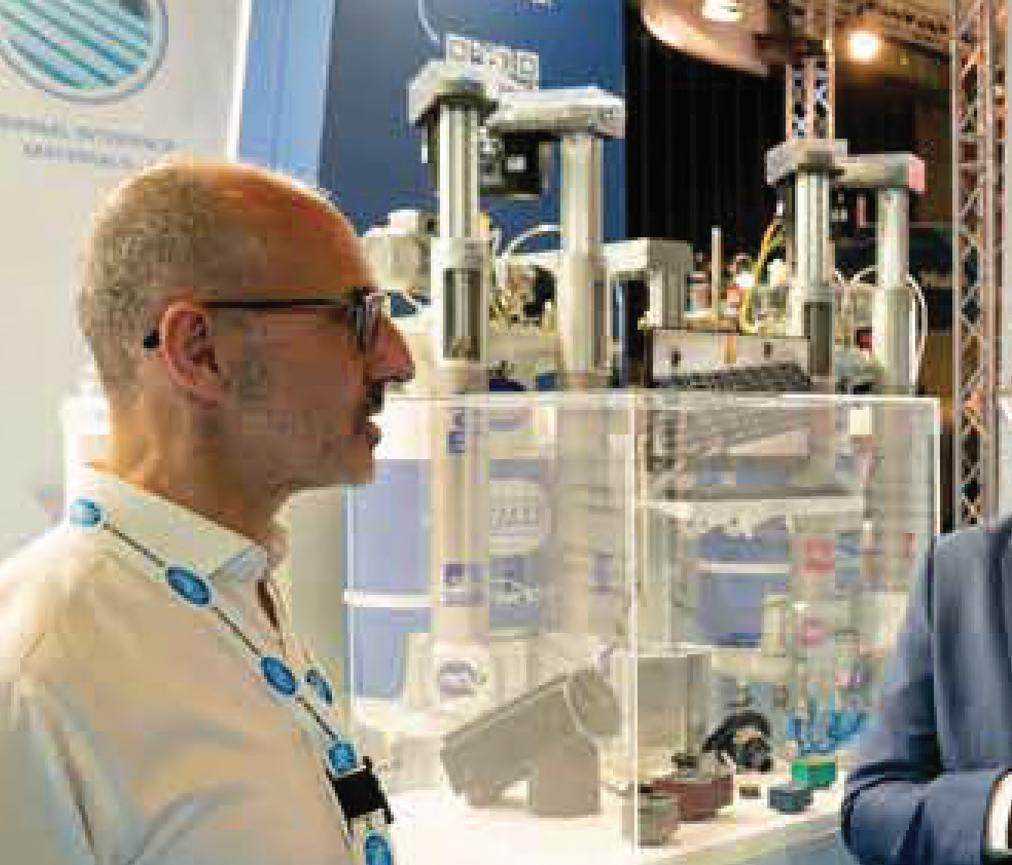



Ford has launched Ford Charge, a new network of nearly 1,200 DC fast chargers located at over 320 Ford dealerships across the US. e network o ers public charging for all compatible electric vehicles, not just Ford models. e rst dealership to have chargers operational on the new Ford Charge Network was John Grappone Ford in Bow, New Hampshire, which deployed six DC fast chargers.
Ford Charge joins the BlueOval Charge Network, which the company says is North America’s largest integrated charging network. e combined network unites thousands of chargers from various CPOs, and enables Ford EV drivers to access fast charging within 18 miles of most US highways, according to the automaker.
Customers can locate Ford Charge stations using the BlueOval Charge Network interface for Ford customers, PlugShare, or the Shell app. ese platforms display charger locations, real-time availability and pricing details to help users plan routes and charging stops. Many locations are accessible 24/7.
Ford Charge o ers 24/7 live agent call center support for any customer experiencing an issue or needing assistance during charging.
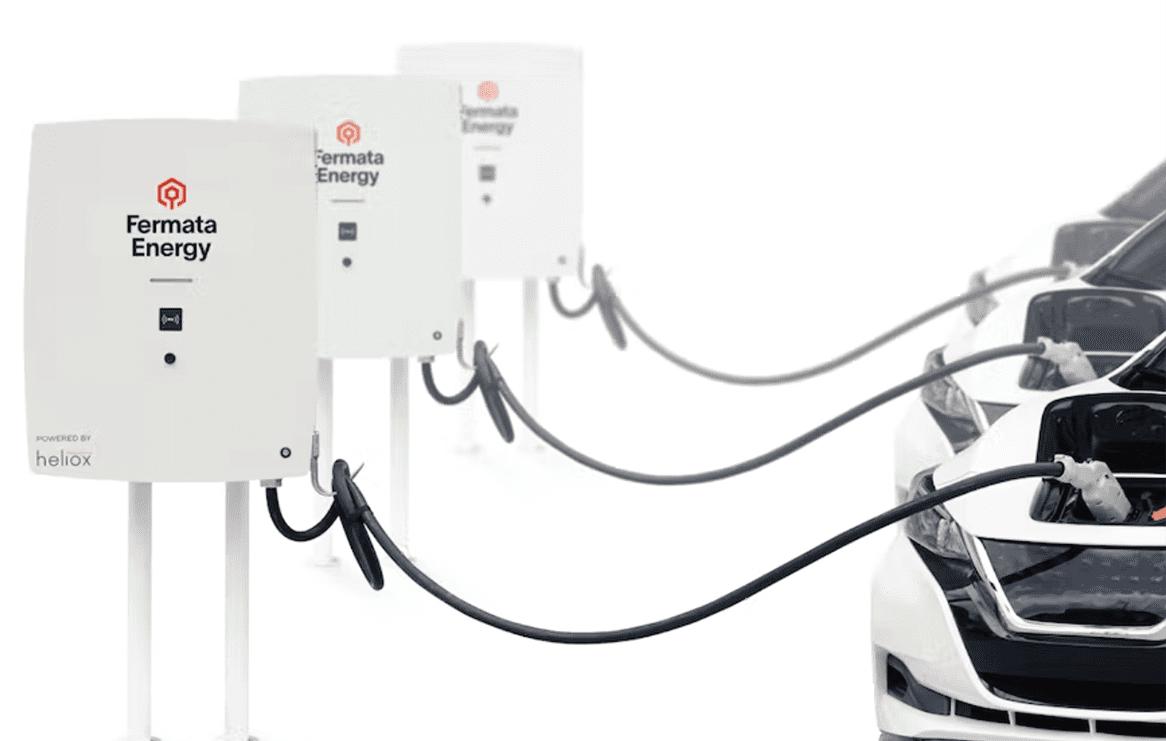
ChargeScape, an automotive joint venture focused on EV-grid integration, and Nissan have launched a new vehicle-to-grid (V2G) pilot in the utility territory covered by Silicon Valley Power (SVP).
Silicon Valley is one of the world’s data center hotspots, and utilities such as Silicon Valley Power are seeking innovative ways to quickly increase power supply to meet demand. At Nissan’s Advanced Technology Center in Silicon Valley, this pilot, which is part of ChargeScape and Leap’s broader California Virtual Power Plant, will use energy stored in EV batteries, managed by Fermata Energy’s bidirectional chargers, to export power during periods of grid strain.
“At Fermata Energy, we are demonstrating how V2X optimization can transform electric vehicles into intelligent grid resources,” said Hamza Lemsaddek, Chief Operating O cer, Fermata Energy. “By pairing our platform with bidirectional chargers, we’re proving that EVs can strengthen data center reliability, support utilities like Silicon Valley Power, and deliver real economic value back to drivers and communities.”
“ rough this collaboration, we’re showcasing how electric vehicles can reinforce our communities’ electrical needs and deliver meaningful bene ts to drivers,” said Rich Miller, VP of Vehicle Connected Services at Nissan North America.
“Integrating Nissan’s EV batteries into Silicon Valley Power’s grid is a crucial rst step to shoring up longterm grid reliability and rewarding the EV drivers who are part of the solution,” said Joseph Vellone, CEO of ChargeScape.





Shell has announced the launch of a new integrated EV charging network targeting heavy-duty eet operators in Europe. e network merges Shell Recharge sites, roaming partner locations, semi-public depot sites and private charging points with managed third-party access into a uni ed platform.
Shell designed the network to help heavy-duty eet operators address gaps in public EV infrastructure and reduce high upfront depot investment by providing alternative access to charging solutions. e o ering includes tailored charging hardware and so ware systems, support for energy management, and optimized energy pricing structures.
SBRS, a Shell-owned company, is responsible for delivering the depot network elements. SBRS oversees hardware deployment, so ware integration and energy system support across semi-public and private depot charging sites.
According to Shell, this model allows operators to electrify their eets without direct depot investment. e platform o ers stable, discounted energy pricing, charging optimization, and the ability to generate revenue by opening depot access during o -peak hours.
“Our integrated charging network supports eet operators by providing dependable access and helps to reduce the total cost of ownership for battery-electric trucks by up to 25 percent,” said Conrad Mummert, Head of SBRS.
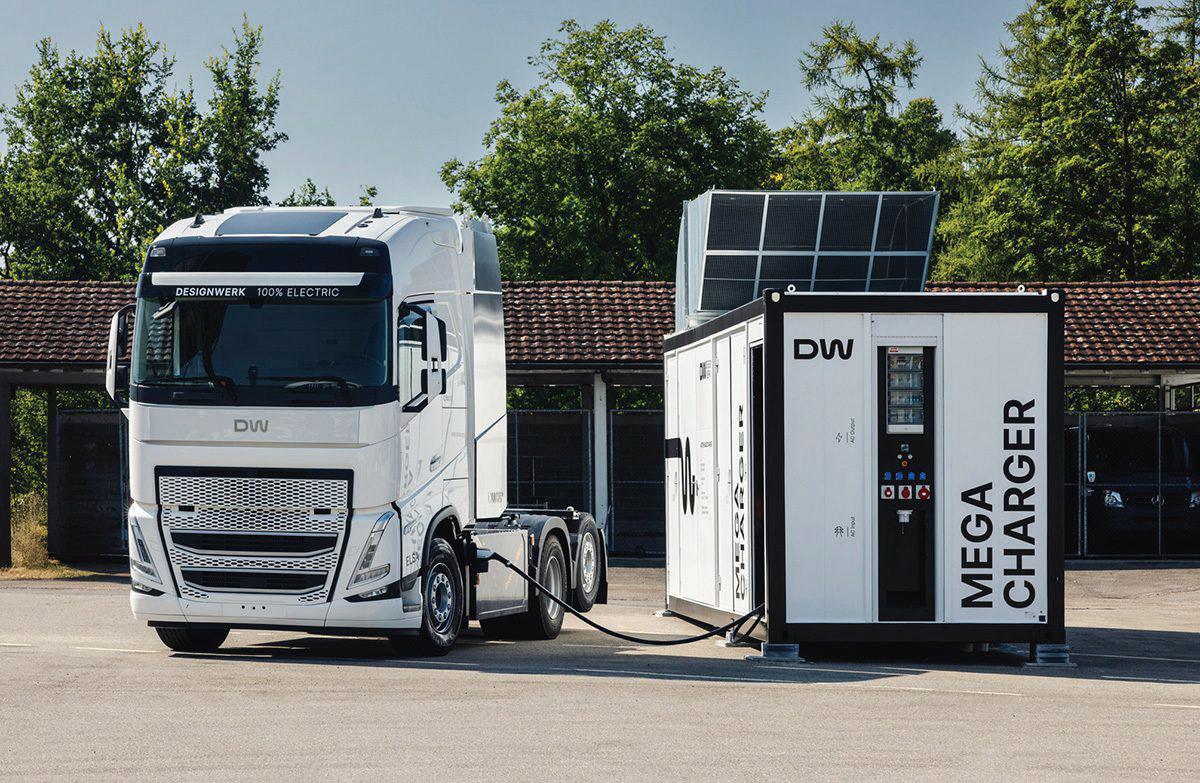
Designwerk Technologies has reported its fastest-ever megawatt EV charging session, exceeding 1.1 megawatts during a July 2025 demonstration in Oberbüren, Switzerland. e trial, conducted as part of a project supported by the Swiss Federal O ce of Energy, showed Designwerk’s Megawatt Charging System (MCS) in operation under real-world depot conditions. Designwerk says typical charging levels for this application have been around 350 kW.
In nal tests, Designwerk’s MCS ramped up charging power to a peak of 1.14 MW, which is eight percent above the initiative’s target value of 1.05 MW. e test setup involved a Designwerk prototype e-truck built on an 800 V platform with a 1,000 kWh energy storage system (four 250 kilowatt-hour battery packs). Charging from 10 to 80 percent state of charge took 42 minutes, transferring 625 kWh at an average power level of 906 kW, which Designwerk describes as the highest continuous charging rate to date for the application. e test recorded a peak charging current of 1,530 A. According to Designwerk, the fast charging cycle enables a 40-tonne electric truck to achieve a 500-kilometer range, including charging sessions that conveniently t into legally required driver breaks.
Designwerk’s MCS is built as a exible, containerized solution with integrated lithium-nickel-manganese-cobalt battery bu ers. ese allow for peak shaving to reduce grid impact, use of local renewable energy and the integration of second-life batteries from decommissioned commercial vehicles. e approach is intended to eliminate the need for grid expansion at depots. Designwerk says the system serves as a fully mobile, all-in-one solution for o -grid or fast-deployment needs in electric truck eets and other heavy-duty EV applications.

EVSE manufacturer Tellus Power has unveiled two new 600 kW DC fast charger systems: a distributed system and an all-in-one unit. Both are designed for exible deployment across various applications, including eet and public charging sites.
e distributed system supports anywhere from one to eight dispensers from a single 600 kW power cabinet, allowing operators to tailor con gurations to each site’s needs. Power is allocated dynamically based on how many vehicles are charging and their power requirements.
e all-in-one unit, designed for standalone deployments, supports one or two connectors, and features a 32-inch digital screen for advertising. Compatible with multiple charging con gurations, the unit is designed to o er a versatile solution in a smaller footprint.
Both con gurations support 800-volt architecture and are compatible with NACS, CCS1 and CCS2 standards.
“ e global energy landscape is now in critical need of intelligent, cost-e ective solutions to match the growth of EV adoption worldwide,” said Mike Calise, CEO of Tellus Power. “Our 600 kW chargers o er exceptional exibility and deliver ultra-fast performance without the premium price tag, making high-power charging a viable business case at scale.”

Smart infrastructure specialist Siemens has made a strategic investment in Emporia Energy, a pioneer in smart home energy management solutions aimed at helping homeowners to optimize their energy consumption and costs.
Siemens, in collaboration with Emporia, previously launched the Inhab Energy Monitor solution, which provides real-time insights into home energy usage. e device enables homeowners to track power consumption across appliances, including EV chargers and solar generation systems, and o ers recommendations to reduce costs and improve e ciency.
e advent of EVs, solar installations and home energy storage systems has increased the complexity (and costs) of the traditional electrical system, and homeowners need to manage multiple power sources and devices to optimize their energy consumption. Inhab is designed to give homeowners more transparency and control over their energy systems.
“Our evolving relationship with Emporia underscores our commitment to driving innovation and creating greater value for our residential customers that have a growing need for smart home energy management,” said Jacob Middleton, Head of Residential Electrical Products at Siemens Smart Infrastructure USA. “Combining our strength in power distribution and circuit protection with Emporia’s expertise in developing a suite of Smart Home Energy Management hardware and so ware offerings allows both companies to advance our combined commitment to transform smart home energy management.”





Lincoln Electric has announced the launch of its Velion 50 kW DC fast charger, expanding its electric vehicle charging product line. e new o ering is a compact, mobile charging unit with scalable output and exible deployment options, targeting demanding eld environments such as construction sites, emergency response and eet operations.
e Velion 50 kW charger is designed, engineered and assembled in the US, and features over 70 percent domestic content. Lincoln Electric says it meets all National Electric Vehicle Infrastructure (NEVI) and Build America, Buy America (BABA) requirements for federal compliance. Output power is scalable and con gurable at 12.5 kW, 25 kW, or 50 kW, making it suitable for a range of charging needs in dealership service bays, at eet depots or on remote project sites.
Deployment options include ground-mounted, wheeled and rugged roll cage form factors, and the unit supports both Combined Charging System (CCS1) and North American Charging Standard (NACS) connectors. Lincoln Electric says the plug-and-play installation does not require trenching or extensive permitting, enabling rapid setup in the eld.
Technical features include proprietary epoxy-coated printed circuit boards for durability, integrated smart diagnostics, remote monitoring capabilities and weather-resistant components. e product is backed by a three-year standard warranty and Lincoln Electric’s service network.
“Designed in collaboration with the market and leveraging decades of expertise in power electronics, our solution is engineered to provide the exibility customers need today, with a future-ready design to meet the demands of tomorrow” said Bruce Chantry, Vice President, Electric Vehicle Solutions at Lincoln Electric.

Seattle-based Electric Era, a provider of battery-integrated electric vehicle charging solutions, has completed a rapid 54-day installation of six premium charging stalls at a Costco Wholesale warehouse in Northport, Florida. Each stall o ers 200 kW of charging power. e installation began with a contract agreement on April 7, 2025. e company submitted permits by April 18, equipment arrived at the site in mid-May, and the site was complete—including construction, testing and inspection— by May 30.
Electric Era says its expedited deployment timeline was possible due to its patented battery-backed architecture, which reduces peak grid input power requirements and installation complexity. According to the company, this technology reduces grid power consumption by up to 70%. Electric Era manages engineering, manufacturing, supply chain, and deployment processes internally, further contributing to shorter installation timelines. e installed solution in Northport features three charger units, each equipped with one CCS and one NACS cable.
“Our retail customers don’t want their lots torn up for years—they want fast, reliable EV charging systems to help them grow their business and boost their bottom line,” said Quincy Lee, CEO at Electric Era. “Because we manage the process from start to nish in-house, we’re able deliver a signi cantly more e cient process across the board and complete deployments in a fraction of the time it takes other EV charger manufacturers.”
Electric Era also says that the speed of its installations helps retailers leverage federal and state EV infrastructure grants by eliminating the need for utility upgrades and simplifying project design, execution and approval processes.
Public EV charging has a reliability problem. A constant stream of reports about chargers that are di cult to use, buggy, or just plain broken has surely a ected the rate of EV adoption, especially among frequent road-trippers. Fortunately, charging operators are well aware of the problems, and by all accounts, reliability is gradually improving.
Automotive data and analytics rm J.D. Power has con rmed the good news with some user data. e company’s U.S. Electric Vehicle Experience (EVX) Public Charging Study, now in its h year, measures EV owner satisfaction with public charge-point operators across 10 factors:
• ease of charging
• speed of charging
• physical condition of charging station
• availability of chargers
• convenience of the location
• things to do while charging
• how safe you feel at the location
• ease of nding the location
• cost of charging
• ease of payment
e 2025 study, conducted in collaboration with PlugShare, surveyed 7,428 owners of BEVs and PHEVs between January and June 2025. It breaks out the satisfaction ratings by region, and also provides a ranking of satisfaction levels for the leading charging providers.
e number of “non-charging visits” (when an owner visited a charger but was unable to charge their EV) has hit its lowest level in four years, J.D. Power reports, “a clear indicator that reliability and customer experience are steadily improving.”
Overall satisfaction has actually declined: satisfaction with DC fast chargers is 654 (on a 1,000-point scale), a 10-point decrease from the same period a year ago; satisfaction with public Level 2 charging has declined to 607, a 7-point decrease. However, satisfaction with charger reliability has improved. Only 14% of respondents said they had visited a charger without being able to charge their vehicle—a decrease of 5 percentage points from 2024.
e main factor in the decline in overall satisfaction is

the cost of charging—respondents feel that both Level 2 and DC fast charging are too expensive.
“Part of the decrease in satisfaction is due to non-Tesla owners using Tesla Superchargers, which deliver a far less satisfying user experience relative to the costs incurred, in comparison to those of Tesla owners,” said Brent Gruber, Executive Director of the EV practice at J.D. Power. “Also, in previous years, many DC fast charging networks kept prices low as they developed their market presence, while manufacturers regularly o ered free charging incentives with vehicle purchases. However, as the infrastructure market evolves and electricity rates rise, charging prices have increased signi cantly in some cases.”
Gruber attributes part of the increase in reliability to the in uence of the National Electric Vehicle Infrastructure (NEVI) program, which established minimum reliability standards as a requirement for funding. NEVI has unfortunately become a political football (at the moment it appears to be moving down the eld), but whatever happens next, the reliability and quality guidelines it established have had a positive e ect on the industry.
“With or without the federal funding, NEVI guidelines have made their mark by establishing a playbook for industry success,” said Brent Gruber. “Our data shows clear improvement in the reliability and success of public charging—a promising sign of progress for the industry.”
It must also be said that the charging industry has been responsive to the tide of customer complaints—charging networks have undertaken initiatives to improve their reliability, standards body SAE International is working to establish reliability standards, and organizations such as ChargerHelp and PlugShare are helping to keep consumers informed.





We’ve been covering Orange EV for a decade, during which time we’ve seen a couple dozen other commercial EV startups go out of business. Part of Orange’s winning formula: the company targeted a segment that was (and remains) a perfect use case for EVs: terminal tractors (aka yard dogs or yard goats).
Orange’s sister company, OptiGrid, addresses a couple of the most signi cant barriers to eet electri cation: high infrastructure costs and long waits for utility upgrades. OptiGrid’s charging platform, which originated from technology created at FreeWire, is now in its fourth generation and has undergone nearly a decade of engineering development.
Now Orange and OptiGrid have introduced a new battery-integrated DC fast charger. Using an onboard 180 kWh battery, the Orange Juicer steadily draws energy from on-site utility connections, and delivers it on demand. “ e result is full charging performance with up to 85% less grid input power, resulting in a dramatic reduction of both installation timelines and upfront costs,” Optigrid explains.
“As more customers accelerate adoption of Orange EV trucks and electrify other site equipment, we’ve seen infrastructure upgrades cause serious holdups,” said Kurt Neutgens, co-founder and President of Orange EV. “ e Orange Juicer solves that challenge, giving eets a fast, scalable and cost-e ective charging platform that utilizes existing on-site power.”
Optigrid says deploying the Orange Juicer allows eets to avoid expensive utility upgrades, trenching and construction by using existing power, so they can start running electric trucks in weeks, not years. e charger works with Orange EV trucks today, and is adaptable for other eet equipment.
e Orange Juicer will be commercially available in Q4 2025.

ABB Installation Products’ new Microlectric EM Series Electric Vehicle Energy Management System (EVEMS) is designed to optimize residential energy distribution and avoid costly electrical upgrades.
ABB’s EVEMS, which is aimed at the Canadian market, ensures that EVs charge only when su cient electrical capacity is available. e system intelligently monitors available electrical capacity in real time, automatically starting or stopping charging based on power availability. It can also be used to control other electrical loads, such as air conditioning (which is apparently considered “non-essential” in Canada).
“Empowering Canadians to embrace clean energy starts with removing the barriers that slow adoption,” said Leila Sedighi, VP Product & Marketing, ABB Installation Products.
e EM Series, which uses technology from Calgary-based Black Box Innovations, is “a scalable, future-ready solution created to meet the energy demands of single residential, multi-residential, and multifamily buildings.”
e system is compatible with residential electrical service entrances ranging from 60 to 200 amps.
Manufactured in Canada at ABB’s Iberville facility in Saint-Jean-sur-Richelieu and Black Box Innovations’ facility in Calgary, the Energy Management product line can be ordered in Canada exclusively through ABB’s nationwide distribution partners.
“ is partnership allows Black Box Innovations to leverage ABB’s Canadian product assembly, marketing, and distribution capabilities to meet the growing demand for our electrical load mitigation products and power control systems,” Said Taner Cairns, CEO of Black Box Innovations.
By Charles Morris
Arcady Sosinov is a veteran of the EV charging industry. In 2014, he founded FreeWire to address the challenges of securing adequate grid infrastructure for DC fast charging sites. FreeWire’s solution, which pairs battery storage with chargers, is one that is now becoming the norm in the industry.
Unfortunately FreeWire, as so many startups have, found itself growing but unable to reach an in ection point in pro tability, and when the market cooled, it became insolvent. Sosinov sold the business to a consortium that included Orange EV, a ten-year-old manufacturer of electric terminal tractors, which rebranded FreeWire’s technology as OptiGrid.
Meanwhile, Tritium, which was founded in Australia but quickly grew into a global EVSE supplier, also got nancially overextended, went through a reorganization and was bought by the Indian rm Exicom. Tritium, which was a top-three vendor of charging infrastructure in the US, the UK, Europe and Australia, has also made a specialty of integrating its charging solutions with battery storage within DC microgrids, so the Exicom management team brought on Sosinov to rebuild Tritium into a leading global supplier.
Charged spoke with Mr. Sosinov about charging standards, reliability, payment methods, and most important, how a charging hardware vendor can di erentiate itself in order to survive the coming consolidation of the industry.

Q Charged: Everybody I talk to says there’s going to be a shakeout in the EV charging industry.
A Arcady Sosinov: Any exuberant technology, there’s a common pattern to it. A ton of money went into the charging industry, and you had this fast rise. And ultimately, what happens is you have a steep drop, then you have slow growth back to mean reversion.
Tritium was one of the rst big dominoes to fall. We were the second-largest hardware vendor awardee under the NEVI program, behind Tesla. We built a large manufacturing facility in Tennessee, and built up over a hundred million dollars in raw materials inventory to support all the orders that were coming in under the NEVI program. And what happened? NEVI did not pan out, and most of that money never hit the streets.
Q Charged: How many charger manufacturers are going to be le standing?
A Arcady Sosinov: I don’t think the market can sustain more than half a dozen. Alpitronic, Kempower and ABB are likely to be le standing. Tritium’s goal is to be a leader as the shakeout occurs, based on our installed base of over 21,000 chargers, our deep customer relationships and our new product portfolio.
Infrastructure is not a high-margin business—it’s all about scale. We need to sell hundreds or thousands of units to a customer, and we don’t make our money on that upfront sale. In this business, you make most of your money on the 10- to 15-year relationship that you have with the customer—a ersales, service, support, spare parts.

A ton of money went into the charging industry and you had this fast rise. And ultimately, what happens is you have a steep drop, then you have slow growth back to mean reversion.
Q Charged: Chargers all do pretty much the same thing. How do you di erentiate your product?
A Arcady Sosinov: I think there’s only three ways to di erentiate: scalability, reliability and cost.
Scalability—it’s clear that the industry is moving to larger sites. We know this because we have a large presence in Europe and the UK, so we can see two to three years ahead of where the US market is today. You can forget about those sites with two chargers in the back of a parking lot. It’s not good for the consumer, and it’s not a good business to run.
And when you go to these larger sites, you start considering, are you going to scale linearly in cost or are you going to scale logarithmically in cost? For example, the Alpitronic 400 kW charger that many networks are deploying today is a great charger, but it’s an all-in-one, standalone box. at scales linearly in cost—you want to add another charger, you pay for another box and you pay for more grid connection.
How do you develop a system that gets cheaper on a per-unit basis as you put more units down? is is where Tritium has always shone. We focus on distributed charging solutions. Our next-generation product, the
TRI-FLEX, takes that to the extreme. We have all our power conversion technology at the cabinet next to the transformer. en we allow you to add up to 32 dispensers and 64 charging ports on that power cabinet. e best Kempower can do is 12 charging ports. We can do 64. at means your cost per port plummets, and that scalability ends up really driving down costs.
Q Charged: e next item on your list is reliability, but how do I know how reliable a product is until I’ve had it in the eld for a year or two?
A Arcady Sosinov: Either from past experience or because you’re given a tremendous amount of test data from the supplier. O en that isn’t available because you launch new products. You might have lab reliability data, but lab and eld are apples and oranges, and even the best suppliers can launch products that aren’t reliable. So, what we’ve done is to introduce a lifetime power module warranty. It’s the rst of its kind. No one’s ever done that before. It’s saying, “We’re con dent—you may not have a history with our products, but we’re going to put the risk on us.”
Compare that to the long tail of the market. ere are too many players in the market today that buy a Chinese power supply, put it in a server rack and call it a charger. at is not good for anyone—it brings down the whole industry. Anybody that doesn’t own, design and manufacture their own power modules, they’re not going to survive.
We think our strategy of providing lifetime power module warranties will be copied, but only by those who design and manufacture their own power modules. If you’re buying modules o the shelf from a third party, you can’t o er that kind of warranty. e y-by-night guys are going to disappear, and we need them to disappear.
And then the last way to di erentiate is cost, which is a function of scalability and reliability. If you can be the most scalable product, your costs are going to drop as more dispensers get deployed. And if you can take that operating cost away from the charge point operator and absorb that power module cost over 10 years, their total cost of ownership is going to be so much lower.
Q Charged: Going back to the reliability issue, people tell me that it’s not usually about hardware failures,

We think our strategy of providing lifetime power module warranties will be copied, but only by those who design and manufacture their own power modules.
but about the interfaces among all the di erent pieces of the stack—hardware manufacturer, so ware, charge point operator, site host…
A Arcady Sosinov: I think it’s all of the above, but you still have loads of hardware issues in the eld, both with us and with other vendors. Hardware does break, modules do fail—some more than others, depending on the supplier—and other parts of the system can fail as well. You probably heard about supplier issues with liquid-cooled charging cables. at was a big issue that impacted networks around the world, including Electrify America in the US.
You do have interface issues. Vehicle OEMs do not always conform to the standard CCS protocol, they all have implemented it a bit di erently, so there are

communication issues between chargers and vehicles. Communication doesn’t just happen at the beginning of a charging session—there’s constant communication throughout the session, and if that communication is in any way non-standard, that charging session ends. at still happens frequently.
e implementation of credit card readers has been frustrating to the industry, and particularly to drivers. I suspect there is something wrong on the credit card reader side, where for the last 10 years I’ve noticed that a lot of times the transactions just don’t register. It’s strange because it never happens when you’re at a convenience store or when you buy a bag of chips from a vending machine. at seems to work every time. I can point to two things that are di erent in EV charging. One, EV chargers tend to be in places with poor cellular connectivity. Two, usually, when you do a transaction on a credit card reader, it’s one transaction at a time. You tap and buy your co ee, then it waits for the next transaction. A charger usually has two ports doing simultaneous charging, so you tap, and that card reader has a transaction that you’ve authorized, but it has to wait until the end of the session to know how much to charge you. At the same time, you can have someone else tap on that card reader to start a second charging session. I suspect that there’s an issue with that on the credit card reader
company’s backend, but that’s an opaque part of the process to us.
Q Charged: Is the credit card reader backend something that’s dominated by a few companies?
A Arcady Sosinov: Yes, it’s Nayax, Payter, Apollo, Castles and Ingenico. ose ve make up the majority of the market.
Q Charged: How does the EV charger typically interface with the credit card reader backend?
A Arcady Sosinov: ere’s two ways that credit cards can be implemented: charger-connected or cloud-connected. In the rst model, the charger talks to the credit card reader and passes the data through our backend, then passes it to the credit card reader’s backend. e charger becomes the critical path for that credit card reader to talk to its own systems. If we do that, then we need to become PCI-compliant [i.e. conforming to the Payment Card Industry Data Security Standard (PCI DSS), which is designed to protect cardholder data]. And there’s a risk that something’s broken there—we change our code, they change their code, that API doesn’t work anymore. at was the old world of credit card readers.
e industry has almost entirely moved away from that now, and moved to a cloud-connected model, where we simply allow the credit card reader to connect to our modem—we open a port for it and it communicates to its backend itself, and simply sends us a success or fail message. at’s the way we push all customers to do it today because that eliminates any potential interface issues. But also, because we’re not in that critical path, if there are issues with these credit card readers, which there still are, we are of no help. You can come to Tritium and say, “But that credit card reader’s installed on your machine.” And I’ll say, “Why that charging session didn’t start or that transaction failed, I cannot tell you.”
Q Charged: So, there’s a good and a bad side to doing it that way.
A Arcady Sosinov: at’s right.
Q Charged: Does California now require all public charging sites to have credit card readers?
A Arcady Sosinov: Yes, and on top of that, you have to have CTEP compliance. When you go to a gas pump, there’s a tag that certi es that the pump has been checked by the California Division of Measurement Standards (DMS) and that it will output the right amount of gas for you and charge you the right amount of money. e state of California created a program called the California Type Evaluation Program (CTEP), which certi es that each charger is measuring electricity accurately.
Q Charged: at’s similar to the Eichrecht regulation in Germany.
A Arcady Sosinov: Yes. But funny enough, many chargers in California are not CTEP-compliant, notably Tesla. ey don’t have credit card readers on their chargers.
Q Charged: Why don’t they have to have credit card readers if everybody else does?
Arcady Sosinov: ey do have to, but the question is whether the state of California is willing to shut down access to public chargers across the state to enforce this regulation. Right now, there are DMS sta in California going around and shutting down chargers that aren’t CTEP-compliant. Online, you can nd pictures of chargers with a big yellow tag attached to the handle
The question is whether the state of California is willing to shut down access to public chargers across the state to enforce the credit card reader requirement.
that says, “You cannot use this charger, we’ve noti ed the charge point operator.” But if you start doing that to Tesla chargers, you’re shutting down the majority of the network in California.
Q Charged: Did Tesla make a deal with them, or are they just selectively enforcing the regulation?
A Arcady Sosinov: I don’t know about any deal, but it does seem that selective enforcement is happening.
Q Charged: Is Plug & Charge an alternative to having credit card readers?
A Arcady Sosinov: We’re going to have to have both options. Credit card readers are mandated because of accessibility issues, but the readers we use in the US are not great.

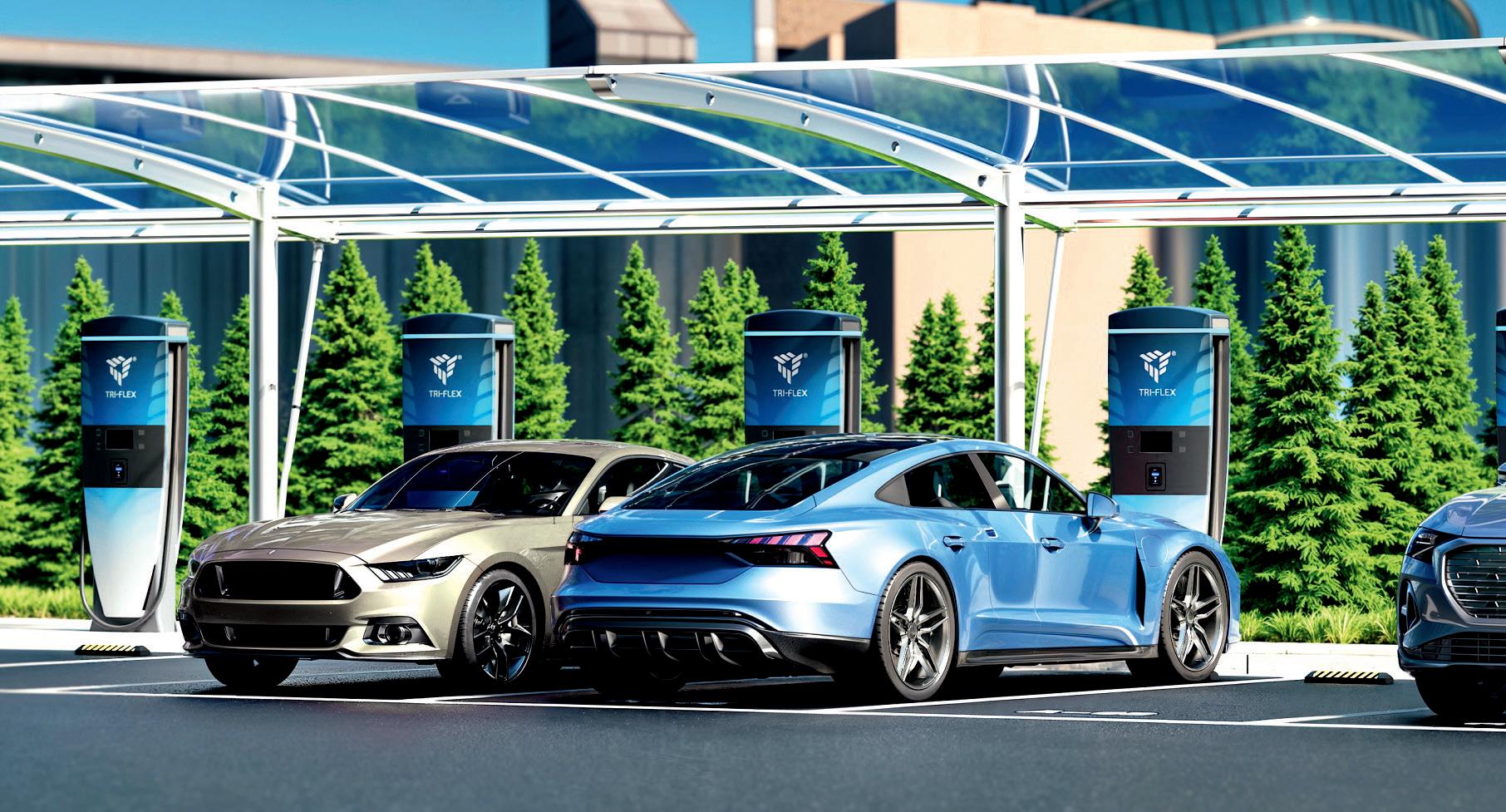





In Europe, they don’t have swipes anymore. All of our credit card readers in Europe and the UK are just tap. And that means the credit card reader is sealed. In the US, we have swipe, [which reads the card’s magnetic strip], and we have dip, [which reads the card’s embedded chip]. at’s mandated, we have to have those. But that means that the device is now open to the elements, and we see much higher failure rates on credit card readers in the US.
Plug & Charge is a very active standard in Europe. We have it turned on with dozens of charge point operators. ere are actually two versions—there’s ISO 15118, which is the standard, and then there’s Hubject, which is a company that has developed a slightly di erent version. We work with both.
Q Charged: Are we lagging behind in Plug & Charge implementation in the US?
A Arcady Sosinov: Oh, way behind. e best thing we have in the States is Autocharge, which is actually very rudimentary. EVgo was the rst one to use Autocharge. All you’re doing is registering the MAC address of your car with the network’s backend, they link it to an account. But it’s insecure, and it’s sort of a hack. Autocharge has to go away, but the issue is that most vehicles on the road today are not Plug & Charge capable.
Q Charged: Teslas in Europe use CCS, not NACS. Why have we gone the opposite way in the States?
A Arcady Sosinov: at’s a great question. ey went with CCS in Europe because the regulators forced them to. ey said, you will not get public funds if you use a proprietary cable, and Tesla switched over.
Technically speaking, NACS is a more elegant standard than CCS. e head of the charging cable can be much smaller. It’s a cleaner design from an engineering standpoint. You pass AC and DC on the same pins (which, technically speaking, was not allowed under UL). CCS has di erent pins for AC and DC. e head is big, and there’s more sheathing in the cable. All that was done because of UL standards. Tesla said, “Forget the UL standards. We’re going to do what we want and they can conform to us.”
I think it would be better for the consumer if the whole
I think it would be better for the consumer if the whole world chose the NACS standard, but that’s just not the direction we went.
world chose the NACS standard, but that’s just not the direction we went. In Europe, they had to switch to CCS to get public dollars. And in the US, they have such a large market share with NACS that you might as well just go in that direction.
Q Charged: It sounds like everything comes back to scale.
A Arcady Sosinov: You need scale on the hardware side and on the operations side. e charging network operators are like the airlines—they have to have scale. It’s actually pretty easy to start an airline, but it’s very hard to become a Delta or a United because you need tons of routes, you need your own service and maintenance teams, and you need to be in bed with your hardware suppliers. ere are only four global suppliers of planes, and the airlines need to know more about those products than even the hardware manufacturers do.
It’s very akin to operating a charging network. You need to have a deep understanding of the hardware. You have to have an incredible engineering team. You have to have your own O&M (operations and maintenance) and service professionals. e chance of you succeeding as a small player in that kind of industry, it’s slim to none.
Q Charged: So, when things consolidate and there are a lot fewer charge point operators, will that make your job easier?
A Arcady Sosinov: Ideally, yes. And those charge point operators won’t deal with only one hardware vendor, just as any major airline will buy both Boeing and Airbus. at’s where this industry has to go. ose of us that know that want it to go there faster.
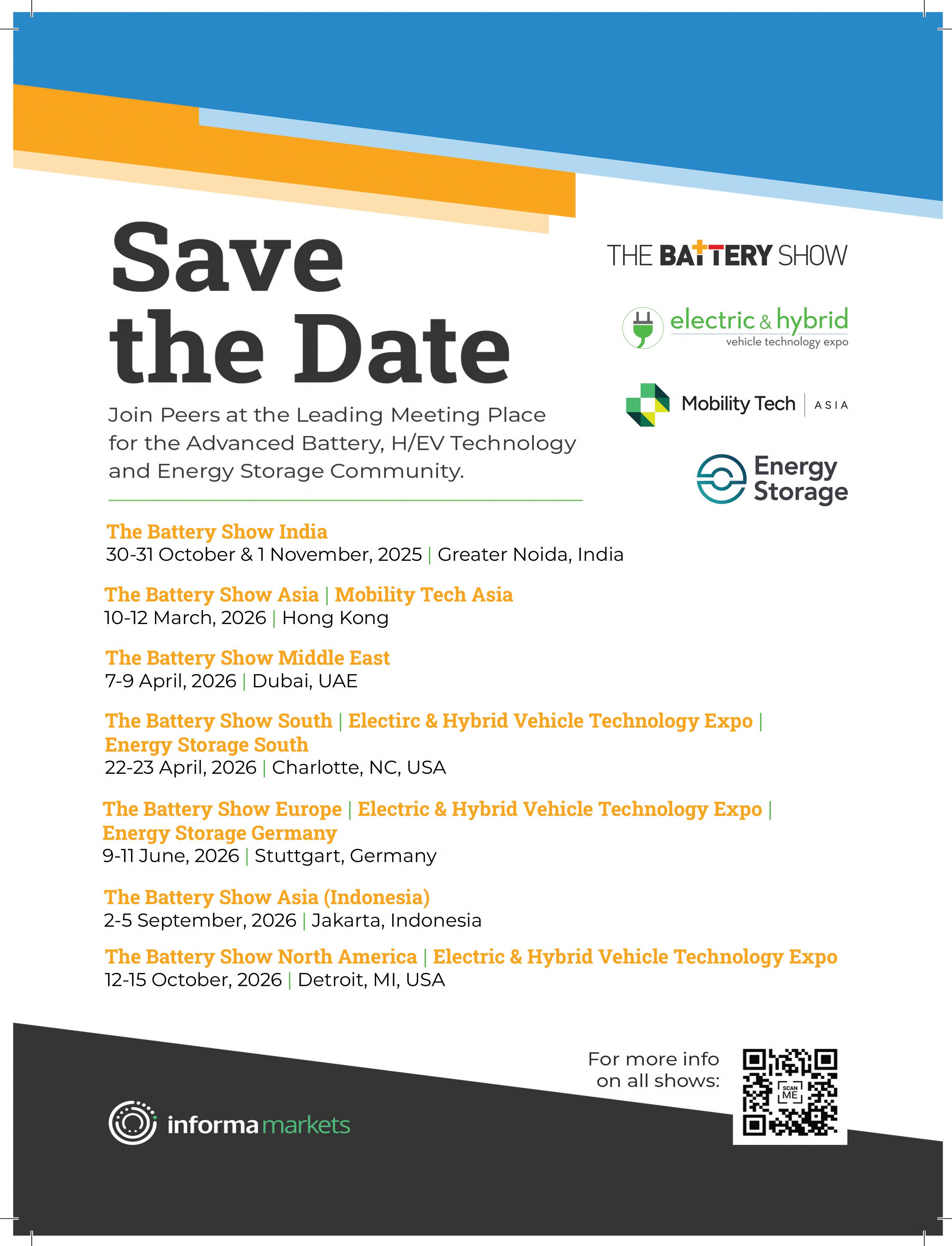
Major technological changes come in waves, and companies that lead the early waves of innovation are seldom the ones that dominate following waves. e same can be true of geographic regions.
On the supply side, the center of EV innovation has shi ed from the US to China, while on the demand side, Europe is leaving us in the dust (sales are up 30% year-todate, compared to 2% in North America). Where will the next wave of EV adoption crest? It may well center on the markets most analysts describe as “Rest of World.” e IEA reports that EV sales in developing countries grew by 60% in 2024. By some estimates, EVs have now reached a market share of 18% in ailand, 27% in Turkey, 40% in Singapore, 60% in Ethiopia, 70% in Nepal, and 71% in Vietnam. (Take all stats cited here with a grain of lithium salt—data for these markets is not always veri able.)
Many developing nations rely on expensive imported oil, and as EVs approach price parity with legacy vehicles, the economic case for electri cation grows. Meanwhile, there’s a strong geopolitical force at work: China is aggressively targeting “secondary markets,” and Chinese automakers have low-priced EVs to o er, while US and European brands do not. (Of course, EVs are only one small part of the Chinese export tsunami, which includes tons of ICE vehicles, among many other products.)
Paths to electri cation in Rest of World will be unlike those in car-dominated North America and Europe. In rapidly urbanizing Latin America, bus networks transport far more passengers than European ones do. ousands of electric buses are already in service in Colombia, Chile, Ecuador and Mexico. Passenger vehicles are also starting to plug in. “By 2024, several South American markets had crossed the 5% threshold for EV sales, a point that has historically signaled the start of rapid adoption,” Michael Barnard writes in CleanTechnica. In 2024, EVs captured 13% of the market in Uruguay, 7% in Colombia, and 6.5% in Brazil. Also worth mentioning: the continent has massive lithium reserves and lots of installed renewable energy (nearly 100% of the grid mix in Uruguay).
Electric buses are also rolling in 10 African countries, including Ethiopia (229 e-buses), Egypt (200), Senegal (150), Morocco (72) and Kenya (24). But in much of the Global South, two- and three-wheeled vehicles rule the roads, and these sectors are rapidly electrifying. In grid-challenged Africa, diesel generators are gradually being replaced by solar microgrids, which provide plenty of power to charge electric motorcycles and tuk-tuks.
Lately, two unlikely-sounding countries have been making headlines in the EV press.
In 2024, Ethiopia banned the import of ICE cars and
By Charles Morris
slashed import taxes on EVs. By the latest estimates, the country now has 100,000 EVs on its roads—just over 8% of the total passenger-car parc. Some 96% of the nation’s electricity comes from hydropower.
Ethiopia isn’t likely to be the next Norway—it only has about one car for every 100 people (in the US, 91% of people own at least one), and only 55% of the population has access to electricity. Energy for Growth calls the country “a test case for what happens when EV ambition outpaces institutional and infrastructural capacity.” So far however, the country’s rapid adoption has surprised the doubters. If EVs can make it here…
In Nepal, EVs have reached a market share of 76% for passenger vehicles and 50% for light commercial vehicles. Dozens of Chinese brands have entered the market, led by the ubiquitous BYD. But, as the New York Times reports, the wave of a ordable EVs is only one factor driving electri cation. A er a 2015 border skirmish with India curtailed oil imports, Nepal’s government invested in hydropower and grid infrastructure, and cut EV import taxes. Nepal’s Electricity Authority has built 62 public charging stations, and estimates that businesses have installed 1,200.
Of course, developing nations face many obstacles on the road to EV utopia. Like most modern technologies, EVs (and all automobiles) depend on a complex stack of support industries that can’t be built overnight. Charging infrastructure, battery supply chains and recycling, solar and wind generation—installing and maintaining all these things requires equipment and expertise that may be lacking in poorer economies. e history of foreign aid provides examples of well-meaning infrastructure initiatives that fell apart a er foreign technicians and foreign funding le the scene. Countries that want to electrify must make local workforce development a top priority.
Fortunately, homegrown EV brands are emerging, including Turkey’s Togg, Argentina’s Tito and Vietnam’s VinFast, which now exports to 11 countries, including the US. In Brazil, Volkswagen is producing electric trucks, and several Chinese automakers are building EV factories. Startups in Africa are building electric motorcycles and rugged electric trucks designed to handle rough roads and charge o -grid. e main obstacle to EV adoption will always be local leadership, just as it is in “advanced” countries. We’ve seen many ambitious electri cation strategies wither a er political or corporate leadership changed. Countries that have rapidly electri ed have invariably had consistent government policy, something that’s in short supply outside of Norway. Nepal (for example) has had three prime ministers in ve years, and pro-EV policies have been watered down with each change of government.






